


























































































TheRoyal Highland and Agricultural Society of Scotland (RHASS)launched the Local Shows Development Fund earlier this year, providing muchneeded support for grassroots regional agricultural shows.

support and promote Scotland's rural communities. It recognises thecontributionregional shows maketo the local economyalongside their value in promotingScotland's rich agricultural heritage.
Approved applications for the
"Regional shows have faced unprecedented difficulties over the past two years, and we are delighted to be in a position to support local shows, helping them get back on their feet.
"We know thatthese eventsare key for communities, so we encourage everyone to attend their local Show as well as marking the Royal Highland Show in the diary. We look forward to seeing a successful show season this summer."
The Local Shows Development Grant will benefit the following shows this summer*:
• Angus Show
• Stirling Show
• Dalrymple Show
• Caithness Show
• Kirriemuir Show
• Sutherland Show
• Banchory Show
• Stranraer Show
• Border Union Show
• East Kilbride Show
• TurriffShow
• Black Isle Show
• Berwickshire County Show
• Dumfries Show
• Lorn Show
• Keith Show
• CunningsburghShow
• Grantown Show
• Orkney Show
• Kinross Show
• TarlandShow
The £30,000 grant aims to help localagrishows across Scotland recover and thrive following significant financial challenges over the past couple of years. The support provides the potential to deliver projects that may have previously felt out of reach, allowing regional shows to plan for a sustainable future.
The grantformsan integral part of RHASS's charitable remit to
2023 fund include the installation of a permanentWiFiconnection within theTurriffShow showground, the fitting of pedestrian barriers around the main ring area of the Stirling Agricultural Show, and improvements to the Kirriemuir Show's education marquee.
David Tennant, Head of Show at RHASS, expressed his enthusiasm for the fund:
The grant will open for applications again this September for the 2024 show season. More information on how to apply will be circulated in the coming months.
For further information about the work of RHASS please visit rhass.org.uk
*Changes to levels of funding and Shows may vary throughout the year.
Responding to Defra's announcement of the next stage in the roll-out of the Environment Land Management (ELM) programme, NFU Vice President David Exwood said: "It's encouraging that the Sustainable Farming Incentive (SFI) for 2023 appears to be an improved, broader and more flexible offer, changes that the NFU has been asking for.
"Farmers and growers will need to take a close look at all the options being made available and consider how

these can be applied on farm. Three of the SFI22 actions are being brought forward with the creation of standalone soil actions, while the introduction of a SFImanagement payment on moorland areas goes further to recognise the role hill farmers play in producing our food and looking after some of our most challenging and iconic farming landscapes.
"We understand Defra intends to offer a 'smooth transition' for over 3000 farmers who joined the SFI22 scheme, which it is closing. We await the detail about what this transition will look like, but
given their early commitment and the lessons learned, these farmers must be treated fairly and rewarded during the transition, should they wish to take up a SFI23 agreement.
"Defra has to get this right. If SFI and the wider ELM scheme is to be successful, it needs to be simple, flexible and provide certainty so there's widespread uptake. It's in all our interests to ensure sustainable, climate-friendly British farming, with farmers being paid to produce highquality food alongside their work in managing and protecting the great British countryside."
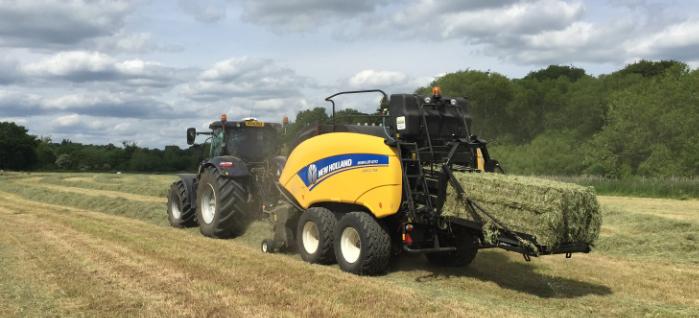
t is the time of year again where hay making is upon us. All the machinery is serviced and ready for work, but it cannot answer the question which raises it head every year –WILL THE WEATHER BE FAVOURABLE. No matter how much money is put into the latest tedders and balers if the hay is to wet to bale it will produce poor quality forage. The most costeffective weather insurance is Baler’s Choice hay preservative. It allows the moisture window to be increased from 0-15% up to 30% moisture with no need for single use plastic and all the disposal and handling issues and cost plastic causes.
Baler’s Choice is the strongest hay preservative on the market form as little as 1.9 litres per tonne up to 22% moisture on round bales and 20% on large square. It has been proven and tested in all grass and straw types. There is no compromise on reliable, repeatable results. Baler’s Choice for hay and straw up to 30% moisture is applied using the latest application
technology available. For those users who do not want to commit to the fully automatic applicator then we off the smaller budget then we offer the PFC Forage Solutions applicator. This is a digital control unit with a 12 litre per minute acid compatible gear pump. Setting the dose per tonne and the machines output the system will apply product reliably. All balers can have the precision moisture meter installed.
Once the crop is baled tarpaulins are the final quality storage solution when shed space is at a premium. With an average life of 5 years and costing as little as £0.45p/bale for a 120x70x240 size. The tarpaulins have many unique features providing a strong and secure fastening system suitable for the UK winter winds. Once secured all stacks will settle so we recommend checking every 3-4 days for the first fortnight then once monthly or before and after strong winds.
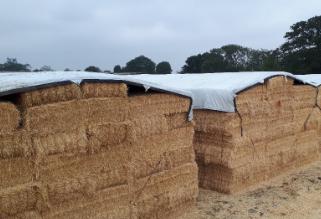
A tight tarp is a secure and longlasting tarp. The super Cinch is an easy way to just pull and secure and pull down and out to release mechanism. For round bales the tarp is secured to ropes placed under the bales during stacking. Large square bale tarps utilise the bottom row twine. The steel J-Hook simply hooks into the bottom twine and allows the side ropes to run through the steel eye. Leaving both ends open allows for any wind to pass through the stack and there is no pressure change under the tarpaulin. Due to the securing mechanism and the manufacturing process of the tarpaulin it provides confidence in the long life of the product. Simply put, secure it, check it and store it for the following year.
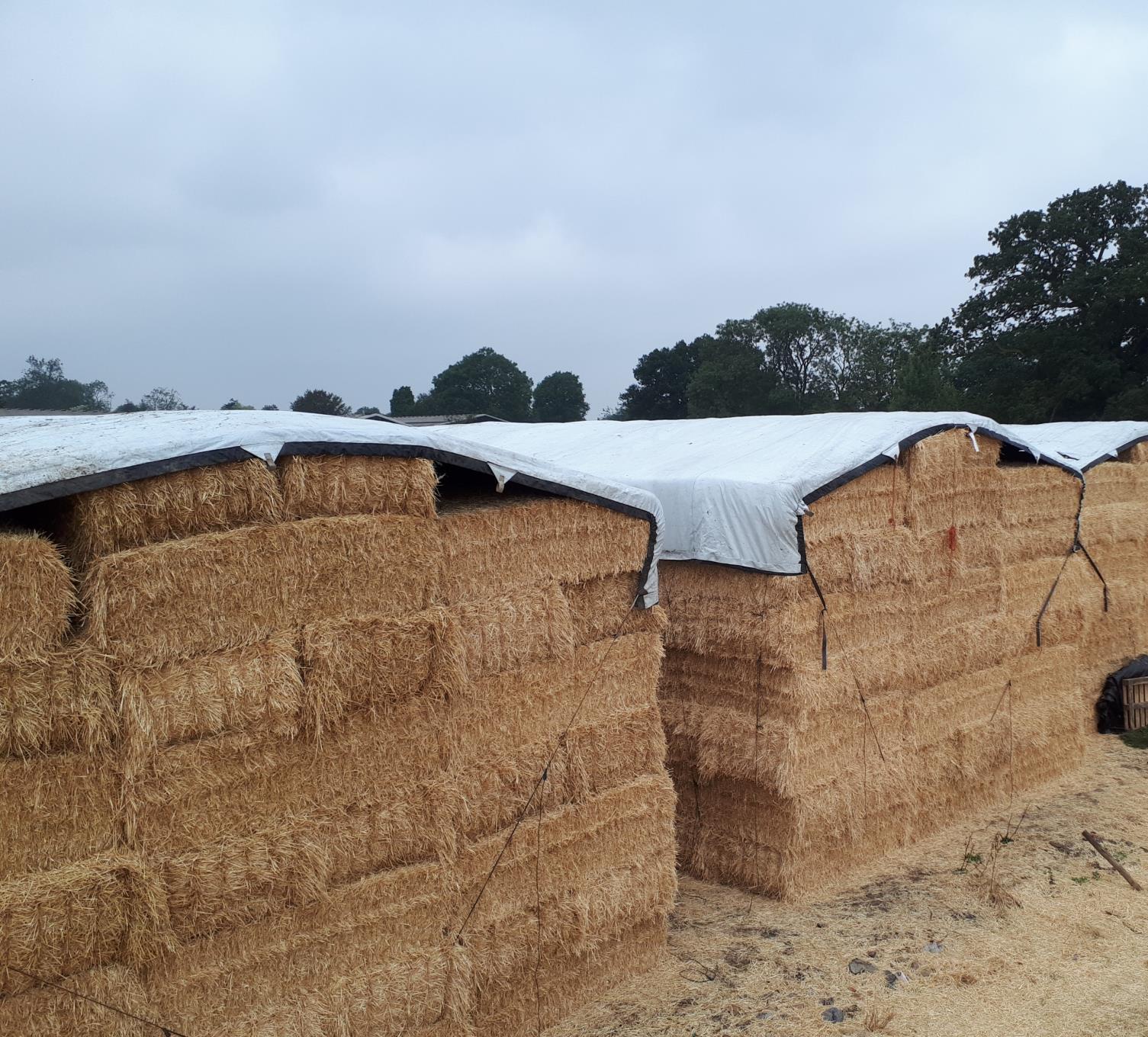
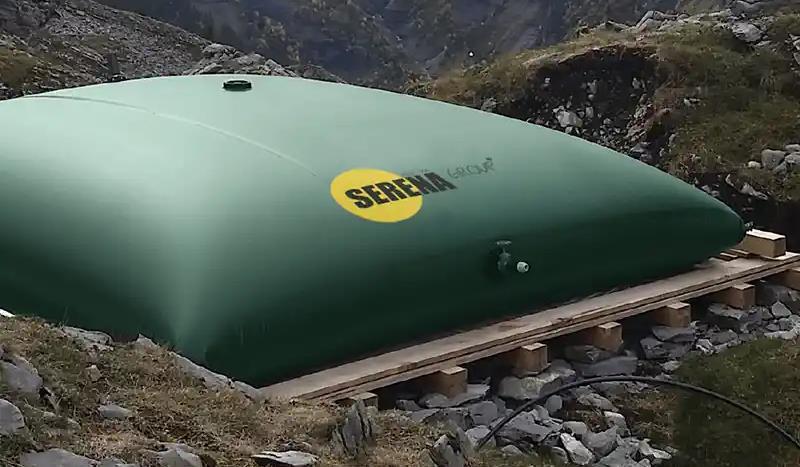


The NFU is taking to social media to launch this year’s #YourHarvest campaign and celebrate the British arable sector’s significant contribution to the nation’s economy and food production.
With combines preparing to roll in the next few weeks, the NFU will be showcasing the 2023
tel: 01724 850224
fax: 01724 289317 sales@neilvessey.com

harvest onTikTokto remind young people of the journey that food takes from farm to fork.
By demonstrating what is happening on farm during harvest, how crops are being used, and how the produce ends up on people's plates, through a series of TikTok videos, the NFU hopes this younger demographic will build a stronger connection with British agriculture and the people who produce their food.
Speaking at the start of this year’sCereals event, NFU combinable crops board chair Matt Culley said: “The NFU is always evolving its content to ensure we are staying relevant - TikTok is a growing part of that mix - and we’re excited to engage with a younger audience in this new way to build a positive connection.
“This year we will highlight the hard work of British arable farmers during harvest by bringing their stories to life through a series of short, fun and informative videos. Farming families will be describing what they are growing in their fields, how technology like GPS helps them harvest efficiently, and even showcasing the journey barley takes as part of the beer-making process.
“It continues to be a tough year for the arable sector with farmers’ experiencing unpredictable farm costs and ongoing market volatility. That’s why this year’s #YourHarvest campaign is more important than ever.
“Over the coming months we will be celebrating all the amazing crops our arable farmers grow such as wheat for your bread or barley for your beer and thanking the public for backing British farming and their continued support in buying locally produced, home grown food.”
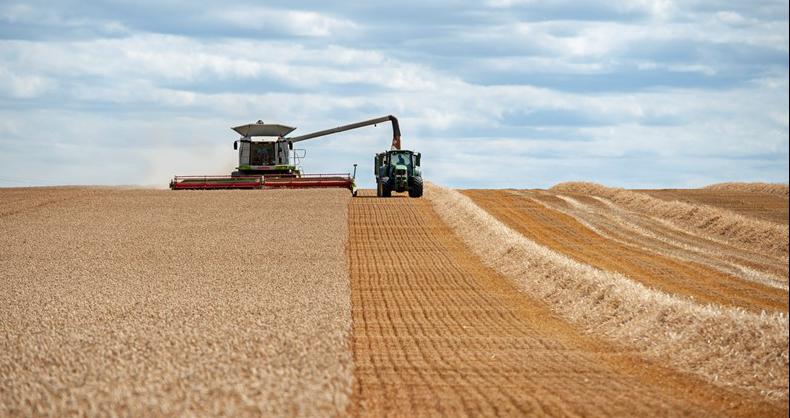

Marking the busiest season for the UK pea industry, Great British Pea Week (3rd-9thof July 2023) returns for its eighth year. With 2 billion 80g portions of peas grown in the UK each year, we’re a nation of pea lovers and Great British Pea Week celebrates the versatile vegetable and its hard-working farmers who bring them to our plates.
An annual celebration that champions the UK pea industry, whose farmers work around the clock each summer to deliver frozen peas to the nation, Great British Pea Week gives the UK a reason to celebrate the little green nutritional wonders during the busy pea harvesting time, inspiring consumers to get creative in the kitchen and ensure peas are their vegetable of choice for everyday cooking. After all, they’re pretty darn versatile – these little green balls of joy can be spread on toast, thrown into a risotto or pasta, popped in a tasty soup or casserole, the choices are endless!
Launched by theYes Peas!campaign, whose recent successful campaign for the ‘pea-moji’ saw the new pea pod emoji released across mobile phone keyboards earlier this year, Great British Pea Week recognises the industry-wide effort made by experts across the pea vining sector during their busiest period, who work hard to produce 2 billion portions of peas for the UK market and beyond each year.
During the eight-week British harvest, farmers work in unison around the clock to harvest, shell and
transport the peas from field to frozen as quickly as possible – with most making it to the factory and through the freezing process in under two and a half hours!
With the average Brit consuming around 9,000 peas a year, the pea harvest is critical in ensuring produce makes it to supermarket shelves to sustain the demand for the full year, with the British pea industry harvesting 160,000 tonnes of frozen peas each year.
Great British Pea Week champions the 700 pea farmers around the country, who work within 16 different grower groups to ensure that Great Britain remains the largest producer and consumer of frozen peas in Europe, maintaining the country’s impressive track record of being 90% self-sufficient in pea production.
Holly Jones, Crop Association Executive at the British Growers Association, which runs the Yes Peas! campaign, comments: “Great British Pea Week is the perfect time to celebrate the versatile vegetable that we all love here in the UK. As a nation, we are 90% self-sufficient in pea production, meaning that nearly all peas in supermarket freezers going into your trolley or online order are most likely grown by British farmers on a British farm, resulting in the superior quality we all love.”
For further information about Great British Pea Week or the Yes Peas! campaign, along with recipe inspiration, please visitwww.peas.org
omedian Al Murray will be the celebrity host of the Free Range Egg Awards 2023, which takes place on 15 November at the Telford International Centre.
Al will bring a night of comedy and his famous Pub Landlord persona to entertain hundreds of egg producers and industry representatives, and then present trophies and prizes to stand-out farmers, food businesses and individuals involved in free range egg production.
“The social and celebratory element of the evening is also being more ambitious, with more guests and a stand-out celebrity host in Al Murray.
“We have worked really hard to make the whole day and night both attractive and affordable for egg producers, who we appreciate will need to take time away from the farm to attend.”
Reflecting the difficult year that producers have had, BFREPA is selling tickets to its producer members for £45 + VAT for attendance to both the show and the awards dinner. Non-member tickets are £100 + VAT.
Dinner includes a welcome drink, three-course meal, and wine, with Al Murray hosting.
Show-only tickets are £15 + VAT but BFREPA members will be refunded the fee at their next renewal, effectively making attendance free for subscribers.
The gala dinner and awards evening is one of the highlights of the calendar. Organised by the British Free Range Egg Producers Association and welcoming the Pullet Hatcheries & Breeders Association, the event is held in partnership with Noble Foods.
This year’s dinner will be the biggest ever and follows the restyled BFREPA Live! show and exhibition which takes place on site during the day.
The whole event is being hosted at a new, larger venue – the Telford International Centre –and is open to members and non-members of BFREPA, and any businesses connected to the sector.

BFREPA Live! gives producers an opportunity to come together and celebrate the industry, as well as reflecting on and finding solutions to the industry’s biggest challenges.
Kate Dickinson, BFREPA’s Events Manager, said: “We want BFREPA Live! to be a completely fresh, modern show which attracts more producers and industry exhibitors to meet each other and discuss the future of egg production.
Nominations for the Free Range Egg Awards are open, with nine categories including producer of the year, national food business of the year, free range champion, and lifetime achievement.

Details on ticket sales and awards nominations are available at www.bfrepa.co.uk, with only eight tables and five stands remaining at the time of writing.
Al Murray has filled arenas around the world as the Pub Landlord, and won numerous awards and accolades, including the Edinburgh Comedy Award and secured Olivier Award nominations for both of his sell-out West End runs.

He has hosted countless TV series, including the acclaimed entertainment chat show Al Murray’s Happy Hour, and Time Gentlemen Please. Al has made multiple appearances on The Royal Variety Performance and hosted Live at the Apollo and Live at the Palladium.
As a writer, Al has also enjoyed great success with his books including Book of British Common Sense, Think Yourself British, Great British Pub Quiz Book, Watching War Films with My Dad and, most recently, Command, which was released in autumn 2022.
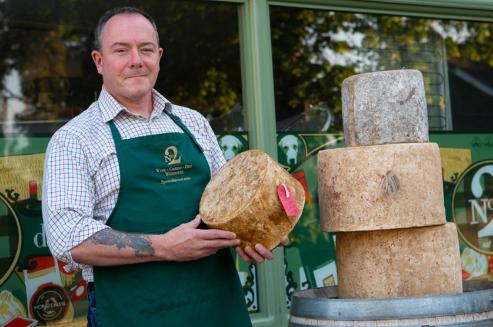
Set to be the biggest cheddar event the world has ever seen, the first edition of the Great British Cheddar Challenge will take place on Saturday 16 September, with tasting boxes now available to reserve. Founded by James Grant of No2 Pound Street in Buckinghamshire, the event was inspired by the cheesemonger's own battle with neck cancer, which resulted in him losing his sense of taste for over a year.
The devastating loss of the restaurateur-turnedcheesemonger's taste sparked a journey of resilience, hope, recovery and inspiration. James determinedly set out to rediscover this careerdefining sense, working towards his Academy of Cheese accreditation and going onto play an important role judging at the World Cheese Awards in Bergamo during 2019, picking out the newly launched Pitchfork Cheddar that went onto take fourth spot overall.
Five years since his original diagnosis, in May 2023 James was informed that he was in remission. With his fully recovered sense of taste and reinvigorated sense of purpose, James has launched the Great British Cheddar Challenge to fly the flag for artisan cheddar and celebrate the nuanced and layered flavour profiles that are being created by cheesemakers across Britain.
Calling for cheese lovers everywhere to get involved, the Great British Cheddar Challenge will see cheesemongers across the country selling tasting boxes of six unlabelled artisan cheddars. These will then be discussed during an online blind tasting event on 16 September, presented by comedian and cheese judge, Marcus Brigstocke, alongside experts from the cheese industry.
The Great British Cheddar Challenge will invite cheese lovers to challenge their perceptions of cheddar. With artisan cheddar accounting for only 3% of cheddar sales in the UK, Marcus and co. will guide viewers through some of the finest examples of artisan cheddar ever made – exploring how the seasons, the grass, the cows, the makers and the
unique microflora in maturing rooms have influenced each truckle – before a People's Choice Award vote to find the nation's favourite cheddar.

James Grant, founder of the Great British Cheddar Challenge and owner of No2 Pound Street, commented: "Cheddar is the nation's undisputed big cheese, but we want to challenge people's palates and perceptions in order to safeguard the future of those making it according to timehonoured principles. While supermarket cheddars seek to satisfy the masses with a generic flavour profile, our artisan cheesemakers are producing incredible and varied wedges using recipes, techniques and cultures going back decades and
even centuries. Having lost my sense of taste for over a year, I know what it's like to be without these magnificent cheeses, so want to do all I can to promote and preserve them for future generations. During the Great British Cheddar Challenge, we'll be inviting the public to wrap their taste buds around cheddars with distinct flavours, aromas, textures and appearances, all a true representation of the land from which they came. We want to raise awareness, sell more cheese and get more people enjoying the best cheddars in the world."
The Great British Cheddar Challenge will take place on Saturday 16 September. Tasting boxes for the online event will be available to purchase for £35 from independent cheesemongers across the country, including No2 Pound Street via2poundstreet.com. The winner of the People's Choice Award will be announced during the Big Cheese Weekender in October.
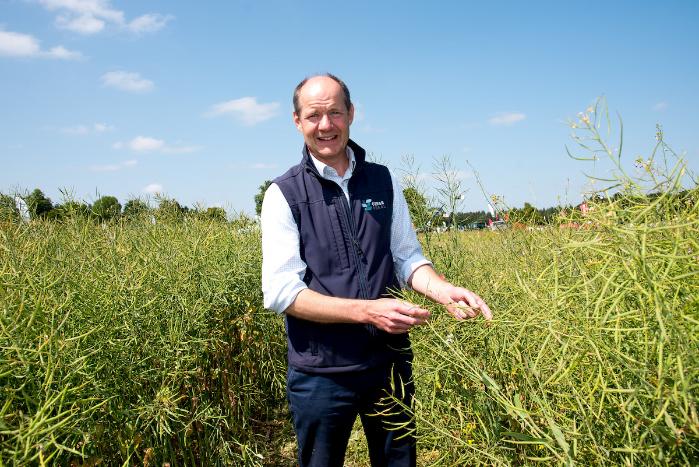
Glorious sunshine welcomed large crowds at one of the Midlands' largest annual agricultural events.
The ninth annualArable Event, held at Weston-Under-Lizard on the Shropshire/Staffordshire border on June 7, was a day packed full of expert demonstrations, specialist talks and technical seminars.
The one-day event was jointly organised by Wynnstay and GrainLink at the Bradford Estates' Woodlands Farm, and included a free moisture clinic, trial crop tours and a guest speaker tent.
Event organiser Kelly Dolphin said: "It was fantastic to see so many people enjoying the fabulous weather. The Arable Event is a great way for people in the farming industry to meet, try out the latest machinery and learn about new trends and innovations. We ran several specialist tours of our trial plots throughout the day which were well received, and early feedback has been really positive."
"The event also included talks from Mark
Tripney of LKAB Calicifert on soil health, Ryan Wooley from Morris Lubricants and Charlie Ireland from Ceres Rural, who has become a well-known face in the farming community."
Charlie added: "It's been brilliant coming out to meet local farmers. Events like this are really important because arable farming is constantly evolving and changing. It's essential to meet up, share experiences and keep up with the latest innovations. It's been fantastic to see such a great turnout."
The day also included guided specialist tours of trial plots planted by Syngenta and Wynnstay. These included a full range of winter and spring wheat, barley and oats in both fungicide treated and untreated scenarios.
All visitors received a free Arable Event goody bag, umbrella, refreshments and a programme, and some lucky visitors won a John Lewis gift card worth £250, an Amazon voucher and meal voucher prizes in an early-bird ticket draw sponsored by Mornflake.Those attending were also able to collect points towards BASIS and NroSO qualifications.
Kelly added: "We're already excited for our celebratory 10thanniversary event next year and look forward to welcoming the crowds back once again!"
Woodlands Farm is part of Bradford Estates and is operated by Bradford Farming LLP, which is establishing the largest regenerative farm in the West Midlands and a centre of farming excellence.
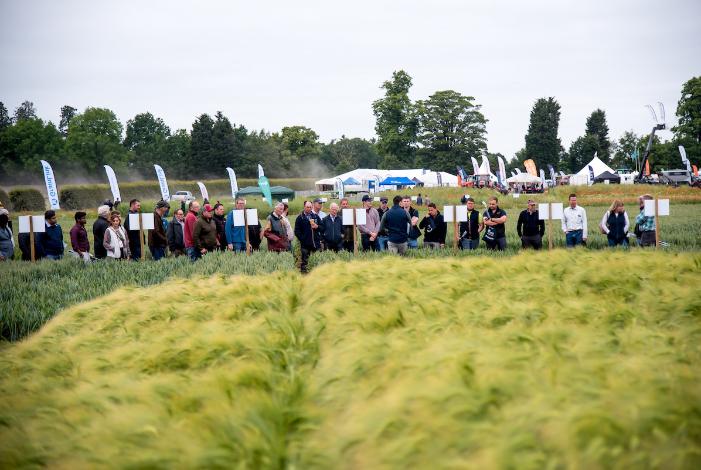

Avolunteer for The Farming Community Network (FCN) charity has been awarded an MBE after decades of service in support of farmers and people living in rural communities.
Suzie Wilkinson, who volunteers with FCN in Somerset, has received her MBE as part of the King’s Birthday Honours, announced today.
Suzie was born in Weston Super Mare and grew up with a deep love of the countryside.
She started working in agriculture in the late 1960s with her husband Charlie, adopting roles in the pig and beef sectors, before taking over a dairy holding as a tenant farmer in the 1980s.
This gave Suzie insights into different types of farming and the unique challenges and pressures involved.
Suzie said: “The experiences of working in a family business, working for different farming companies, eventually running our own business, milking twice daily, and eventually downsizing to prepare for later life and retirement, have given me a realistic insight into different aspects of farming and family life which have helped me develop a greater understanding of ways I can help people in the role I have with FCN now.”
In 1995, Suzie was the pastoral support lead in the Somerset Women’s Farming Union. She joined FCN as a volunteer in the same year – when the charity was founded - back when it was called The Farm Crisis Network.
FCN was a joint venture between the Agricultural Christian Fellowship (ACF) and Germinate: The Arthur Rank Centre. It was founded by Christopher Jones MBE, who sadly passed away in May of this year.
Suzie was asked to be the volunteer coordinator for the FCN Somerset Group, which today has roughly 40 volunteers actively supporting local farmers in the county.
FCN volunteers ‘speak the language’ of farming and have invaluable experience of farming life and its unique pressures.
Suzie and her fellow FCN volunteers have provided vital support to farmers through daily challenges and stresses, as well as through devastating crises
in agriculture – including through Swine Flu, BSE, Foot-and-Mouth and the Somerset Levels floods.
It is thanks to her role with FCN helping farmers and looking after the welfare of other volunteers, and the support of her husband Charlie, that Suzie has been able to achieve what she has today.
During her time with the charity Suzie has listened to the challenges faced by over 650 farmers – and in her role as an FCN volunteer has ‘walked with’ them to help them find a positive way forward through any issues faced.
Suzie said: “Farming is a unique way of life because everything is tied up on the farm. It is your livelihood and business, your daily work routine, your identity and lifestyle. For many it can be seen as idyllic, but it can also be very isolating and lonely – and sometimes farmers even feel pushed away from society.
“Our role in FCN is so simple yet so powerful. Some people have never been listened to - but talking to someone in confidence, who is non-judgemental and has empathy and respect, can be a lifechanging experience. We build up trust with farmers so when times get tough and they need someone who really cares on their side, they can ring us for support. Sometimes this could be the difference between life and death.”
Suzie was recently made an Associate of the Royal Agricultural Society in further recognition of her hard work.
She has now stepped down from her role as coordinator of the FCN Somerset Group but continues to volunteer with the charity, supporting many farming families each month and sharing her experience with other volunteers.
Jude McCann, Chief Executive Officer of The Farming Community Network, said: “FCN is delighted that Suzie has received an MBE for her decades of service in support of the charity and the farming community whom we serve. Suzie’s knowledge, experience and empathy has helped countless farmers and farming families through difficult times and periods of stress. She embodies the vital role of FCN volunteers ‘walking with’ and supporting farming people. We are fortunate that Suzie continues to volunteer with the charity after all these years, passing on her knowledge to the next generation.”

We were delighted to have so many of our Love Local Trust Local family attending Open Farm last Sunday. From our wonderful sponsors to many brilliant Dorset producers, it truly was a family affair. It’s a great achievement to turn a celebration of British farming into a full celebration of Dorset food and what is grown, produced, reared, brewed, crafted, and cooked here in our home county. We’re very thankful for them all taking some of their busy time to come and support us on our year to host Open Farm Sunday.
We haven’t hosted this event since 2018 due to
the pandemic so were expecting a high number of visitors and we were not disappointed! The number of people through the gates learning all about farming and where their food comes from was a great success. Any opportunity to get people supporting and buying local is a win in our books!
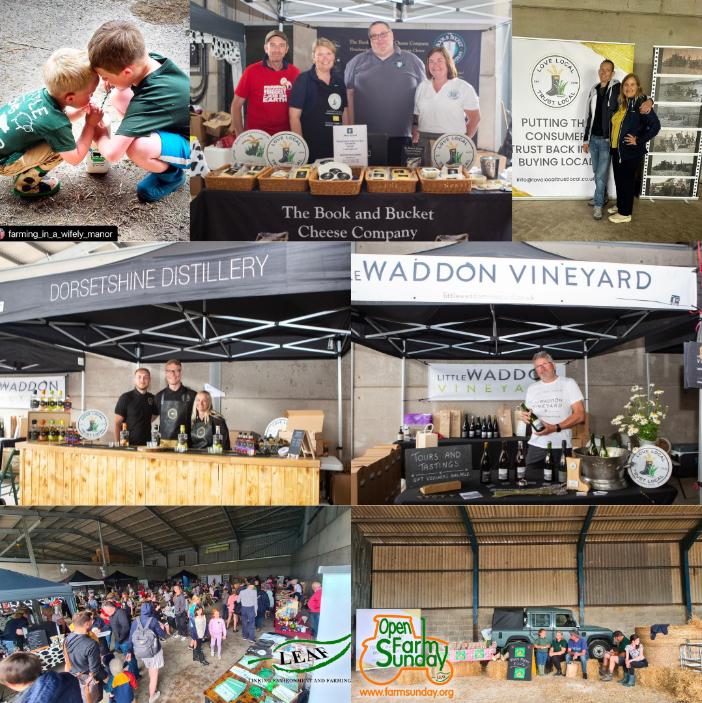
Love Local Trust Local
www.lovelocaltrustlocalawards.co.uk
Rawston Farm Butchery
www.rawstonfarmbutchery.co.uk
The Langton Arms
www.thelangtonarms.co.uk
The family behind Highfield Farm at Cadwell in the Lincolnshire Wolds is celebrating a hundred years on their working farm with the launch of a new luxury glamping venture.

Five generations of the Grant family have run the farm since 1923, beginning with businessman and potato merchant, William Spray.
Now, the family have launched their first new business on the farm, Wold of Your Own, which offers an amazing double-decker bus glamping retreat.
Fifth-generation farmer, Mathew Grant said:
"It is very humbling to think that I'm following in the footsteps of my father, my father's father, my father's father's father and my father's father's father's father. There's a great deal of history in this
land and it is an amazing achievement to have kept this family business going for so long. Through wars, crises and pandemics, we've grown food for the nation and we're not stopping any time soon.
"We're starting our next century on Highfield Farm with the launch of an exciting new glamping venture which starts with our phenomenal pair of converted double-decker buses which I'm extraordinarily proud of. We're also increasing our focus on nature conservation and sustainability to give back to the land that's supported us."
Having developed a successful business as a potato merchant, William Spray purchased Highfield Farm to farm potatoes which he sold, alongside cooking fat and Grimsby fish, to fish and chip shops around Lincolnshire.
In the 1930s, an area of Highfield Farm was sold to ultimately become Cadwell Park Race Circuit. At its
height, the farm employed more than 30 people, growing potatoes, peas and malting barley while rearing livestock including sheep, cows, pigs and chickens.
The farm even has a runway which was built for crop spraying and this is often used today by racers visiting Cadwell Park, including 'Rocket Ron' Ron Haslam, Steve Parish and commentators Jamie Whitham and Matt Roberts.
Having modernised with GPS mapping and digital recording in the 1990s, the farm has continued to diversify as the family invests in nature recovery, the establishment of new woodland, and sustainable farming practices. Now, they're going further with the launch of Wold of your Own.
Mathew's father, fourth-generation farmer Peter Grant said:
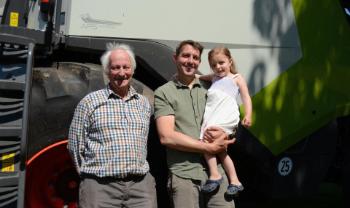
"This farm is our home and it's also our family business so it's an emotional moment to celebrate 100 years here. When I started properly working on the farm, it was my job to calve the 220 strong herd of Hereford cows and to spray the arable crops. My wife and I lived here and our children were born here, just as I was. Our farm has changed a lot during my life; we've embraced technology and science, we've diversified and we've taken great care over the land we call home. I'm very proud to have played my part in running Highfield Farm and of my son and daughter-in-law who are doing the same."
The family's first glamping retreat, made out of two double-decker buses, is now ready to welcome guests. Perfect for stargazers and surrounded by mature trees, conservation mix fields, lakes and native wildlife, Double-Deckerdence is a jaw dropping feat of large-scale recycling that even featured on the Quest TV show Full Metal Junkies.


Sleeping six, guests can literally climb into bed along an interior climbing wall, get comfy in the driving seat and stargaze from an outdoor jacuzzi on the top deck.
The venture is a result of the family's long-standing love of the Lincolnshire Wolds AONB as well as their passion for sustainability and their appreciation for the natural environment.
For more information about the family's glamping business, Wold of Your Own, please visit www. woldofyourown.co.uk

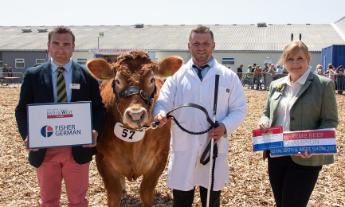
ompetition was strong as beef cattle kick-started the interbreed championships at the Royal Bath & West Show.

Under the respected and sharp eye of judge Mary Cormack, the penultimate Native and Continental Interbreed Championships took place before she tapped out her Interbreed Supreme Champion. Scooping Breed Champion and Best Native, British Limousin – two-year-old in-calf heifer, Dinmore Solovely - went on to take Supreme Champion as well, with Ms Cormack commenting on her presence in the ring.
“She was very good on parade and an excellent example of the breed; well balanced with a nice natural width across the shoulder and down the back, to a well-rounded tail.”
Purchased at 11 months old from Paul Dawes’ Dinmore herd in Hereford, the heifer now resides with Adam Smith and his parentsTony and Jo - near Bude, Cornwall. They also took Breed Champion with their three-year-old Beef Shorthorn cow, Oceanview Perfection, for the second consecutive year.
Dinmore Solovely is sired by the Smith’s stock bull – Dinmore Orly – from purchased semen –and is out of the impressive dam, Dinmore Mylovely. “Her mother’s bloodline can be traced back to a well-respected Irish family and their 36,000gn cow, Carmorn Voney,” said Mr Smith.
And the heifer’s lineage shines through with her success. “Last year she took reserve Intermediate Champion at the National
Limousin Show and we were thrilled. But this is our first Interbreed Supreme Champion at a major show,” enthused Mr Smith.
“We’re delighted and it makes all the hard work worthwhile.”
The heifer will be at the Royal Cornwall Show before taking the summer off in preparation for her first calving.
Competition was strong, with Reserve Champion going to the Bowendu herd’s threeyear-old Hereford bull, Solpoll 1 Trailblazer. “He’s a super young bull with exceptional quality,” said Ms Cormack. “He has clean legs and good movement with a great showman.”
The accolade was not lost on Adam Bowen, who started his Bowendu herd at Tydu Farm in South Wales in 2016 with an in-calf heifer and a cow and calf at foot from Dendor Herefords. Today his pedigree herd is 30-head strong.
“I’m just over the moon with his success today,” he said. “It’s his first show this season and he’s taken Male and Breed Champion –and yes we would have liked Supreme Champion, but we’ll save that for another day.”
Out of Solitude 1 Duchess P946 and sired by Solpoll 1 Promotor, Trailblazer was purchased by the Bowen family at 14 months old. Now due his third crop of progeny, his homebred daughter Bowendu 1 Ruby 2nd, born in January 2022, is showing promise and had her own Royal Bath & West success, taking Female Breed Champion.
Friday (2 June) was the big day for the interbreed championships across the other
three livestock sections – dairy, sheep and pigs.
First up was the dairy individual interbreed championship. Judge Linda Batty said this year’s final was a tough call with one of the finest fields of cows on display that she had judged for a long time.
After much deliberation the coveted Supreme Champion title went to Les and Tracy Rockett’s eight-year-old Ayrshire, Greenaway Ross Great Jubilee, sired by Easterchurch Ross and bred by the exhibitors.
Now in her fifth lactation and yielding 35kg, Greenaway Ross’s win came as something of a surprise for the Rockett family.
“She’s a fantastic cow and one of our favourites – but we only brought her along for the ride really,” said Les and Tracy’s daughter, Abi.
“In fact, she’s one of the ‘grandmas’ of the herd and we’re absolutely delighted that she had it in her to win against some very stiff competition.”
Now as the proud owner of the Bath & West’s Supreme Championship sash, Greenaway Ross will be doing a tour of county one-day shows this season instead of grazing at the Rockett family’s Ebsworthy MoorFarm, near Okehampton in Devon.
It was a very successful show for the Rockett family, who were also the runners-up in the interbreed pairs award and took a string of class wins.
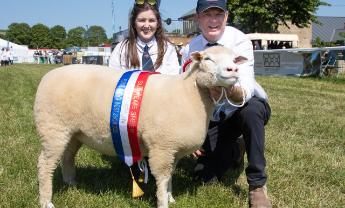
Reserve champion was awarded to Berryholme Lighthouse Flo, a Holstein from Kevin and Sian Rickard’s Starlet herd, from Newport in South Wales. Judge, Linda Batty said Berryholme was a fine cow which could well be worthy of first-place awards in future years.
In the sheep lines, a huge entry of over 1,700 gave the judges a difficult task to select the
outstanding entries. Picking the Interbreed Champion, judge Henry Doveman said the standard of entries was remarkably high, before announcing the winner: Robert Hole’s Dorset Horn and Poll Dorset shearling ewe, Eucalyptus.
“She’s a typical example of our flock, lovely looks, and stands very firm – and she just looked like a winner on the day,” said Mr Hole, of Hillstreet Farm, Sherborne in Dorset.
“We’ve been showing our Dorset Horn and Poll Dorsets here for over 40 years and to win the Interbreed Championship is a life-long dream come true.” Robert and his daughter, Sophie, are pictured with Eucalyptus in the Grand Parade.
Reserve spot was given to 13-year-old Harry Stamp’s Dorset Down ram lamb, from the Bowbridge Flock from Highbridge in Somerset. In the pig section, the Interbreed Supreme Champion was awarded to Duroc boar, Hazeway Clyde.
The 10-month-old boar, sired by Deerpark Clyde, was bred by the exhibitor, Hayley Loveless from Bridport in Dorset.
It was the boar’s first outing in the show ring, and the win delighted Hayley.
“You never know what will happen when you put a pig into the ring for the first time – so winning the championship is fantastic for us,” she said.
Deerpark Clyde will be trying his luck in the ring through the summer, including at the Royal Cornwall and Great Yorkshire Shows.
Judge Paul Churchyard placed a Large Black, Sock Doreen 254, as Reserve winner, after careful consideration of what he described as ‘a very high quality and impressive entry’. The 10-month-old gilt was sired by Addison
Malcolm 5, from Sock Doreen 236 and bred by the exhibitor, Martin Snell of Yeovil.

The winners of this year'sRoyal Highland and Agricultural Society of Scotland (RHASS)Sir William Young Award, Dochy Ormiston (MVO) and Sylvia Ormiston (MVO), were today presented with their award by HRH Princess Anne and RHASS Chairman Jim Warnock, at this year's Royal Highland Show.

Awarded annually, the Sir William Young Award recognises exceptional contributions to the world of livestock breeding and celebrates the enduring legacy of the late Sir William Young, whose invaluable service to Scottish agriculture continues to inspire.
the helm of the Highland Pony Stud in 2007, building upon its legacy since the registration of the first Balmoral Highland Pony in 1979. Balmoral Stud has shown ponies over the years with much success showing in hand and under saddle.
The Estate are firm supporters of working harness classes, having won twice back-to-back at Scone game fair, as well as helping the Game Fair by doing working harness demonstrations for the public visitors. They have won the harness class on many occasions at the Royal Highland Show and attended this as often as possible over the years.
Sylvia has faced and triumphed over adversity, notably navigating the loss of five ponies, including two breeding stallions, to Equine Grass Sickness in 2017/18. This unfortunate event highlighted the importance of collecting and freezing stallion semen at a young age to mitigate potential future losses.
Sylvia's contributions extend beyond breeding, as she collaborated with the support of Her Majesty to develop a new style of working pony saddle and girth that is now widely used across other estates. Currently serving as the President of the Highland Pony Society and renowned as a respected judge, Sylvia continues to leave an indelible mark in her field, inspiring and uplifting others along the way.
The award was proudly presented by the late Queen's daughter, HRH Princess Anne, a dedicated patron of equine charities across the country.
Dochy and Sylvia have respectively overseen the Balmoral Highland Cattle Fold and Highland Pony Stud since 2007, seeing huge success during their time at Balmoral Estate.
The Ormistons were invited to Balmoral and entrusted with bringing order to the existing breeding programs and establishing the Balmoral Highland Pony Stud.
The Highland Cattle Fold, founded in 1952 by Her Majesty The Queen, boasts a herd of 50 calving cows and followers. These cattle have topped the lists at every major show and sale, including the Royal Highland Show, where they won with a homebred bull, Gusgurlach of Balmoral, as a 2 and 3 year old - the first time this has been done. In addition to his role as a Trustee on the Highland Cattle Society, Dochy actively contributes to the breed's development committee and has earned acclaim as a distinguished judge, presiding over competitions nationwide and internationally.
With the encouragement of Her Majesty, Sylvia took
Upon receiving news of their win, Dochy Ormiston remarked, "We are so delighted to be recognised for our contributions and remain committed to preserving and advancing these remarkable breeds."
Sylvia added: "We are so passionate about the preservation and improvement of the Highland breeds, and it is an honour to be recognised in this way by RHASS and made all the more special to be presented with it by Princess Anne herself."
Jim Warnock, Chairman of RHASS, extended his congratulations to the pair, stating,
"Dochy and Sylvia have left a permanent mark in the world of Highland Cattle and Highland Pony breeding. Their dedication and commitment to excellence have made them worthy recipients of the Sir William Young Award and all at RHASS extend our huge congratulations.
"They have set a shining example for future breeders, and I have no doubt that they will continue to be great ambassadors for their breeds."
BillGray,63,Farm and Estate Manager
atPreston Hall and Past Chair of the Royal Highland and Agricultural Society of Scotland (RHASS) has been awarded aMember of the Order of the British Empire(MBE) byHis Majesty,King Charles.

Awarded foroutstanding service to agriculture,charity and the communityin Scotland,Billserved for three years asRHASSChairman,notably during the Covid pandemic whenhe successfullyled the charity through the challenges of cancelledRoyal Highland Shows, subsequent loss of revenue,and the return of the fullShow in 2022.
Bill joinedtheRHASS board in 2006 as a directorfor the Lothian regionand was elected to the Chair in 2019.
Commenting on his award,BillGraypaid tribute to the 'incredible people'he has worked with andwho havesupported him throughout his career.
"I am incredibly honoured and humbled to receive this accolade." Bill said.
"My three years as Chairman of the Society were marked by the onset and the duration of the Covid pandemic–one of the most challenging times in the Society's239-yearhistory.
"With the support of the dedicated RHASS team and directors we returned as astronger,more resilientcharity,and I am immensely proud to have held the position of Chair during this challenging time.
"Throughout my career I have been fortunate to work for those whohad the foresight to recognise the benefitofhaving a manager with additional networks outside the farm.This has allowed me to support other organisations in the agricultural sector which has been hugely rewarding.
"Finally, I must pay tribute to my family for theirlove and support formypast endeavours and forwhatever I decideto turn to next! This award is shared with all of you."
CurrentlyFarm and Estate Manager for the Callander family at Preston Hall since 1994, Bill was born and brought up in Belfast. He waseducated at Campbell College, Belfast and at West of Scotland Agricultural College, Ayr.
Billis married toJanie,has one daughter andthreegrandchildren.
Agtech company Agreena, whose soil carbon platform is the largest in Europe operating in 16 countries and developed to help farmers finance their transition to regenerative practices, today announced the results of its second harvest year (HY) and second annual early payout to participating European farmers. The number of hectares enrolled grew 10X over the previous year and farmer participation increased 4X. Agreena is paying the largest incentives to farmers under a soil carbon scheme to-date at €32 to €36 per anticipated carbon certificate generated depending on region, an increase of up to 45% from last year. The company is a pioneer in creating nature-based soil carbon removals. The associated certificates will soon be available on the market for companies that want to participate in the transition of the world’s farmers to practices that help address climate change, biodiversity loss and the future of food security.
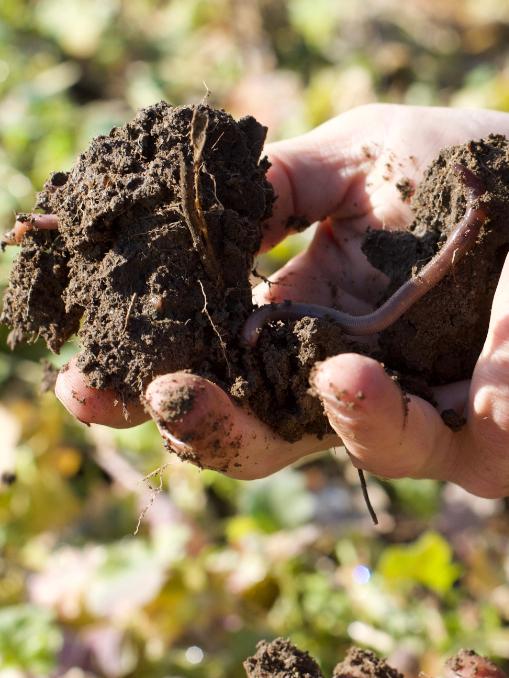
While carbon sequestration in agriculture has been identified as one of the top solutions to scale climate action because of its accessibility and the immediate impact it can have, the primary hurdle to adoption is the high upfront costs for farmers. By leveraging the voluntary carbon market (VCM) to convert climatefriendly farming efforts into highquality carbon certificates, Agreena is driving a new revenue stream to the farmer. Farmers are seeing the benefit too. Twenty percent of the year-on-year hectare growth in Agreena’s portfolio came from member farmers adding more land to the program.
“Agreena is introducing a new category of carbon certificates into the market and it will take time to build and scale, but farmers cannot wait - they need a reliable and liquid payment to help cover their transition efforts,” said Simon Haldrup, CEO of Agreena. “That is why Agreena takes a calculated
risk and pays farmers each harvest year. Still, carbon certificates are just one part of the solution and a mix of incentives is needed to rapidly transition the world’s farmers to regenerative practices.”
Farmers and the companies that rely on carbon certificates for their ESG and sustainability efforts are on different timelines. Sales of credits can take a year or longer to occur after the impact has been certified. Agreena’s early payout option for farmers bridges the gap between the two. Farmers enrolled
in Agreena’s program get to decide how they’d like to use the certificates that they generate, and one of those options is to be paid soon after the harvest year ends to help cover their upfront costs. The early payout is based on market prices at the time. Growth of the Voluntary Carbon Market and pricing for high-quality carbon certificates continue to grow, any upside when Agreena’s certificates are sold is shared with the farmer.
Agreena’s carbon certificates are the result of farmers taking measures to sequester additional
carbon from the atmosphere within their soils and at the same time reduce their own emissions through practices like no till. The company has developed a highly credible programme that is in alignment with the latest IPCC science and the recognised principles of the VCM, and built relationships with agricultural partners and farmers across Europe.

More recently Agreena has developed its corporate unit that oversees certificate sales, and MRV and risk solutions. Agreena works with certificate buyers to tailor, structure and scale portfolios from across the company’s inventory, modelled after assets already sold and traded in traditional financial markets.
“Our first vintage of high quality carbon certificates originates from farmers in Central Europe and has just been made available for a limited quantity presale,” said Frederik Aagaard, Agreena’s Director of Carbon Markets. “We’re delighted to be able to facilitate the participation of companies in helping finance this journey for farmers.”
The deadline for enrolling in Agreena’s 2023 programme is quickly approaching. Farmers have until June 30 to enter this year’s harvest, and can calculate their earning potential and apply by completing this form on Agreena’s website. More information about the programme and how it works can be found here.
Agreena anticipates that as the VCM continues to grow and evolve, the market will see continued developments related to certification and new standards in the space. Agreena’s portfolio of GHG reduction and carbon removal certificates are accredited to the ISO 14064-2 standard and are currently undergoing Verra VCS certification. The outcome is anticipated before the end of the year.
With the wet weather in May causing a ‘perfect storm’ for Septoria in arable crops, Nelson winter wheat is proving its worth with high disease resistance.
Recent independent Agrii trials have shown that it outperforms other leading varieties for Septoria tritici resistance with the cleanest, lowest score of all varieties tested.
He also grows winter milling wheat, winter barley and winter beans, as well as spring cereals as and when he can, to help to combat blackgrass.
“Last year we grew 16 hectares of Nelson and this year we are growing 52.5 hectares,” says Nigel.
“Nelson is not known to be high yielding but last year we got 9.8 tonnes to the hectare sold. It didn’t quite reach the spec for the premium over group one at 14% protein, but it managed 13% protein and got a group one premium with Heygates millers,” he says.
“We’ve found that a real benefit with Nelson is its disease resistance. We have used 20% less inputs on Nelson than other varieties and we probably could have used even less.
“From my own observation, we reduced the seed rate of Nelson, so it’s around 15% less than the other varieties we grow, and it’s early in terms of the spray programme and the harvest – I’d say around two to three days ahead of anything else, it also tillers well,” adds Nigel.
Lincolnshire-based farmer Andrew Daubney is producing high grade Nelson seed on his family farm at home alongside his full-time post working in the seed production industry.

“We’re growing Nelson for the first time this year. It established well, it’s vigorous, clean, and the ears look good on it,” says Andrew.
Unlike the recommended list, in private trials, the lower the score, the better the variety is performing. Nelson scored a 2 for Septoria tritici resistance and a 1 for yellow rust at Agrii crop stage 42 of the trials, on 24th May 2023. While other top performing varieties matched Nelson’s yellow rust score, all named lines didn’t perform as well for Septoria tritici resistance. KWS Extase scored 4, KWS Dawsum scored 3 and LG Skyscraper scored 5.

Bedfordshire farmer Nigel Barnes farms approximately 800 hectares of arable crops, 560 hectares of which is contract farmed, and has grown Nelson for the last two years.
“We also pulled back on nitrogen and rather than applying 220 kg/ha we’re putting on 190 kg/ha, on the advice of seed supplier Cope Seeds and Grain. I’m looking forward to getting the combine in there to see what it does,” he says.
Gemma Clarke at Cope Seeds and Grain is looking for Nelson growers right now for harvest 2024. “With demand for UK grown milling wheats on the up, we’ve got buy back contacts with premiums over group one milling wheat on contract to Heygates millers,” says Gemma.
To learn more about Nelson winter wheat, visit https://copeseeds.co.uk/products/exclusivevarieties/nelson-winter-wheat/
Following wet and cold conditions this spring, milling wheat crops are likely to be struggling with nutritional deficiencies and will benefit from foliar nutrition applications from T2 to meet the highest premiums.

Mr Bond explains that both magnesium and sulphur are vital for building protein. Sulphur in particular helps create amino acid chains, the building blocks for protein.
“In addition, sulphur helps maximise nitrogen use efficiency, which can be very helpful especially with current high input costs. Magnesium is also important for the transport of nitrogen and helps extend the grain fill period,” he says.
In light of this, Mr Bond stresses the importance of foliar applications of magnesium and sulphur this spring.
“Growers can make applications of Prince® which contains magnesium nitrate, or Thio-S™ which contains sulphur and nitrogen, from T2 onwards to support wheat development.

Chris Bond, Product Manager for crop nutrition at FMC, says magnesium and sulphur may have leached from soils, and this could put milling wheat crops at risk of not reaching the 13% protein requirement for the best prices.
“In the last month, FMC have received over 180 samples from growers for tissue testing and 82% are showing a below optimum level of magnesium,” he says.
“When looking at sulphur, just short of 50% of samples are showing a below optimum level of deficiency.”
“The benefit of using a foliar formulation is that it enables the crop to take up the nutrients much quicker,” he adds.
“This season it will be key for growers to do all that they can to reach wheat premiums and deliver high yields, particularly as the season has thrown many challenges. Foliar nutrition is a great way to ensure crops develop robustly all the way to harvest,” he says.
To find out more about foliar nutrition for wheat premiums, speak to your agronomist or visit https://fmc-agro.co.uk/

The award winning company grows a special variety of broccoli designed to help the nation age well by eating its research-based 'super soup'.
The Smarter Food company, who trade under the brand nameSmarterNaturally, is a science and research led business, providing a key differentiator to many others in the market offering health foods.

The company used to grow most of its crop in Lincolnshire but is now concentrating on growers in Cupar, Fife.
The east of Scotland farmers are renowned as major brassica growers and have a stable supply of labour.
As the popularity of the broccoli super soup grows they need a source which can cope with increased demand and supply the raw product which is freeze dried and used as a whole vegetable in the SmarterNaturally soup.
The East of Scotland farmers meet all their requirements and will focus production there in the coming years.
A SmarterNaturally spokesperson said: "We are pleased with how the Scottish farms produce our special type of brassica and they have the experience and knowledge to meet all our company's requirements. We are very confident they will handle any increase in demand in the coming months and years."
The soup is made from a special variety of super strength broccoli that could help people who are looking to lower their blood sugar – a key risk factor for type-2 diabetes – one of the greatest challenges facing the modern NHSand as well as a range of other age-related chronic diseases.
While tackling diabetes is their first target, the company has far bigger ambitions for this new Super Soup including supporting men who are at risk of developing prostate cancer and enabling people to age gracefully by helping them stay in good health for longer.
Smarter Food CEO Laura Knight said: "Getting this soup to market to help tackle high blood sugar is just the first step. There is a large and growing body of high-quality published research that glucoraphanin may also help to lower cholesterol and blood pressure, as well as having a positive impact on various types of cancer, including prostate and breast cancer. With the potential to benefit so many individuals, prevent disease and alleviate pressure from our over-stretched healthcare system, we're excited about the possibilities this could unlock."
The benefits of broccoli have been gaining traction as a super-food, but not all broccoli varieties are the same.

This new, unique variety of broccoli is called GRextra and makes the soup special with its very high levels of a health-boosting molecule called glucoraphanin. Once in our gut, this molecule's active form (called sulforaphane) turns on anti-oxidant genes in our cells, which can help maintain a healthier metabolism – particularly as we age.
Smarter Foods is a spin-out from one of the UK's leading food and health research organisations,Quadram Institute, with science funded by UK taxpayers. Company data has shown that when its unique broccoli (which is naturally rich in the health-boosting compound glucoraphanin) is incorporated into a soup, eating just one bowl a week can help lower elevated blood glucose and maintain it over time.
Once ingested and activated in our body, glucoraphanin turns on a natural genetic antioxidant pathway (called NRF2) in our cells, which reverses this shift and helps to repair our ageing metabolism. Therefore, scientists believe that eating a large quantity of glucoraphanin on a regular basis can help keep your metabolism working more efficiently for longer, thereby reducing your risk and delaying the onset of a range of chronic conditions traditionally associated with ageing.

A healthier, younger metabolism is linked to all kinds of health benefits, including, lower blood pressure, protection against heart disease and reduced risk of some forms of cancer. But for now, SmarterNaturally are focussing on supporting people with high blood sugar levels.
The soup was developed by scientists at the Quadrum Institute, a centre for food and health research that combines the Norfolk and Norwich University Hospitals' endoscopy centre and the University of East Anglia's Norwich Medical School.
Lead scientist for SmarterNaturally, Professor Richard Mithen, said:
"SmarterNaturally Soup aims to help keep our metabolism young. Research suggests that eating one bowl a week could deliver enough glucoraphanin and other healthy nutrients to help people maintain a healthy metabolism, which is associated with a reduced risk of developing age-related health conditions like type 2 diabetes, cancer and heart disease."
"What Sulforaphane does is turn on a set of genes that are regulated by the protein NRF2, involved in blood sugar control," said Steve Morrison, a medical biochemist who is head of clinical research for SmarterNaturally.
"Stored sugar is drawn out of the body and we are prevented from laying down more sugar, so that blood glucose levels are lowered when the glucoraphanin-rich broccoli is consumed regularly."
The special broccoli was discovered growing wild in Sicily by professor Richard Mithen. After more than 2 decades of research, it's now finally available to people looking to stay healthier as they get older.
One bowl of SmarterNaturally Soup contains the same amount of active glucoraphanin as eating 5+ heads of raw broccoli, and at a similar cost (£5).
Cooking broccoli often inactivates the enzyme needed to see health benefits from glucoraphanin, hence the stipulation of it being raw. It can be very difficult to get any meaningful glucoraphanin intake through eating broccoli that's been well cooked.
Active glucoraphanin supplements do exist, but eating one bowl of SmarterNaturally Soup is equivalent to taking 14 supplement tablets in one go– or taking two pills every single day, rather than eating just one bowl of soup a week, and at a similar cost (£5 a week). SmarterNaturally soup also contains many other vitamins, minerals and health nutrients from eating broccoli which are absent in supplements. SmarterNaturally launched the delicious 'SuperSoup' last year and many already see it as a gamechanger for the many patients at risk of developing type-2 diabetes. Most pre-diabetics are simply told to change their diet and take more exercise, but figures show that compliance is low and that 20% go on to develop full blown diabetes within five years.
SmarterNaturally soup is tasty, affordable and simple to serve, making it a completely new way to support those people working to bring their blood sugar down to healthier levels and hoping to avoid going on to develop type-2 diabetes.
The soup is available online fromSmarterNaturally.comat a cost of £5 per week (plus delivery).
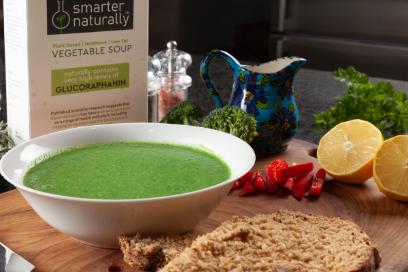
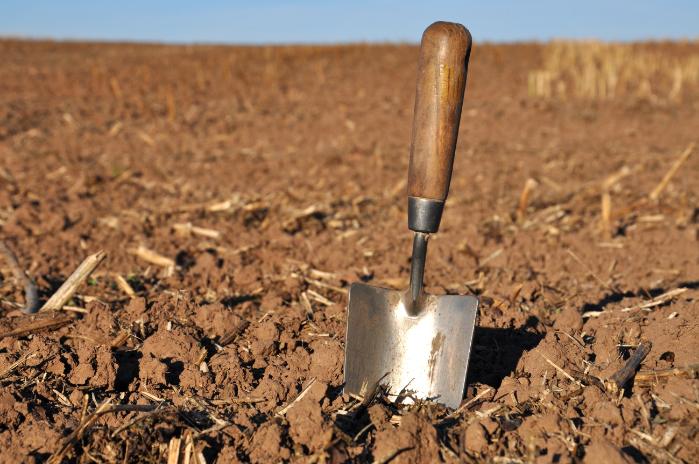
SoilSense starts with samples of the farm’s soils being sent for testing by a specially selected laboratory, says Rob Adamson; results can then be carefully interpreted by a trained ProCam agronomist, and a plan of action for soil improvement designed
Anew soil analysis and nutrient planning service, designed to help farmers gain a deeper understanding of their soil and take practical steps towards protecting and improving this key asset, is now available.
Known as SoilSense, the launch of this service from ProCam is particularly timely as farmers look to respond to changing agricultural policy
and to increased awareness of the importance of soil health, says ProCam technical development manager, Rob Adamson.

“Current soil testing practices may provide information on soil macro- and micronutrient levels, but these figures don’t necessarily reflect what’s available to the plant,” explains Mr Adamson. “Plant availability of nutrition is complex due to interactions between the nutrients and the soil’s physical and biological properties.
“SoilSense aims to give clarity by providing

Most farmers carry out some level of soil testing, but with the need to use nutrients more efficiently and soil health high on the farming agenda, there is a lot more that can be done, says ProCam technical development manager, Rob Adamson
information on both plant-available and soil-stock nutrient levels by using a range of key nutrient extraction methods. This gives a more in-depth understanding of the soil and its potential.
“Most farmers carry out some level of soil testing, but there’s a lot more that can be done to understand the results of these tests, and a lot more to be learned if the right soil characteristics are measured.”
Examining this in more detail, Mr Adamson says soil functionality is a combination of soil biology, physics and chemistry, plus soil organic carbon. Effective soil management requires an understanding of all these and the relationship between them, he says.
“Understanding what is plant-available is key to making agronomic decisions and growing crops efficiently. Basic macronutrient tests may tick a box of measuring indices of phosphorous and potassium, but we have to consider what we are learning from these results as indices don’t necessarily reflect what’s available to the crop.
“The same is true for nitrogen and sulphur. These elements work hand-in-hand, and have an intrinsic relationship with soil carbon and organic matter. SoilSense offers an understanding of how these aspects interact and takes in a wide range of factors specific to the soil in question to determine the amount of nitrogen likely to be available to the plant. This has the potential to improve the accuracy of nutrient management plans and to optimise crop performance.”

Although building soil carbon and organic matter has environmental appeal, Mr Adamson says it is also fundamental to crop resilience by helping soils to better retain moisture – which is of particular significance with increasingly-
ProCam UK managing director, Alex Collingwood says ProCam is excited to launch the new SoilSense service to bring real understanding and value to what is often a farm’s biggest asset – its soil

common summer droughts.
“The pressure to manage carbon is increasing. Unlike many industries, farmers are in a strong position to make positive and measurable changes to carbon sequestration. By offering a comprehensive analysis of organic matter and carbon, SoilSense helps growers to understand their carbon levels more accurately to chart soil health. It will also allow them to make positive changes to sequester more and reduce CO2 emissions with better soil management.”
ProCam UK managing director, Alex Collingwood says SoilSense is not just about analysis and benchmarking. By drawing on knowledge of the farm and wider experience, he says ProCam agronomists are able to interpret results and provide a practical nutrient planning service and bespoke soil improvement plan.
“Through our trials and experience, we can provide guidance on areas for improvement,” says Mr Collingwood, “for example by tailoring inputs to address imbalances that cause lockup of nutrition, or in areas such as cover crop choice to mobilise certain nutrients. Our agronomists are well-placed to interpret the science and ensure the soil is working as efficiently as possible.
“With the changing nature of farm policy, evolving end user requirements and volatile commodity markets, we are confident in the science behind SoilSense, and in its ability to support growers with these changes.”
Farmers interested in SoilSense should contact their local ProCam agronomist or local ProCam depot or e-mail soilsense@procam.co.uk
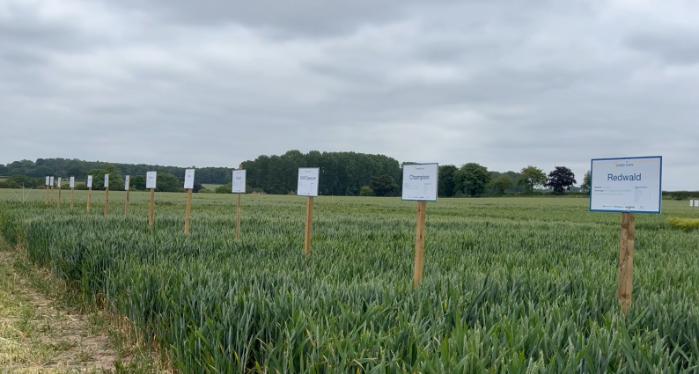
Growers and agronomists were encouraged to select the best variety for their region and situation at this year’s Arable event.
Wynnstay’s combinable seed product specialist, Danny Richardson, explained how disease pressures are affected by seasonal conditions and therefore growers should explore variety choices.
“As a result of a mild, wet spring, cereal crops have been exposed to a higher disease pressure, but the disease, which is causing this challenge varies, depending on where you’re based within the UK,” he said.
“In the west we’ve seen higher levels of septoria, whereas further East a drier warmer climate has seen yellow rust to be more problematic for growers.”
When giving tours around the demonstration plots at the Arable event, Mr Richardson said all
farmers are faced with varying situations and challenges and advised them to get advice on the best variety for their farm.
He guided attendees around the recommended winter wheat, winter barley and winter oats varieties, as well as their hybrid rye and triticale plots, allowing growers to compare performance and see potential new varieties. The two winter wheat varieties picked out on the day where KWS Dawsum a complete allrounder and LG Redwald a vigorous October onwards sowing variety.
“KWS Dawsum is best sown in the main drilling slot of Mid-September onwards, its specific weight is one of the best at 80kg/hl. It’s short and stiff with a good disease resistance to septoria and yellow rust making it a good option in this region,” said Mr Richardson.
“A new variety that has come in top of the recommended list is LG Redwald. It’s a vigorous, high biomass crop that offers high
yields. It’s also got a good disease package for septoria, eye spot, yellow rust.
“It’s most suitable for a late drilling scenario, ideally October onwards, and to help manage the biomass, it’s recommended to drill it at a 1015% lower seed rate than standard varieties, alongside implementing a full PGR programme,” he advised.
When it comes to barley, a new top yielding, conventional variety was the talking point.
“LG Caravelle is a new two row winter feeding barley, which is high yielding, has a good specific weight, and offers a great disease resistance package. It also keeps standing all

the way through to harvest,” he said.
Mr Richardson said hybrid rye has become increasingly popular in recent years. It is a cereal that requires lower inputs than your typical wheat or barley crop and has fantastic benefits for the rotation. While end market opportunities are limited, they do exist especially for biogas.
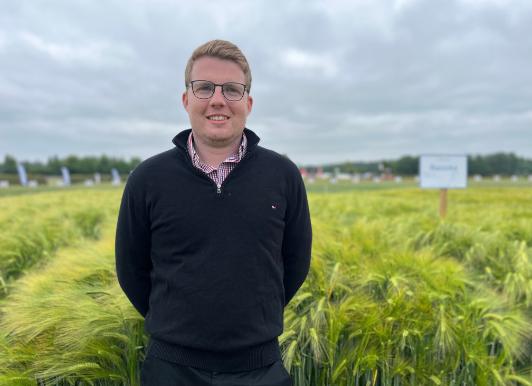
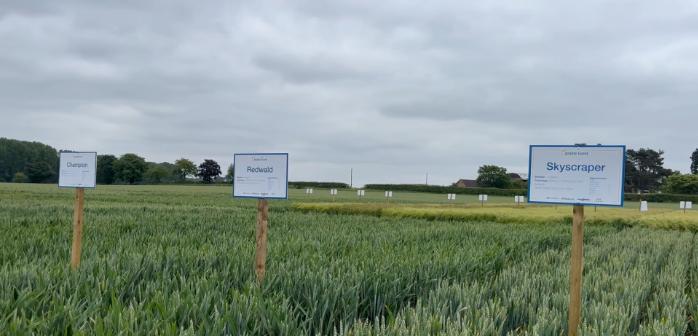
He adds that an exclusive winter oat variety has also been on trial this year.
“Galloway is a Wynnstay exclusive winter oat bred in Aberystwyth. It isn’t just another high yielding feed oat with great disease resistance, it possesses a genetic trait of low lignin which is extremely exciting. Lignin is indigestible to the animal so not only does digestibility of the feed increase, but it also has the ability to reduce methane production,” he said.
For more advice on variety selection or more information on any of the varieties mentioned above, visit our website: Agricultural Products and Services for UK Farmers | Wynnstay Agriculture.
Revaluating the role fertiliser plays in animal nutrition will allow a more targeted approach to applications and greater synergy between different nutrients.
Using simple farm tests to inform farmers of the soil and crop needs before buying fertiliser has the potential to drive up grass quality and increase the value of homegrown forage.
Grass is largest single crop in the country, and in fertiliser terms it accounts for around a quarter of the annual tonnage in the UK, but it is still dominated by one nutrient –nitrogen. Peter Scott, technical director at Origin Fertilisers, says that while nitrogen is always going to be vital, other nutrients should be considered by farmers when buying fertiliser.

“Nitrogen is still a crucial driver for protein formation and yield,

but crops require so much more than just nitrogen alone. Nitrogen efficiency can be increased by applying other nutrients and this means approaching soil nutrient requirements as a synergy rather than thinking of each one in isolation.”
Although there are fundamental differences between grassland and arable

farms, grass should be considered a crop in much the same way that an arable grower thinks of wheat or barley. However, achieving quality increases will involve assessing the status of soils, crops and manures and not following the same procedure as previous years. Ben Lowe, national forage product manager at Agrii, says farmers are starting to think about different ways to increase the value of grass to offer direct benefits to the animal.
“Many livestock farmers are thinking differently and part of the catalyst for this has been the sharp rise in input costs experienced last year. It threw into focus what was being spent on inputs, such as fertiliser and feed, and were there ways to reduce it or make better use of the spend?”
Ben LoweA livestock farmer produces grass for his/her own internal market so the need to maintain
or increase crop quality will be directly seen in animal health. Detailed soil and plant tissue analysis of previous crops can play an integral role to build a clear picture of what the soil and crops are deficient in.
Mr Scott explains:
“Grassland farmers need to grow the right quantity of grass to sustain animals, but also achieve the quality that can increase growth rates and reduce external feed costs. Increasing the quality of grass allows animals to consume more vital nutrients and, in turn, means the fertiliser becomes a feedstock for the animals. Quality increases can be tailored through Nutri-Match prescription fertiliser applications, which use analysis to target soil and crop requirements,”
Although nitrogen dominates the total market of grassland fertiliser, the relationship between other nutrients and their effect on nitrogen availability should be fully appreciated before purchasing.
Mr Scott expands on nitrogen’s role: “When looking at nitrogen’s role in greater detail, it needs sulphur alongside it at 20-30kg per 100kg of nitrogen to help the plant take up the nitrogen and convert it in to protein. Downsides to excess nitrogen is that a lot of nitrates would be in the grass and not converted into protein, reducing the feed value and quality of fermentation. This is why we can’t look at nitrogen alone, as, to get the most from it, you need sulphur.”
Mr Lowe agrees, and farmers putting time into the feed ration should also look at balancing their grassland nutrition, as understanding exactly what the forage can offer will help inform decision-making when feeding.
access exactly what it requires.
Gaining the data to start making informed decisions can start anytime, and as Mr Scott advises, grass production is a cyclical process, and any soil analysis will be useful to guide the following year’s fertiliser inputs.
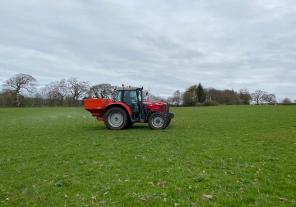
“Grassland systems provide a continuous loop, so taking soil, tissue or manure analysis can start to influence the wider picture around effective grassland management. For instance, don’t assume you know the nutrient content of your manure. Analysing organic manures can help farmers match nutrient inputs to meet soil and grass requirements and could potentially save money in the process.”
“Balancing the diet for the grassland crop, before harvest and ensiling, will help offer animals more of what they require. We need to give grassland the same thought and vision regarding nutrition as we do to making sure the ration is correct,” says Mr Lowe.
Livestock require a mixture of different nutrients, and knowing if the soil can provide these to the forage starts with analysis. Achieving the synergy of nutrients will not only provide nitrogen for crop growth, but, with the addition of other nutrients, it will help the plant
It is also useful to know what your goals are as this will allow you to gauge your starting point and how to improve. “Evaluating the amount of land available and the desired quality outcomes in terms of digestibility, protein, energy, nutrient content and mineral balances, will then allow discussions with FACTS qualified advisors on the best way of achieving these goals,” concludes Mr Scott.


To find out more, a recent podcast featured Mr Lowe and Mr Scott discussing how farmers could rethink grassland fertiliser as animal feed. Search for ‘Tramlines’ and click on the ‘rethinking grassland fertiliser as animal feed’ episode or click the link below.
https://tramlines.buzzsprout. com/1739228/12888145rethinking-grassland-fertiliseras-animal-feed
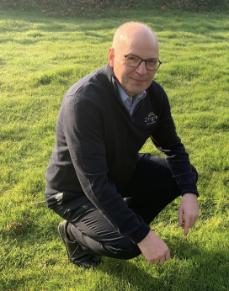
nalysis of over 400 first cut fresh grass tests show high protein and sugar levels according to testing laboratories Eurofins Agro UK. 2023 grass analysis shows first cut is nutritious but may be digested too quickly in the rumen, requiring farmers to use buffers or supplementary fibre to guard against acidosis. Bob Fabri, International Product Manager for Forage at Eurofins explains:
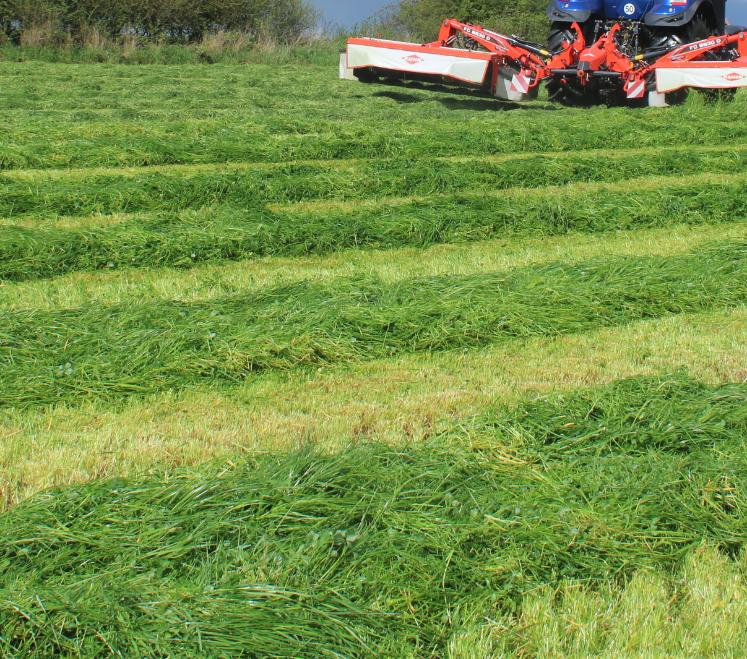
“Low cropping throughout 2022, caused by drought, led to higher residual nitrogen levels in the soil which were triggered by the
wet spring of 2023. The subsequent sunny weather has created longer than normal ‘super grass’ that should be fed out with a buffer to counteract potential acidosis and enable cows to make most use of the energy in the rumen.”
Soil samples taken by Eurofins at the beginning of the 2023 growing season showed higher than expected nitrogen levels have led to grass having higher than average crude protein levels. However, protein reduced at the end of April as sunny weather began increasing sugar levels.
“This combination in the clamp will provide very nutritious and tasty silage that will be digested very quickly unless mixed with more fibre,” he adds.
Mr Fabri suggests forage analysis after grass has been ensiled for six weeks will give the vital data needed to adjust cutting times and create silage with the right balance of protein, dry matter and NDF.
“In areas forced to take cuts later because of wet weather there may be a need for a supplementary cut to remove the nonnutritional grass stems. This will enable the sward to produce faster growing, more nutritious leaves. Following the dry weather in May and June we recommend mowing

every six weeks, if possible, to help grass grow back stronger after drought stress,” he says.
He further suggests second cuts are likely to be higher in NDF which will help those feeding out from multiple clamps balance first cut silage, but will require those who mix cuts to test more frequently.
To manage forage more accurately Eurofins offers dry NIRS forage testing which is more accurate than conventional wet NIR testing. The process also provides data for dry matter content, pH levels, ME and 23 other parameters.
“Removing moisture makes our tests more accurate. Drying the sample leaves only the solid content which, once ground to a consistent 1mm thickness, is exposed to the infrared light to provide greater detail than any other test on the market. This year, more than ever, it will be beneficial to test silage more often as the variations from cut to cut will make balancing TMR more challenging,” he concludes.
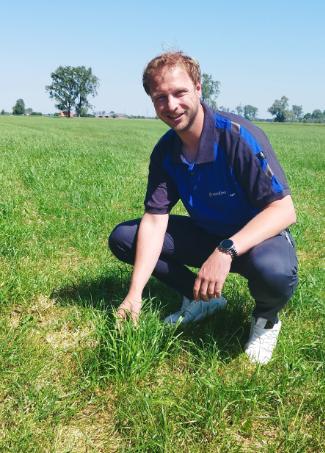
s the 2023 silage season began with variable weather conditions, dairy farmers face crucial decisions that can significantly impact silage feeding quality. Despite a challenging start to the season, ForFarmers expert Bruce Forshaw explains that early setbacks do not necessarily have a detrimental effect on silage quality.
The colder and wetter April weather led a variety of experiences across the country depending on location, conditions, and individual choices, he said. "Some farmers took their first cut while the ground was still soft, risking soil contamination, while others opted for a later cut, potentially experiencing a decrease in quality with increased fibre content."
Soil contamination occurs when grass is cut too low or in wet conditions, leading to the presence of wild yeasts or moulds, which accelerate heat generation, he explained. To mitigate that, Bruce emphasises the importance of using an appropriate additive during the ensiling process.
Grass growth significantly improved in May, with growth rates doubling compared to April. Bruce said: "While the delayed spring held back growth initially, the current trajectory is promising, so all signs are good for 2023 silage."
Given the variable conditions so far, it is crucial for farmers to have their silage analysed to understand its nutritional composition. "Through analysis, you can
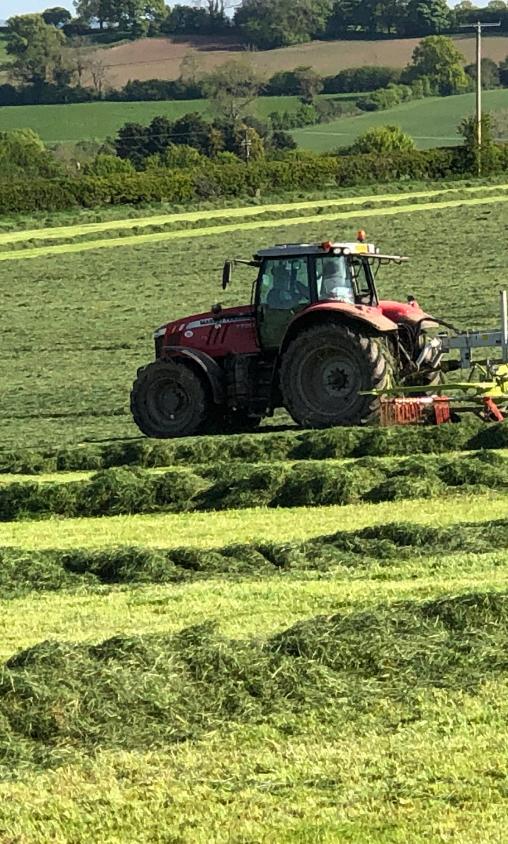
determine the actual content within your silage clamp," said Bruce. "At ForFarmers, we use dry NIR and our Feed2Milk programme, enabling precise rationing
based on the farm's forage through the use of OptiFeed."
Bruce also stresses the significance of good management practices including ensuring clamps are clean and well maintained and that silage is consolidated and sealed effectively. He also recommends layering across the clamp to ensure consistent feeding of different cuts, minimising variations in quality for the herd. Once feeding starts, it is crucial to get across the silage face within a week. These practices are particularly important when quality of silage varies, he added.
"Additives act as an insurance policy, even when conditions are ideal. They help maintain a cool clamp environment and prevent aerobic spoilage on the face." While additives cannot solve all issues, they improve fermentation, enhance quality, conserve energy, and minimise dry matter losses during storage.
ForFarmers statistics reveal that 70% of top quartile producers use additives, indicating their crucial role in silage quality.
"Considering the strong link between forage quality, quantity, and a dairy unit's financial performance, investing in additives is a prudent decision to ensure the best possible outcome."
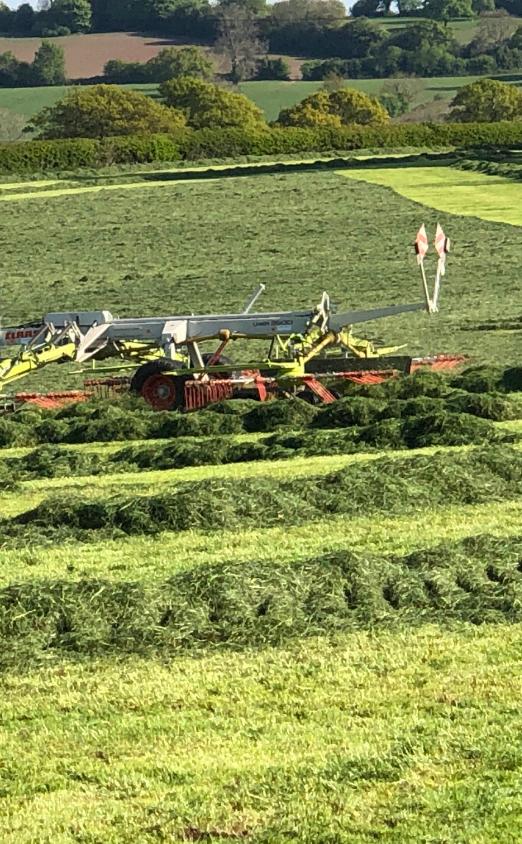

Political leaders got a grilling at the Cereals Event this week, with visitors demanding answers on a range of topics from trade agreements to food security and environmental schemes.
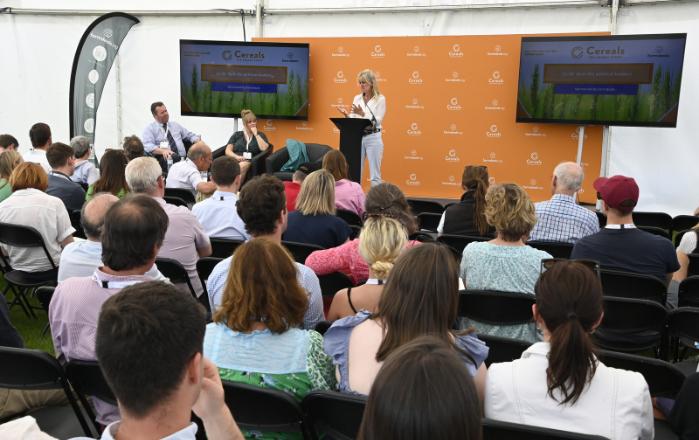
In his home county of Nottinghamshire, Defra Minister Mark Spencer was quick to reassure visitors: “Never in my farming or political lifetime has agriculture and food production been so high on the agenda,” he said. “That’s why the Prime Minister held the Farm to Fork Summit and why we continue to work with farmers up and down the country to find solutions to the challenges we face.”
But NFU President Minette Batters said there was a greater risk than ever to food security and farm profitability. “I’ve been solidly talking about how food security matters for 10 years
now, and the penny has finally dropped. The world is at a tipping point and everything we are facing now was signposted in the foresight report by John Beddington back in 2011. Looking at where Europe is - the Green Deal, Farm to Fork, 25% of land area in organics; that’s yesterdays news,” she stressed. “That is not going to do what is needed now - sustainability is the licence to trade.”
committing to a self sufficiency target and a statutory duty to report on it, Ms Batters stressed its importance. “We had a very high cost regulatory environment before, and the bar has got even higher – for legislation and regulation,” she added.
Ms Batters moved on to discuss the importance of getting the sustainable farm incentive (SFI) fit for purpose. “We really have to focus on profitability for all farming businesses. If we are going to carry on with a scheme that is focused purely on environmental delivery, we will see less food produced here.
Government taking food security seriously has been a long and painful road, she said. “It was a landmark moment when Rishi Sunak hosted the first ever food security summit. I feel we’ve moved the dial slowly, very slowly sometimes, and positively in the right direction.”
And with the Prime Minister
“If the ambition is genuine - that we are going to be producing more food and establishing green growth - then it needs to be in the policy framework. At the moment, profitability is in producing the environmental crop; it is not as profitable for food production.”
Reflecting on the NFU’s work, Ms Batters admitted she has regrets
- one of her greatest being failing to bring together the scientific community on the white paper to address trade in carbon markets. But the NFU is now working, with the permission of the Secretary of State, to bring together practitioners, scientists, and academics to focus on developing a sort of SAGE (scientific advisory group for emergencies) for agriculture, with agreed baselines. “If we don’t know the baseline from where we start, we can’t value where we started this journey, and we can’t ever have a carbon market that is credible.”
On the second day, Janet Hughes, programme director at the Future Farming and Countryside Programme, explained how Defra is adapting to help deliver a thriving farm sector with secure food
Given the target of getting 70% of farmers signed up to the new environmental schemes, she insisted that it’s vital to listen to their feedback, and then adapt the schemes accordingly. Although she acknowledged farmers’ frustration at the delay in
annually and adjust end-dates to marry up different schemes like the SFI and Countryside Stewardship.
In terms of which scheme to choose, Ms Hughes said the SFI was suitable for everyone, with a choice of options, most of which would help reduce costs and improve business resilience. It will be open this summer.
Countryside Stewardship is the next step up and is being made more straightforward and fairer than in the past. Landscape Recovery is for those who want to work with groups of farmers to create bespoke, long-term, largescale projects. Finally, there are capital grants for a range of farm improvements, and free business advice to help farmers choose.
“We’re spending £2.4bn a year in England and are trying to improve the service we provide,” she explained.
production and environmental improvements. “That’s a big ask, as we want to do those things all together,” she said. Known for being straight talking and proactive, Ms Hughes said the organisation is reforming its approach to have a more grownup, business-like attitude towards farmers.
announcing full details of the SFI, she confirmed that they would be revealed within the next couple of weeks.


The schemes will also be made increasingly flexible, allowing farmers to ‘pick and mix’ suitable measures for their system, with the ability to reassess them
“If it (the programme) doesn’t work for you, then it doesn’t work (at all).”
• The two-day event was held at a new site this yearThoresby Estate in Nottinghamshire – on 13-14 June. For more information visit www.cerealsevent.co.uk
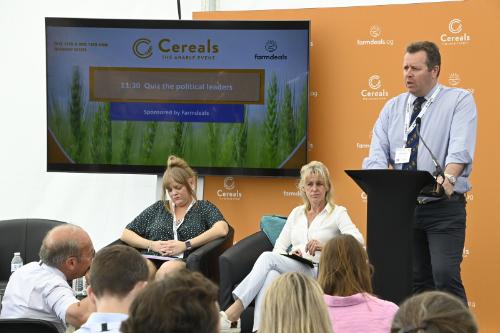

Results of a new study of environmental area management on UK farms has revealed nearly 60% of farms are now positively sowing and managing conservation mixes on environmental areas, reports Syngenta Sustainable Farming Manager, Belinda Bailey. That includes planting seed mixtures for cover crops, companion planting, winter bird food and flower species for field margins, blocks or entire fields.
Speaking at Cereals 2023 in Nottinghamshire this week (13/14 June), Belinda highlighted the market research, commissioned by Syngenta for its awardwinning Operation Pollinator initiative, calculated over 40,000 hectares of UK cropped farmland was now sown with conservation environmental seed mixes. Furthermore, there were some

93,000 ha of cover crops and 33,000 ha of companion cropping, along with game cover that also accounted for nearly 12,000 hectares.
In total, that equated to some 3.7% of cropped farm area in England and Wales, and over 6% of area in Scotland, where the survey showed cover crops are more widely grown. Farms that have positively engaged with utilising ecological habitats typically have more than five times the area within environmental management, compared to average.
The in-depth personal survey studied seed mixtures on environmental areas of more than 60 farms across England and Scotland. Of the farms surveyed, over a quarter were growing more than 400 hectares of combinable crops, with over
60% growing at least 200 hectares.
“By far the greatest proportion of growers in England (84%) cited compliance with the existing Countryside Stewardship Scheme as the spontaneous motivation for growing conservation or environmental areas, along with 65% in Scotland for Ecological Focus Area for BPS farm payments in Scotland,” reported Belinda.
Benefits of providing habitat to encourage bees, beneficial predators and birds was also seen as useful, but generally of secondary importance.
“The role of cover crops to maintain or improve soil structure (64%) and their nutritional contribution (13%) or organic matter contribution was seen as of the greatest value by growers, followed by an increase in beneficial insect populations and bird numbers, with bees and pollinators of less interest,” she added.
However, the survey also highlighted that, currently, most growers pay little attention to specific seed mixes or purpose of individual species, beyond compliance with stewardship scheme requirements.
“Independent Operation Pollinator research has provided a wealth of information to help growers make better informed decisions on seed-mix selection for agronomic, economic
and ecological benefits in individual situations,” Belinda advised.
The economic nutrient value of the Operation Pollinator Green Headland Mix cover has been fully calculated, while detailed studies have shown the biodiversity boost from Operation Pollinator Annual Flower Mix and the Operation Pollinator Bees’nSeeds for insects and birds.
“The survey findings will help to focus new initiatives to answer growers’ specific questions on seed mixes for different soil types, managing weed control with conservation or cover crops and long-term management of environmental areas within a whole farm

rotation,” she advocated.
Syngenta research continues to assess and quantify the role of both cover crops and companion crops within practical farming systems, including comparing conventional plough-based cultivations and regenerative agriculture establishment.
All the Operation Pollinator seed mixes are supplied with full agronomic information to help growers and agronomists achieve good establishment and get the greatest environmental and agronomic benefits from their use.
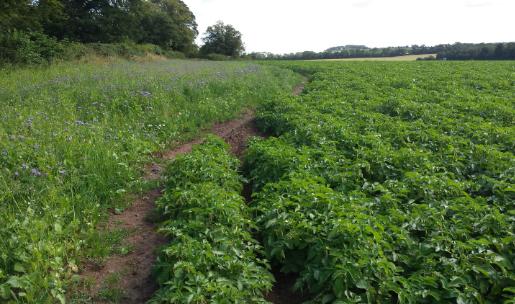
Farmers attending a roundtable event organised by Duncan & Toplis at Cereals 2023 say they're warming to the idea of joining the Basic Payments Scheme's replacement. The Programme Director for the Future Farming and Countryside Programme, Janet Hughes, spoke to farmers at the event to explain the new schemes and answer questions about their implications.
Mark Chatterton, Head of Agriculture atDuncan & Toplis, which supports nearly one thousand farming businesses, said that most farmers at the discussion concluded that they were more willing to join the Environmental Land Management (ELM) scheme in future. He said:
"Janet came across as very open and honest in the roundtable we hosted with farmers at Cereals. Although future subsidies will be lower than the BPS, having something coming in annually does bring more stability to your income given the volatility in crop production and, in my experience, every farm has some marginal land that should benefit from these schemes.
"My own conclusion from Cereals 2023 was that food production will still be over 50 percent of our clients turnover and profits. There may well be an increase in rental and diversification income but most of the land area will need farming well for food production. Getting the right agronomy, sprayer and operator is the key.
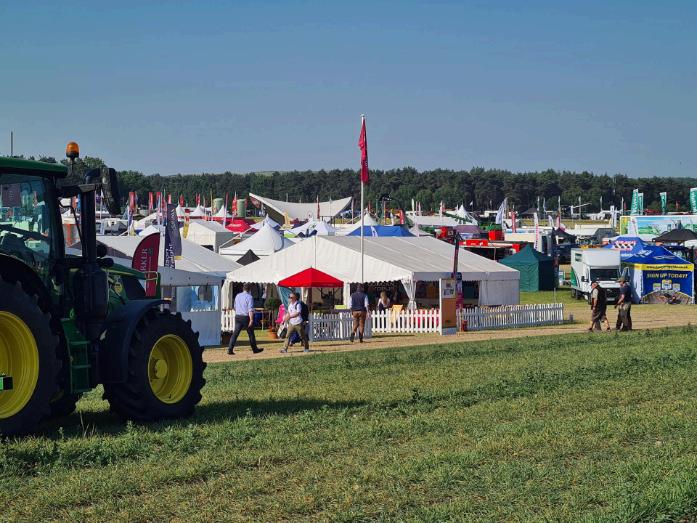

"We act for many amazing farmers who are extremely good at their jobs, so we look forward to the next 10 years as the industry continues to evolve."

As Programme Director for the Future Farming and Countryside Programme at the Department for Food and Rural Affairs (DEFRA) Janet Hughes is responsible for delivering the new ELM scheme which is replacing BPS over the 2020 to 2027 period.
Speaking at the Duncan & Toplis roundtable at the Cereals agricultural event near Newark, she told farmers: "I'm impressed by the sector's 'cando' attitude and I'm keen to see the project through."
Ms Hughes explained that the measure of success would be for over 70 percent of farms to sign up to the ELM scheme, adding that more and more farms are signing up for Sustainable Farming Incentive (SFI) grants and many are already in their fifth year of the Countryside Stewardship Scheme (CSS).
She also stressed that DEFRA wanted a two-way system with farmers, and explained that 'old style' penalties would not be applied to SFI schemes and that DEFRA inspections are now termed 'visits'.
The UK government has committed that the £2.4 billion that was allocated to the BPS will be ring fenced, with the spending allocated to a mix of environmental payments through CSS and SFI together with grants for specific projects.
The National Farmers Union (NFU) is pressing for rate increases but Ms Hughes said that an increase in line with retail prices index (RPI) could not be guaranteed as her DEFRA budget was not RPI linked. However, SFI rates have increased for 2023.
More information about the ELM scheme and other support schemes for farming businesses in England and Wales is available from thegov.uk website.
For professional advice for agricultural businesses and information on a range of business services please visit the Duncan & Toplis websitewww.duncantoplis.co.ukor call 0333 259 0049

Visitors to the first day of the Cereals Event at Thoresby Estate, Newark, were treated to a wide range of new product and campaign launches. Here we pull together a few of the main announcements.
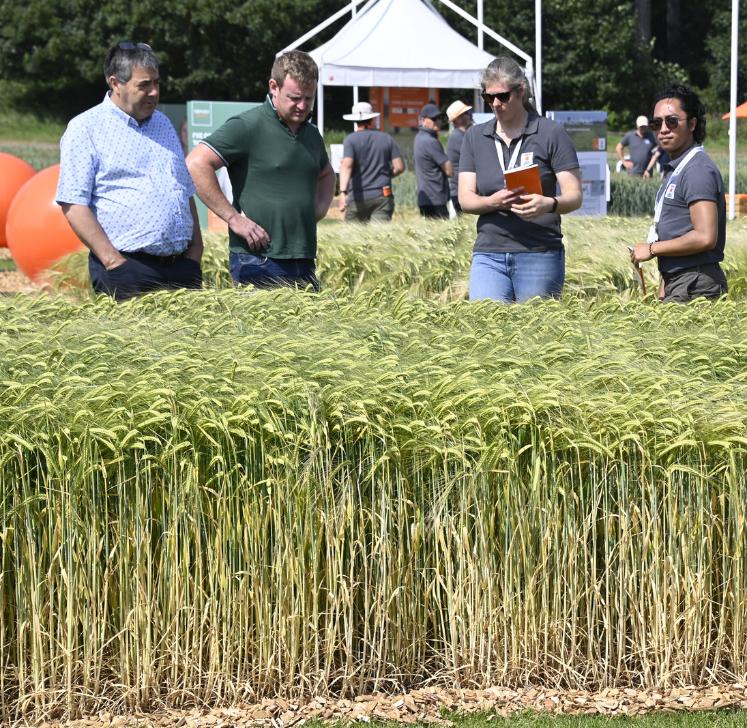
Kicking off the day was the NFU launch of the 2023 #YourHarvest campaign. Though the campaign has been prolific on social media
since its inception, this year the NFU is specifically focusing on TikTok, in a bid to help build a positive connection between farmers and the younger generation, explained Matt Culley, NFU combinable crops board chair. “We’ve been running this campaign for quite a few years now and it’s helped connect the arable industry, through social media, to different generations and different types of people.
“We’re focusing on TikTok this year because we want to try and specifically target under 35s. This is the connection we don’t believe is quite there yet in terms of food production.”
The campaign will run through the summer and into the autumn. Mr Culley urged farmers to get involved by capturing their harvest journeys and stories –both positive and negative – to showcase the width and breadth
of harvest in the UK. If they tag it on TikTok with the #YourHarvest hashtag, it will also be shared across the NFU’s own TikTok channel.
KWS varieties
KWS debuted two new candidate wheat varieties in its crop plots, adding new options for Group 3 and Group 2 growers.

KWS Skateum is KWS’ latest Group 3 variety, with KWS Firefly in its parentage. It offers growers a short, stiff-strawed type with the potential for distilling markets too, explained the firm’s Mark
Dodds. “It’s an early type, with good yellow rust and midge resistance, as well as a score of 6 for septoria.”
For Group 2 growers, KWS Dragum showcases the ‘next level’ of yield potential in this group, added Mr Dodds. Boasting a yield score of 104 in the East, Dragum is a Zyatt x Podium x Costello cross with a good agronomic package, offering a score of 9 for yellow rust. “It is short, stiff and early, with good specific weight and Hagberg. So growers should be able to get it into the shed nicely at harvest,” he said.
These varieties sit alongside newly recommended soft Group 4 KWS Zealum and Group 2 KWS Ultimatum, which are entering the market this year. Also on the horizon is a new barley named B157, which is currently in NL2 trials, said Kirsty Richards, cereals product manager. “It’s a Tardis x Paloma cross and it looks like the next big thing – it’s currently the joint highest yielding in the NL trials.”
Also on the variety front, visitors to the Corteva stand were given a first look at a new hybrid winter oilseed rape from Pioneer Seeds. Named PT312, the variety is the second ‘Protector Sclerotinia’ type in the Pioneer stable – a trait which is claimed to arm growers with tolerance to the yieldrobbing disease sclerotinia –and also boasts TuYV resistance, stiff straw and high oil content.
Keen to help keep growers up to date with the industry drive to reduce its carbon footprint, BASIS used the Cereals Event to launch a brand-new online course aimed at educating and informing those in the industry about the opportunities to reduce agricultural emissions. The course, ‘Principles of Carbon and Net Zero’, has
been released as part of a series of new environmental training opportunities. It will cover areas including storage and sequestration, as well as how to calculate carbon footprints and strategies for moving towards net zero.
“Knowledge, skills and understanding are often the first essential components that lead to effective action and progress in the implementation of measures on the ground,” said Teresa Meadows, head of environment, audit and public affairs.
Northamptonshire-based Mark Jelley was crowned the 2023 winner of the coveted Syngenta Farm Sprayer Operator of the Year (FSOOTY) competition on day one of the event.
Mr Jelly is the lead sprayer operator at Brixworth Farming and is responsible for the spraying of 1,500ha of combinable crops at the farm, as well as 500ha under contract farming agreements, with his 5,000-litre Chafer Interceptor self-propeller sprayer which runs on a 36m boom width.
Mr Jelley was a finalist in 2019, but decided to give it another go this year, and commented that it was a further opportunity to improve his knowledge and skill set.
Making the presentation at the event, Syngenta application specialist, Scott Cockburn said: “In one of the largest entries in recent years, this year’s finalists highlighted that experience counts - since all of them had made the shortlist before.
“Everyone in the industry is aware of how the application of plant protection products is under constant scrutiny. That’s why highly skilled, qualified and expert operators, who take their continuous professional development seriously, hold such an important position on farms.”
This year’s Cereals seminar programme, themed ‘Your connections to a better business’, brought together 100s of farmers and experts to share the latest research, advice and experience to boost profitability and sustainability.
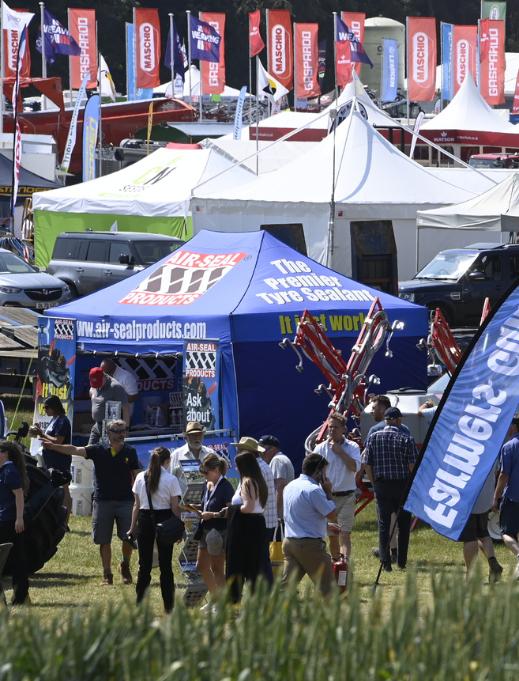
Kicking off the programme was a session on privately funded environmental incentives, exploring the different ways in which farmers can generate an income from their natural capital. “There are multiple ways to engage with markets – directly with buyers, through aggregators, or farm clusters,” said Professor Fergus Lyon, who is Managing Partner at Easthall Farm, Hitchin, Hertfordshire.
He suggested taking advantage of the full mix of markets, from short-term options like cover cropping to improve water quality and premium prices for naturefriendly crops, to long-term contracts for biodiversity net gain or tree planting. “Uncertainty is holding us back in some areas (like carbon trading) but the science is getting stronger and contracts are clearer, so once we’ve shown we can be net zero ourselves we’ll have more confidence in selling carbon.”
Collaborating is a great way to access private finance and deliver landscape scale benefits, as Roger Dalrymple, director at Waitatapia Farming in New Zealand, explained. “We need to understand what effect our farm is having on the environment and produce the data to prove what we’re doing to improve, so that other people can tell our story rather than trying to tell it ourselves,” he said.
Mr Dalrymple works with 350 other farmers on the Rangiteki Rivers Catchment Collective,
across 700,000ha, undertaking monthly river water testing to drive management decisions. The group secured NZ$2.5m (£1.2m) to improve water quality. “We’re working together to get ahead of where society wants us to be – being farmer-driven is key.”
Alison Rickett agreed that working together delivers more benefits all round compared to individual approaches. She has matched groups of farmers with
large investors to deliver environmental benefits through Landscape Enterprise Networks (LENS). The East of England cluster is expected to generate £4m in 2023 across more than 100,000ha, and the Cumbria network delivered six times the benefits that could have been achieved individually.
“Collaboration is the only way forward to deliver LENS.”
Farmers also came together to learn from each other at the
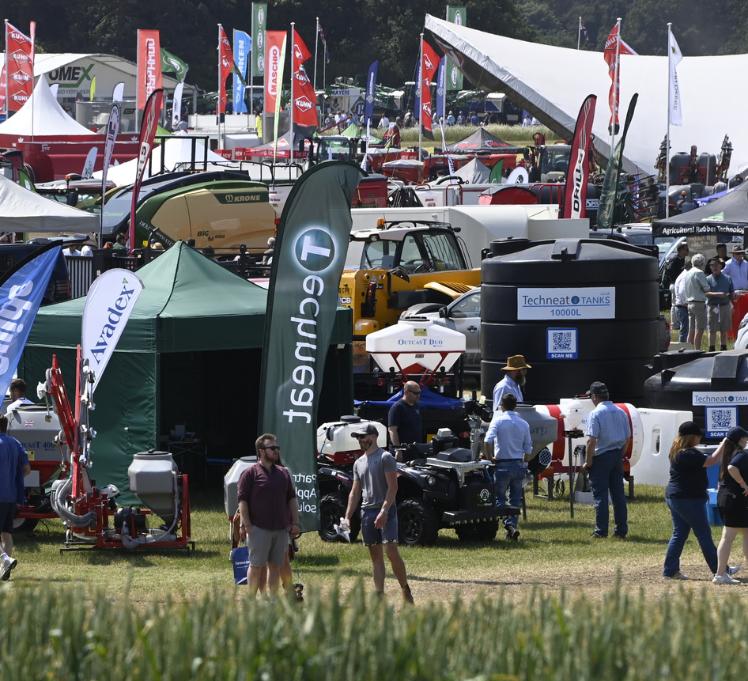
popular new AgAnalyst Academy focusing on making precision farming pay, the NAAC Drainage Hub, and the new Cereals Stories stage, which featured farming celebrities like Olly Harrison and the Wurzels, fundraising for the Multiple System Atrophy Trust (MSAT). In total, the exhibition was 30% larger and registered attendance was up 7% on 2022, raising £30,000 for the MSAT, plus the charity raffle.
Other sessions explored topics like net zero and climate change, soil health, regenerative farming and publicly funded environment incentives. The final session of the two-day event brought together seven innovators for quick fire presentations on the latest thinking and technology. This featured the next generation of autonomous drones, robots, and methane tractors, as well as new research into pollinator monitoring, gene editing and
sugar signalling to boost wheat yields.
“Science will be a massive player in how we get to net zero,” said Robert Smith from Russell Smith Farms, Hertfordshire, when explaining the measures he has taken to ensure business sustainability in a changing climate. “It’s more important than ever that we produce more of our own food for a secure future.”
Farmtrac will debut at the Great Yorkshire Show in Harrogate on 11-14 July 2023.
Known as one of the best agricultural shows in the UK, the event has a respect for tradition and welcomes innovation, which is what makes Farmtrac’s attendance even more exciting thanks to it leading the way when it comes to new technology.
Manufacturer of not only the industry’s first all-electric compact tractor, but a range of cutting-edge, cost-effective, smart-looking 22-113hp tractors, Farmtrac will surely be of interest to today’s agricultural audience.
Therefore, on distributor Reesink Agriculture’s stand there will be the FT25G all-electric tractor, revered for its eco-friendly lithium-ion battery, lownoise, emissions-free operation. The FT25G can run for up to six hours and left to charge overnight using a domestic three-pin socket for eight hours and still outperform a comparable 25hp diesel tractor in applications such as mowing and transporting materials.
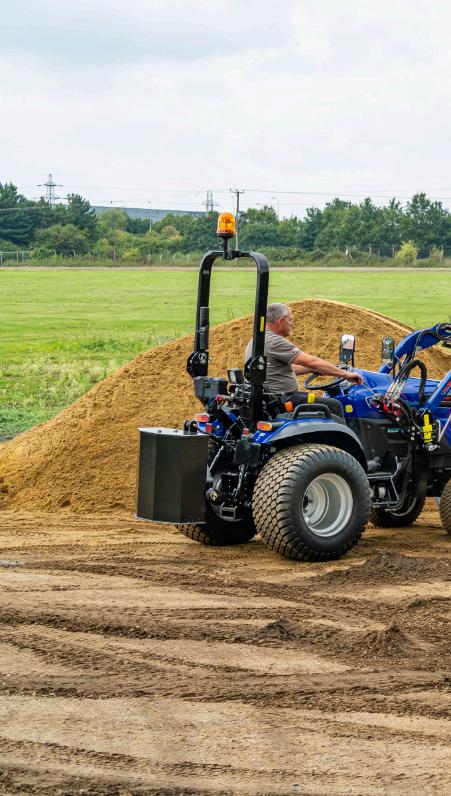
The crowd favourite, the FT26, will be there along with its hydrostatic (HST) version. With its light and narrow body, this model known for its ability to get results in smaller, tighter areas without compromising on performance while its 750kg capacity means it’s more than capable of handling field work.
And from the higher end of the horsepower range, the FT6050 joins the line-up. Favoured for its fuel efficiency and durability, its 47hp threecylinder Stage V diesel engine is designed to meet EU emission standards, which ensures clean emissions while delivering good levels of fuel economy and plenty of power. The heavy-duty rear three-point linkage with 1500kg lift capacity features Cat1 and Cat2 ball ends to accommodate a host of rear-mounted attachments.
Something all these tractors have in common is their world-class components including transmissions
designed and produced by Carraro and hydraulic systems from MITA, to deliver a superior performance whether working the land, towing trailers or hauling equipment.
Steven Haynes, tractor sales manager at Reesink Agriculture, comments: “The reason why we have a comprehensive show calendar is because Farmtrac is a relatively new player to the UK tractor landscape, and they really
need to be seen in person and up close to appreciate the quality they bring.
“These tractors provide a great alternative for customers who want something innovative yet practical, cutting-edge yet traditional. There’s no compromise on efficiency, durability or longevity and they really are a very welcome addition to the UK’s tractor offering.

“We look forward to showing visitors at the Great Yorkshire Show the Farmtrac range and telling them about the superb warranty of up to five years and to discuss the great value, great choice options they offer for the price point.”
To talk to someone about Farmtrac tractors or becoming a Farmtrac dealer, call 01480 226800, email info@reesinkagriculture.co.uk or check online at reesinkagriculture.co.uk
Having first seen JK Machinery’s JCM VibroMAX 10133 vibrating sieve cleaner at Groundswell last year the event’s founder, John Cherry, recognised that it would prove an essential piece of machinery as he increases intercropping as part of the regenerative and agroecological farming practices at Lannock Manor Farm.
“After discussions with McArthur Agriculture, I took the decision to invest in a VibroMAX,” explained Cherry. “We had previously been using an old twosieve pre-cleaner to separate crops but we often had to put crops through it twice, and one of the crops would still not be as clean as we wanted,” explained Cherry.
“Mono-culture does not happen in nature and so we are planning to increase intercropping into our crop rotations, to help improve soil health by increasing water and nutrient utilisation, driving up pest and disease resistance and weed suppression.
“But with larger amounts of crops to separate it was clear that we needed to upgrade our cleaning and grading capabilities so that we could add value to harvested crops on-farm.”
The JCM VibroMAX 10133 is a triple decked machine equipped with three vibrating sieves which clean and separate crops to a high standard in a single pass, each crop being aspirated individually, via twin aspirators, to ensure the best results.
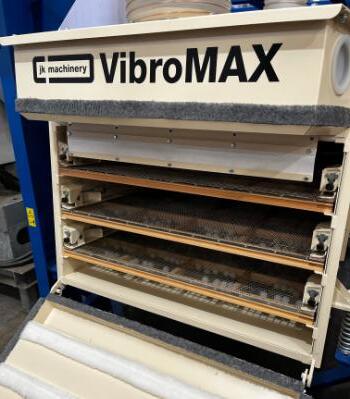
The performance of the JCM 10133 range of cleaning and grading equipment can be controlled through the changing of sieves and adjustment of several process variables, including machine angle and vibration frequency.
Cherry has been experimenting with intercropping for around eight years mainly growing peas and rape as both were relatively easy to separate and clean using the old pre-cleaner.He is looking to grow wheat and beans, OSR and peas and peas and beans and would like to get to a stage where each field contains two or more, combinable or noncombinable crops.
“A lot of farmers are looking at intercropping trials, which can add complexity to crop rotation. However, it does allow savings to be made on
inputs and the combination of potentially smaller yields of both crops can deliver a larger yield than if just one crop had been grown,” continued Cherry.

The Cherry family have farmed for 31 years, converting to a no-till system in 2010. “We started Groundswell seven years ago out of frustration that no-one was putting on a summer show that we wanted to attend,” said Cherry. “Its popularity goes from strength to strength and in 2022 we welcomed over 5,500 delegates.”
Groundswell’s growth reflects the snowballing of interest in regenerative agriculture, not only from farmers but also from policy makers attracted by the ‘public benefits’ of such systems, which include carbon sequestration and flood/drought prevention.
“Intercropping is the future as it becomes an integral part of regenerative farming. McArthur Agriculture, with its range of cleaning and grading equipment, can help farmers to make the transition to intercropping by providing the cleaning and grading machines to quickly and easily separate different crops, increasing their value post-harvest,” concluded Cherry.
Groundswell founder selects JK Machinery’s vibrating sieve cleaner from McArthur Agriculture to upgrade crop separation and cleaning capability
roducers are being encouraged to consider home grown concentrates, such as crimp, to bolster rations where silage analysis indicates low energy forage.


Lientjie Colahan, from Lallemand’s technical support team, says that the timing of the wet weather this year resulted in some farms taking first cut later than originally planned, which could result in a lower energy forage. For these farms, crimp could prove a good home-grown energy alternative.
“Crimped grain can help balance the energetic value of the ration, without increasing the proportion of purchased feed required,” says Mrs Colahan.
“The straw left behind after combining can also be baled and used for feed. Because the crop is harvested earlier than dry grains, the digestibility value of the straw is marginally increased,” she adds.
Mrs Colahan explains that when it comes to handling crimped grain, the way it is treated and ensiled has a big impact on its nutrient retention and quality at feed out, so this must be considered.
As crimp offers a rumenfriendly source of starch, Mrs Colahan says it is a very safe way to lift the energy content of rations and is a particularly good option in situations where silage falls short.
“Some farmers may have made high bulk but lower energy silage,” she says.
“If first-cut grass silage analysis is lower in ME than expected, crimped cereals should be considered as a cost-effective way to make up the shortfall in rations.
“Crops that are suitable for crimping include maize, barley, wheat, oats, and triticale. Grains should be harvested at a moisture content of between 25 and 40 percent – typically two to three weeks earlier than conventionally combining,” she adds.
Due to the high moisture, all crimped cereals will need to be treated with an appropriate inoculant to reduce spoilage and nutrient loss.
“Spoilage microorganisms such as yeasts and moulds must be controlled when the crimped grain is fermenting, as well as when it is being fed out, to inhibit them from consuming the valuable nutrients preserved within the clamp,” she explains.
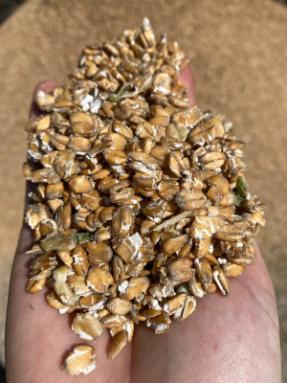
“Taking control of the fermentation process and microbes that are present is particularly important with crimp, given that starch is an ideal nutrient for spoilage microbes and that it tends to be fed quite slowly,” she adds.
Mrs Colahan advises using a crop-specific inoculant such as Magniva Platinum Crimp which has been specifically developed to preserve moist grains and offers a cost-effective alternative to conventional acid treatments.
“Magniva Platinum Crimp is a biological option containing antifungal bacteria which produce powerful compounds that inhibit spoilage microorganisms. Designed specifically for crimp, it contains a high dose of beneficial heterofermentative bacteria to make sure they dominate the wild bacteria which would otherwise create an uncontrolled fermentation and do not necessarily inhibit the growth of spoilage organisms.
“This ensures faster preservation, while helping to avoid heating and spoilage at feed out, and when used with the correct storage conditions it can reduce wastage to almost zero,” explains Mrs Colahan.

She also emphasises the importance of good clamp management. “Prepare the clamp properly with a ground sheet, side sheets and a top sheet that’s properly weighed down after the clamp has been sheeted. Also pay attention to vermin control throughout the season as rats are particularly drawn to this feed.”
For more practical advice on making high quality grass, maize, and wholecrop silages as well as fermented crimped grains, read our Forward with Fibre guide. To get your copy of the guide scan the QR code below.

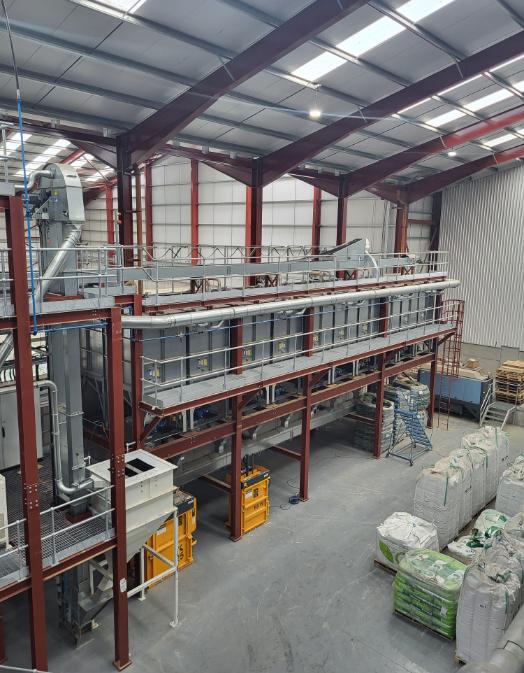
To satisfy the mixing demands of Seed Technology Ltd’s (Seedtech) biggest partner in the grass seed sector, DLF Ireland, Seedtech worked with trusted partner and proven grain and seed handling experts BDC Systems Ltd, to design and direct the installation of a bespoke, state of the art, futureproofed grass seed mixing plant.
“We had a small grass seed mixing plant which was very labour intensive and delivered limited output,” explained Nigel Whyte, Seedtech’s general manager. “We needed a plant that would allow us to easily, quickly and accurately mix up to 20 varieties of grass seed to meet the individual seed mixes our customers require.” Waterfordbased Seedtech is the leading developer and producer of arable seed varieties for Irish tillage farmers.
“Andrew Lee, BDC Systems’ director and his team were the first on the team sheet for this project,” said Whyte. “We have a longstanding and trusted relationship with Andrew Lee and for a development of this potential complexity, we understood the value of being able to draw
on his vast experience and connections across the grain handling sector.”
During the scoping for this new project
Seedtech and BDC Systems’ Lee, evaluated existing seed mixing plants in the UK, Ireland and Denmark.
Working together and agreeing BDC Systems’
final design for the plant, Seedtech then faced another challenge – how to organise the installation during a ‘down period’ and to synchronise the timings across the necessary teams so that the new plant would be up and running ahead of Seedtech’s new season.
“Lee and the entire BDC team provided both onsite and remote support and successfully liaised with all of the contractors to ensure the job of work was completed,” continued Whyte. “As with projects of this size and complexity there were some time delays but the new plant was fully operational in time for the new season.”
Installation was conducted by BDC Systems’ established partner, Irish Grain Handling Systems Ltd, supported by Castle Facility Electrical Services Ltd, in the Autumn of 2022 and was commissioned early in 2023.
Lee and the BDC Systems team have designed an automated grass seed mixing plant that enables up to 20 varieties of seed to be drawn from individual storage hoppers and then mixed to deliver specific mixes.
“We designed a PLC control panel for the plant which integrates with Seedtech’s warehouse management system (WMS) so that the necessary automation could be achieved,” said Lee.
Grass seed is received into the plant in approx two cubic metre bags, placed over an above ground intake equipped with a splitting knife, which automatically opens the bags so that seed is discharged into the intake.
From the intake seed is transported via a Skandia belt and bucket elevator to a reciprocating cleaner which removes any foreign objects. A second Skandia elevator discharges the seed onto a belt conveyor where it is taken to the appropriate storage hopper. The destination hopper is determined by integration between the PLC control panel and the WMS.
BDC Systems’ bespoke design included 20 x 1.5m sq, 60 degree BM Silo hoppers with rounded corners to prevent any lodging of seed. Each hopper sits on a set of four weigh cells – one on each leg.
Seed orders are handled by the PLC control panel and the WMS so that the exact amount of grass seed variety is drawn from the correct hopper, until all of the needed varieties have been gathered to make up the required mix.
The amount of seed drawn from each hopper is controlled by a rotary seal which acts as a mechanical metering system. The weigh cells identify when the required amount of seed has been extracted and the rotary seal closes.
The grass seed then goes into a premix buffer hopper and via another Skandia belt and bucket elevator and a belt conveyor, is discharged into the mixer once it is free. The mixer was sourced by Seedtech and DLF and BDC Systems successfully incorporated it into the plant’s design.
As soon as the mixer is full, the PLC control panel and the WMS gather seed for the next mix from the individual hoppers and the premix buffer is filled.
If necessary small amounts of seed can be manually weighed and added before the seed is transported to the mixer.
Once mixed the seed is taken to the prebagging buffer hopper where it can be bagged into whatever size bag is required.
“Our new grass seed mixing plant has been fully operational for almost four months and whilst we are still adapting to the system, we are extremely happy with how it is working for us,” stated Whyte. “But, more importantly the Seedtech employees who run the plant are happy and proud to be working in such a stateof-the-art facility.
“The automation has greatly reduced manual handling which is crucial as finding good quality employees is a growing struggle. Reduced labour costs, reduced overtime, increased accuracy in mixing and increased output, delivers significant savings to our business.”
Seedtech is confident that BDC Systems’ design of the new plant not only meets its current requirements but has enough built-in capacity to meet its forecasted growth ambitions.
“It pays to engage with a partner like Andrew Lee and the entire BDC System team. Andrew understands the importance of putting time and effort into the planning and design stage of any project. Plus, he brings a bank of knowledge and expertise to the table and can correctly interpret the feedback from customers, especially from those who will be operating at the coalface of the project. The end result is that everyone’s expectations are not just met, but exceeded,” concluded Whyte.
Openfield has partnered with Trinity AgTech to raise their sustainability credentials and bolster their members' supply chain resilience. As the UK's biggest grain marketing and arable co-operative - comprising 4,000 farmers - Openfield's team will use the collaboration to help secure long-term supply chain contracts and build on their strong desire to further improve their service to members. This will take the form of exploring new opportunities in the marketplace and capitalising on how they can better meet their consumer customers increasing demand for more crop provenance, with proven metrics behind it.


James Dallas, chief executive officer at Openfield, explains why they want to be ahead of the curve in choosing Trinity's Sandy natural capital navigator tool to help build farm resilience.
"We want to provide our members with the power to gather evidence of their farming practices that deliver for the environment. It can't be underestimated how critical it will be to farm business prosperity in the long term.
"Farmers need more support in the current climate, so we feel a tool that addresses a broad range of production and environmental impacts is the best choice for our members.
"We believe that, eventually, information on a farm's environmental impact will need to be supplied by the whole supply chain, from farm gate to fork, so we want to get ahead to capitalise on the benefits," says Mr Dallas.
After conducting extensive due diligence into Sandy's credentials and capabilities, Openfield is confident that Sandy can offer members the flexibility to plot their own sustainability journey, while credibly recording outcomes of farm profitability and environmental impacts.
"We've looked at several products and Sandy is the only tool that covers the whole breadth of natural capital.
"Most tools focus solely on carbon, but some projects we're currently working on look at more than carbon, such as water quality and biodiversity.
"Our members will also benefit from Sandy's ability to provide scenario planning. This improves accuracy in measuring the outcomes of their farm management decisions, both financially and environmentally.
"As Sandy is accredited to latest ISO standards, the scientific basis is hugely beneficial to our members and will provide credibility to the whole supply chain," says Mr Dallas.
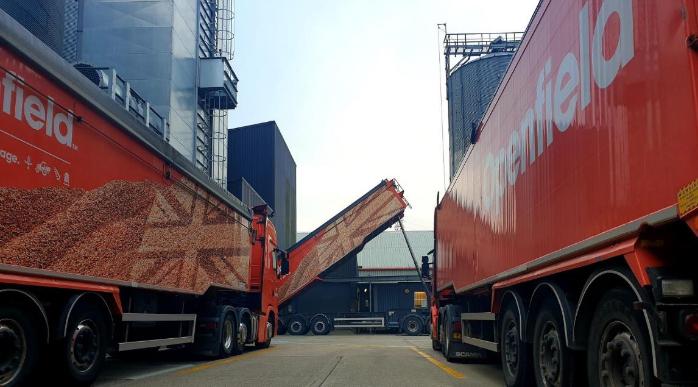
Commenting on the collaboration, Trinity AgTech's managing director of business development, Anna Woodley says: "We're looking forward to working with Openfield and its members on their sustainability journey. "Openfield is about more than just grain and are well-known for providing their members with innovative supply chain solutions and fantastic benefits, and we know that Sandy, with its world-class scientific evidence and accessible, rigorous analytics will offer real value".

More farmers are routinely using biological products because they deliver costeffective yield benefits and contribute to a sustainable approach. And while the advantages are proven, application timing is key to success.
Signalling compound, 3ALO T6P, from Unium Bioscience, is benefitting farmers when used at T3 stage on arable crops.
Agrovista agronomist, Phil Warham, believes that farmers can reach required milling specifications by using the 3ALO T6P foliar treatment on oats. “Using the T6P biostimulant at the panicle growth stage (GS59) helps to make carbohydrates more
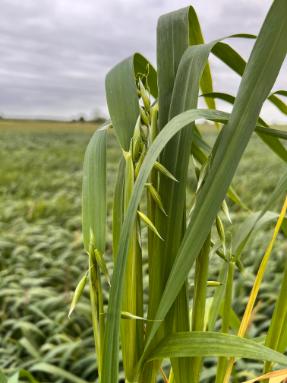
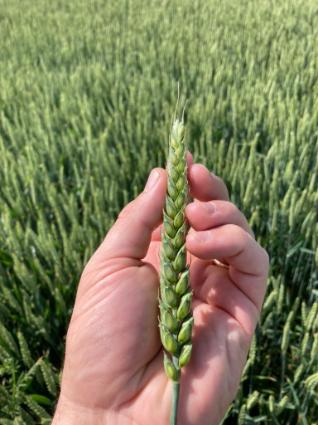
available to the plant at the crucial grain filling period.
“It has to be used at the right time, in the right scenario, but for those I’ve recommended it to, it’s having a big impact on grain quality and specific weights, and it could easily make the difference between reaching milling spec or not,” says Phil.
Bedfordshire farmer, Matt Fuller at Heathcote Farms, regularly uses biostimulants on oats, milling wheat, winter barley, OSR and winter beans.
“Over the last few years, we have regularly used 3ALO T6P at T3 timing,” he says.
Matt was involved with 3ALO T6P trials and he says the results were impressive.
“We’ve seen the benefits clearly in trials and we now include biostimulants in most tank mixes, and for the last few years, we have regularly used 3ALO T6P at later stage timing.”
Matt believes biologicals are a
key component in the farm’s environmental ambitions. “The farm must be profitable, as does each crop, but we also have to prioritise the environment by reducing reliance on synthetic chemistry and soil disturbance.”
John Haywood, at Unium Bioscience, the company behind 3ALO T6P explains that it’s a signalling compound, based on Trehalose-6-phosphate, a molecule that regulates plant processes including metabolism. “T6P is the key component to utilisation of all the hard work for the crop cycle, building grain quality.

“The trehalose pathway contributes to many factors affecting overall plant health, including stress tolerance, energy metabolism, growth and development, defence

against pathogens, and metabolic regulation. It’s a dynamic pathway that helps plants adapt and respond to changing environmental conditions and maintain cellular homeostasis.
“It’s a product that can be used on many crops, including cereals at T3, peas, beans, fruit crops and OSR at flowering, potatoes at mid bulking to improve bulking rates and sugar beet at 6-leaf stage, and for sugar beet it can also be included at fungicide timings to increase the plant’s ability to mobilise sugars into the tap root.

“We are continuing to explore the Trehalose pathway, and we have some great results from new signalling compounds which have the same positive effects on plants, meaning in the near future, more products will be available to farmers,” adds John.
T6P (trehalose-6-phosphate) is a central signalling compound in plants responsible for regulating sucrose and the way it’s allocated to crop growth, development and to different locations in the plant. Two of the key benefits are increased yield of the sink component e.g. grain, or improved recovery from drought stress. T6P regulates seed filling through increasing cell differentiation and starch accumulation, maximising the efficient transfer of sucrose into storage starch and or oils.

Tornum Ltd (formerly JW Installations Ltd), a leading provider of innovative solutions catering to the agricultural and industrial sectors, is thrilled to announce its recent partnership with Skandia Elevator as an official UK distributor for their market leading range of grain conveying products. This collaboration solidifies Tornum’s commitment to deliver top-quality solutions and maximise operational efficiency for their customers.
Skandia Elevator, renowned as the market leader in grain conveying, brings three decades of expertise and a proven track record of delivering cutting-edge solutions. Their comprehensive range of products is designed to optimise daily operations, ensuring uninterrupted productivity for businesses across the agricultural and industrial sectors.
The establishment of a strong relationship between Skandia Elevator and Tornum ensures that customers will have access to the very best products available on the market. Tornum's expertise in the agricultural industry, combined with Skandia Elevator's exceptional grain conveying solutions, presents an unmatched opportunity for
customers to elevate their efficiency and achieve seamless day-to-day operations.
"We are extremely proud to be a UK distributor for Skandia Elevator," said Charles White, Director at Tornum Ltd. "This partnership allows us to offer our customers the most advanced and reliable grain conveying products, enabling them to optimise their operations and achieve unrivalled efficiency. We are excited about the endless possibilities this collaboration brings and look forward to working closely with Skandia Elevator to serve the needs of our customers."
The partnership between Tornum Ltd and Skandia Elevator is a testament to both companies' commitment to excellence and innovation. Together, they will provide the agricultural and industrial sectors within the UK with incomparable solutions that streamline operations and foster growth.

Let’s get right down to the soil. It’s viewed as a commodity that’s been taken for granted and now, we are truly in dire need to face realities that we must strive to conserve this living, breathing matter, filled with an abundance of living organisms.

The goal of good soil management is to meet essential plant needs. Healthy plants need water, nutrients, oxygen, and a physical medium that allows seeds to germinate, shoots to emerge and grow up toward the sunlight, and roots to anchor the plant by growing strong and deep. But management of the land is what’s caused the problem is it not? Do we really have the right to manage nature?
Humanity has wounded and inflicted so much upon the beating heart of our planet. Nature is a system and a complex one at that and it’s time to restore, reconnect and regenerate.
Regenerative agriculture is a growing movement as the need to improve or maintain the quality of topsoil has come to the fore. Soil health has a vital impact on not only improving the quality and quantity of the food produced, but also healthy soil makes the plants more resilient against extreme weather and pests. Taking care of the soil can reduce the level of inputs required for a given amount of quality produce.
“Despite all our accomplishments, we owe our existence to a six-inch layer of topsoil and the fact it rains.”







I recently caught up with Claire Mackenzie who is the film producer in a team of formidable experts, that are campaigning to create a film that challenges our industrial food system and transforming the way that food is produced - to heal the soil, benefit our health and provide for local communities.


Six Inches of Soil is a documentary feature film that discusses how farmers will have to navigate a broken food system, farm in a landscape degraded by industrial agriculture and learn how to reconnect people with the soil, where their food comes from and how it is produced and also gives farmers the confidence and practical know-how to adopt naturefriendly farming practices; gives consumers the impetus to rethink food choices and information about how to buy and support agroecologically produced food; and to create a groundswell of opinion resulting in policy change and public and private funding for a British agroecological transition.
By illustrating how the soil food web is a complex living system, and showing how the issues with our current industrial food system have deep historical and structural roots that has transformed food from the essential stuff of life to simply a product produced for profit; debunking the myth of food scarcity and outline how the global population can still have affordable, nutritious food while being genuinely sustainable; Challenging the major supermarkets, agrochemicals and


biotech industries and corporate food lobbyists to respond to this alternative vision for agriculture; we can and will make this planet a better place for future generations.
Six Inches of Soil is a story of courage, vision, and hope. The teaser is honestly so compelling and brought me to tears. As a food producer and custodian of the countryside myself, I’m aware of my responsibilities to leave our land in a better condition than when we started but if you were in any doubt then I urge you to watch the teaser. It cannot fail to convince those that are undecided to think differently.

Claire states ‘It’s a mindset change and thinking about the resilience and longevity of the farm. It is for everyone as we all need to think about regenerating our planet not just sustaining it. It is a long journey but best to start it now for the next generation. Don’t rush into it but get advice from organisations such as Farm Carbon Toolkit who are a not-for-profit organisation’.
If you’re in any doubt that this movement is for you Claire suggests visiting a local farm who is regeneratively farming, everyone is learning and the
best way to do it is together. Join Nature Friendly Farming Network (NFFN)for free and read theirarticles and attend their webinars and live events. If you have livestock, then Pasture for Life is an excellent membership group in this space. Think about farming biologically not chemically.
Asking Claire her thoughts on the future of British farming she believes that farmers should be given more of a voice and that there should be a variety of voices, not just from the traditional farming organisations, we need to invest in it for the long term and not just invest in silver bullet solutions that government and big companies are putting so much money into. For the documentary we have spent a year filmingthree young farmers. They, and the more experienced farmers you will see in the film, are all caring for their soil,working with nature, producing high quality produce and are
passionate about what they do. We hope that the film could inspire others to want to farm in this way, perhaps as more people work closer to nature, we will have a farming system fit for the future.

Head straight over to https://www.sixinchesofsoil. org/ where you can find out about their fundraising (as an independent documentary);film partners; screenings.



Instagram/Facebook/Twitter @sixinchesofsoil
Nature Friendly Farming Network (NFFN) - https://www.nffn.org.uk/
Pasture for Life - https://www. pastureforlife.org/
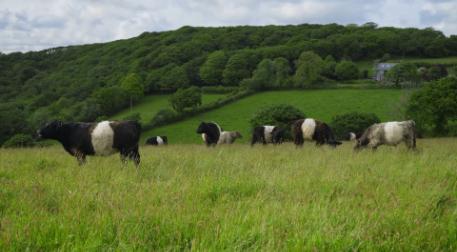 Written by Olivia Shave Instagram: @ecoewe
Written by Olivia Shave Instagram: @ecoewe
In one of the first trials of its kind in the UK, national potato supplier Branston is driving forward its plans to reach net zero by 2035 by trialing Volvo’s FM Electric 4x2 truck as part of its fleet. Transportation poses a huge environmental challenge to food suppliers because of the need to collect the fresh produce from growers, bring it to packing sites then deliver it to customers as rapidly as possible.

Following two years of research, Branston has today started a one-week trial of an electric-powered (EV) truck, with Crossroads Truck and Bus Ltd, the truck dealer for Volvo. Branston is one of the first businesses in the UK to do so in a real-world setting. The aim is to explore the mileage capabilities, charging practicalities and driving performance. The vehicle will be used to support both distribution
centre deliveries and farm pick-ups.


Simon Telfer, HR and logistics director at Branston, said: “A key part of our transport strategy is ensuring Branston’s transport not only works for us now but in the future. As a business we have ambitious goals to reach net zero and we’re passionate about delivering this for the transport section.
“Having researched the most viable alternative fuel options, we feel electric powered is the most practical for our needs. We approached Crossroads Truck and Bus Ltd back in 2021 and started working together to bring this trial to fruition. The trial will involve one truck, which has been delivered from Sweden, being utilised across various functions to give us a broad understanding of which tasks it is most suitable for.”
Currently, the vehicle can travel approximately 300km on one charge of the latest model of battery; generation three before it requires recharging. Branston is one of the first businesses in the UK trialing this most up-todate technology from Volvo to understand the current capabilities of one of the market-leading alternative fuels.
Simon added: “By 2035 we’re confident the batteries will have progressed to a point that our drivers can reach any location required and make a return journey without having to recharge, which is a key aspect of the feasibility of EV for Branston.
“This trial will allow us to understand any
challenges, such as the charging and cost, and what improvements we’ll need to make to transition our fleet within our timeframe. We know the vehicles aren’t where we need them to be to transition our full fleet yet but the purpose of undertaking the trial is to see how it drives and how it impacts our operations.”
The truck replicates the features and comfort of the traditional model currently used worldwide but is powered by electricity with a charging time of 2.5 hours when using maximum wattage input. The team will use the vehicle across three different shift patterns to get a good reflection of its suitability.

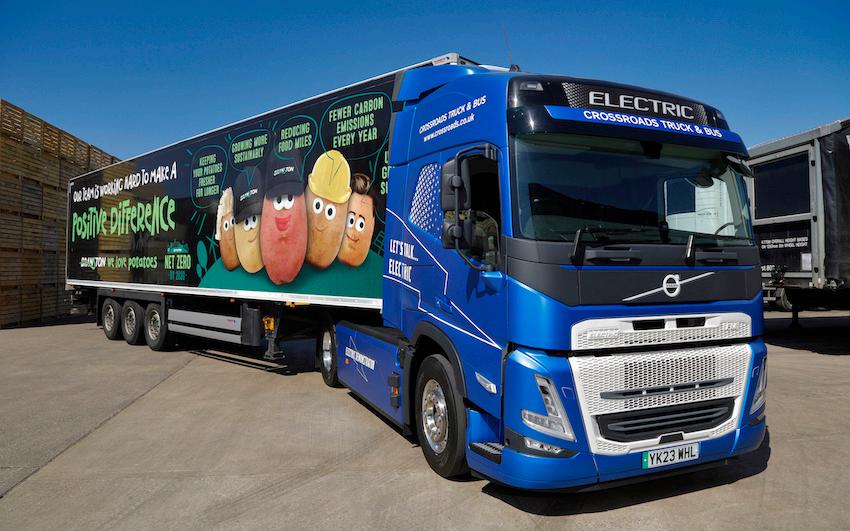
Lindsey Burrows, driver trainer will be responsible for supporting the transport team to utilise it as effectively as

possible.
Lindsey said: “EV is the future and the sooner we can get on board with seeing what options are out there, the better. It's an exciting time to be working in transportation as so much change is happening. I’ll be supporting the team in
and what the future of transportation looks like for Branston.”
ensuring their training is up to date and they’re comfortable with handling the vehicles, including the charging of them, which will be new to everyone.
“We’re looking forward to seeing how the vehicles work
With Volvo Trucks being the market leader with a full range of electric trucks across Europe, Adam North, area sales manager for Crossroads, is excited to be part of the journey with Branston in the shift for a more sustainable transport solution. He said: “The relationship between Crossroads Truck and Bus and Branston has been strong for over 20 years, not only does Branston understand how Volvo operates, but like us, they share the same view that compromise and investment is required to achieve our aligned net zero targets and the only way to achieve this is working together.”
For more information on Branston visit www.branston.com
Farming has always been about the attention to detail required to get the best from crops and livestock. In spite of generations of labour saving and information gathering devices, there is still nothing quite as good as the human eye at spotting the fine detail and making the correct decision on the day. This is particularly true of the new world of potato storage following the demise of CIPC.
Biox-M, along with the other new suppressants introduced since 2021, are volatile - they want to escape from the store. Keeping the store closed following treatment is enormously important if you wish to have good efficacy. That now seems to be pretty well understood, although we still come across the occasional incident of stores
being opened within a few hours of treatment to remove some freshly treated crop. Volatile products will escape if they are given the chance.
As with other sprout suppressants, there is a small risk of Biox-M condensing or coalescing in store if the crop temperature is not even throughout the store before treatment. Avoiding this risk should be an essential part of store management ahead of fogging. Refrigeration and ambient air exchange should be turned off on the day before treatment and the store should be managed to even up the crop temperature as a matter of routine. A temperature gradient across the store during fogging also risks an uneven distribution of the fog at the very moment that an even distribution is essential.
Every store is different and should be managed accordingly. It is always good practice to keep records, as detailed as possible, of crop and store condition during the storage season, but most importantly in the lead up and immediately following each treatment. A good set of records of store and crop temperatures, of the date(s) when the store is re-opened and refrigeration or ambient air exchange switched back on, allows the storekeeper to record and assess the factors that deliver the best efficacy, and to work towards extended treatment intervals, as well as to avoid unintended problems.
Biox-M has been in market for more than a decade, and a great many growers have become familiar with the need for attention to detail.
• Is a naturally occurring product, in widespread use in the food industry,
• Is approved for use on organic potato crops,
• Has no harvest interval or MRL beyond the one-day mandatory withholding period after treatment,
• Does not leave persistent residues in the fabric of stores and boxes used for storage,
• And is therefore suitable for use in stores, which may subsequently be used for the storage of other crops or seed potatoes,
• Is effective at higher storage temperatures, reducing the risk of acrylamide development when crop is processed,
• Sequesters carbon during growth, removing 1t of CO2 for every 1,000t of potatoes treated,
• And should be a component of the sustainability plan for every farm and every customer; effectively carbon neutral.






Anew generation of agtech has landed for potato growers in Australia thanks to Elders and UKbased harvest insights system HarvestEye.

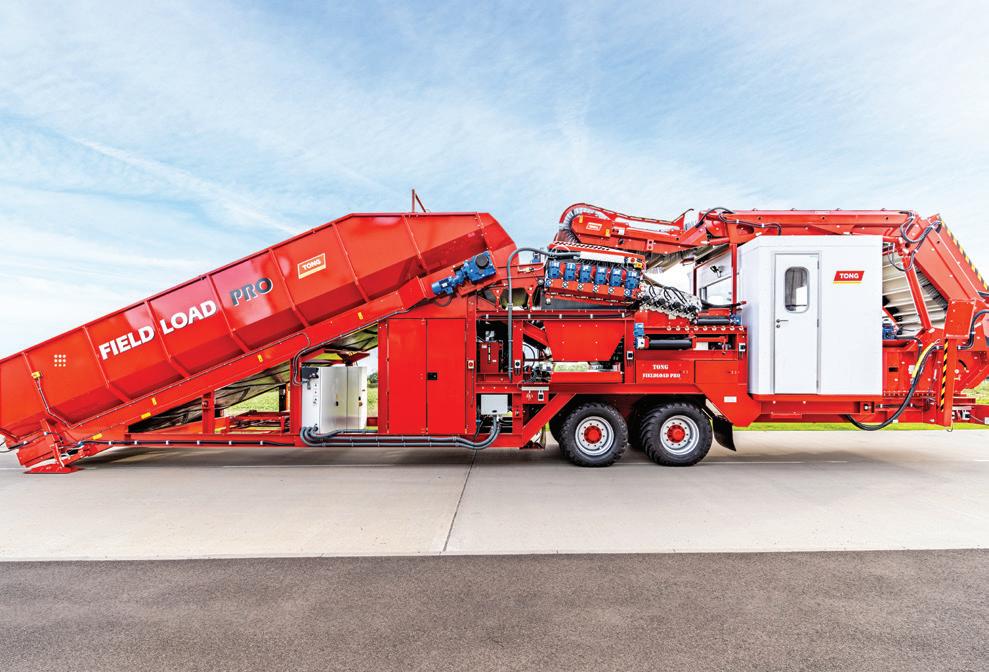
Elders is the only reseller of HarvestEye in Australia, and this exciting addition to the already extensive list of agtech available from Elders provides a level of data that has not been possible to achieve before.
Growers can now glean precise and detailed information about their produce in real time.
breakdown of size, count and relative yield through a field - a huge advantage in modern farming.
Unlike conventional sampling, HarvestEye has the capability to show the performance of the whole field, providing a much more accurate representation of a crop.


The data is captured and collated by a computer, which can even provide historic GPS tracking of a field over the years, allowing growers to make more informed decisions moving forward to improve efficiency, crop yield and uniformity.
With a more comprehensive understanding of the size and count for each field, the technology supports complex decision making for sustainable business growth.
Crop variability can also be mapped across specific field locations, providing targeted agronomic performance data. It assists growers to work towards specific customer requirements for each variety and, ultimately, increase profits.
Abe Montano, seed potato sales manager at Elders, said: “HarvestEye has demonstrated exceptional promise through extensive trials both in Australia and overseas.
“Using upcoming and latest agricultural technology to improve crop outcomes is commonplace in broadacre cropping, but it is not yet something that has been widely done in horticultural sectors.
“The technology is a game changer for growers who want to maximise efficiency and quality, and reduce waste.
HarvestEye can be fitted to any existing harvesting equipment, is simple to use and doesn’t interfere with the harvester. The data is then gathered and displayed on a tablet, making it easy to view, analyse and crossreference detailed data sets.

With applications designed for packers, processors and seed growers, this technology is set to change the way growers manage their entire operation. Not just for potatoes, HarvestEye can also be used for other root
vegetable crops, including onions.
Elders recognises the integral role technology plays in the agricultural industry and is pleased to be the only Australian reseller of HarvestEye.
Distribution of HarvestEye will complement Elders’ existing potato seed business, which currently holds IP for and produces over 21 varieties of potato seed and is supported by an extensive network of horticultural agronomists across Australia’s key growing regions.
Vidyanath (Vee) Gururajan, managing director of HarvestEye, said: “We have been working with the Elders team for more than a year and the result from this engagement is very encouraging.
“We are delighted to continue our work together with Elders and recently exhibited our 2.0 version of HarvestEye at the Hort Connections event. We look forward to increasing our customer base in Australia."
HarvestEye is available from Elders nationally. For more details, contact Elders Ballarat on (+61) 35336 9500.
For more information on HarvestEye and to speak with the team on subscription and leasing options for growers and enterprises, visit https://www.harvesteye.com/
The automotive, electronics and metal and machinery sectors are the largest employers of robots, and according to one automation pioneer, UK agriculture will soon join the list.
In 1961 General Motors installed the first industrial robot at its plant in Ewing Township, New Jersey. Created by American inventor George Devol, the Unimate robotic arm performed the dangerous task of moving and welding die castings.
pneumatic components supplier, I joined a vegetable bagging machinery manufacturer in 1984, " says Nick. "After 13 years in sales, I'd realised the importance of automation within agriculture and thought I could help the industry do things differently, so in 1996 I decided to leave and set up PACE Mechanical Handling.
"I guess my aim with PACE was very similar to Devol. Like all robotic manufacturers, we are trying to replicate a person's movements. We are looking to develop an automated version of the shoulder, elbow and wrist. It sounds simple, but it's taken years of refinement to engineer a reliable, efficient and affordable solution."
Today, PACE develops automated packaging and palletizing solutions by creating bespoke systems around three core products: the Gemini twin head weigher, Orion Weigher, Orion Weigher and sack placer and the CBC sack placer and stitcher line. PACE also integrates Motorman robots with custom-made grippers for pick and place packaging systems.
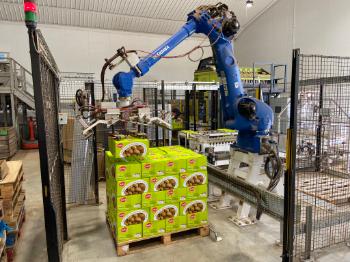
The gripper is the key component as it is the part of the robot that comes into contact with the packed produce. A different gripper will be needed when handling sacks of potatoes, lowprofile trays or crates.
Sixty-twoyears later, industry is still replicating Devol's intentions: sparing people from performing arduous, repetitive, mundane and dangerous tasks as part of the production process.
We don't know if developing the Unimate was driven by compassion and a desire to reduce workplace injuries or economics – taking people off the payroll while also improving efficiency and standardising quality. It doesn't really matter, and today robots are achieving all of this and helping agricultural companies continue to harvest and pack their produce despite desperate labour shortages.
The abundance of start-up companies in the last few years promoting robotics in agriculture could lead you to believe that the concept is relatively new. It's not. Nick Cesare set up PACE Mechanical Handling 27 years ago and has recently installed his 250th automated packaging system.
"After four years working for a plc and

"There are thousands of different types of gripper, but all of them are trying to do the same thing, replicate a person's fingers so that they can pinch or clamp the pack," says Nick. "This is really PACE's area of expertise. Devising new ways for the gripper to work and writing the software to ensure the process never misses a beat."
As well as engineering new grippers, Nick and his team have also developed a solution that can cope with the large amount of dust found in on-farm packhouses.
"We have incorporated a vacuum fan pump into our system. Other manufacturers use cheaper Venturi systems, which need a filter and if you have a filter, it can become blocked. We use a fan which doesn't block and makes the system ideal for use on farms."
One farm that has been using a PACE packaging system is OGE Chapman & Son. Established in 1957 by Oliver Chapman, the South Lincolnshire farm grows cereals, peas, sugar beet and potatoes, with the latter being
packed on-site and sold to fish and chip shops across the country.
"We installed the PACE palletizing system five years ago, and it was one of the best things we've done," says Jamie Chapman. "We needed to reduce our labour costs, so, with Nick's help, we installed a sack placer and stitch line.

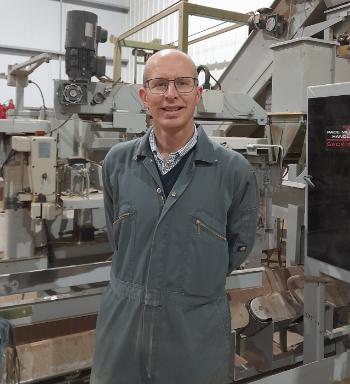
"Our potatoes come into a hopper, over the grader, through Nick's equipment which packs them into 25kg sacks, which are then placed on the pallet.
"By installing the sack placer, we no longer needed a man there to do the job. As that person was checking the quality of the stitching, we installed a stitch line too. Stitching can be temperamental, but the PACE machine never lets us down."
As well as reducing labour, the PACE solution
has increased Chapman & Son's capacity and throughput.
"On a good day, we can have up to 100 tonnes being packed. Before we automated the process, this would have been two days' work! Nick's double-headed weigher is also more accurate than our previous weigher and increases our output."
Obviously, the cost of upgrading or introducing new equipment is a key consideration in the current economic climate. Like most technology, though, prices are coming down, and even with increasing energy costs, the sophistication of the robots is removing this concern to a degree.
"The latest Motorman robots only need 0.5kwh to operate, and they only draw power when they're moving," explains Nick. "If you look at how a robot operates, it will pause between actions. At this point, it's not drawing power, so it isn't using electricity. Unlike other machines, robots are built to last; we know their lifespan is over 30 years. The lifetime cost of a system that might be £120,000 is actually very reasonable, especially when you consider that they don't take holidays or fall ill, and they're completely reliable. Every process is identical; there's no deviation or difference, which you can get when a person performs a repetitive task."


Agriculture is a repetitive process and has, for many years, relied on people to plant, harvest, sort, and pack produce. The impact of Brexit, increased employment costs and increasing pressure to adopt precision farming methods have spurred UK agriculture into what it does best – innovating and finding a way to do more with less. These factors have influenced Nick's opinion that within a decade, robots will be just as common in agriculture as they are in the automotive industry.
"We are seeing the large vegetable handling machinery manufacturers embrace optical sorting – these are robotic eyes. We already have robotic planters, weeders and harvesting. Drones are being used to assess the quality of crops, and with over 250 farms already using our systems to pack their produce, robots are common in the packhouse. It won't be long until there is a robot on every farm and in every packhouse, especially as fewer people want to do this type of work."
If you're interested in learning more about automated packing and robot palletizing, look atwww.robotpalletizing.co.uk
Soaring costs of production, as a result of the global turmoil of the past 18 months, has contributed to the poor mental health of farmers and food producers, says a recent survey from the NFU1. Over 68% of farmers said that spiralling input costs – the cost of energy, fuel and fertiliser –has had a negative impact on their mental health.
This new survey data also said that 61% of farmers felt unfairness in the supply chain has negatively impacted their mental health and almost 50% said rural crime is affecting their wellbeing. This is evidenced by the rising number of tractor GPS thefts seen in recent weeks.
The NFU published the data ahead of a parliamentary event

convened to kickstart the conversation about making the mental health of the nation's food producers a priority. MPs will have the opportunity to speak to and learn from farming charities and campaigners, helping farmers out in the field day-to-day, and farmers with their own mental health experiences.
NFU Vice President David Exwood said: "Working in the farming industry is one of the most rewarding jobs in the world. We produce high-quality, climatefriendly food for the nation while shaping some of the country's most beautiful landscapes. But as has been shown by our distressing survey results, the pressures are incredibly challenging too.
"Our survey pinpoints some of the root causes affecting rural mental health – economic and
political uncertainty - and we are calling on government to continue taking steps to address these issues to reduce the stress farmers are facing. This is backed up by a recent report from the Efra Select Committee which called for greater joined-up rural mental health planning and action from government, and we agree with these calls.
"While we are starting to see a culture change within our sector, where talking about mental health is becoming more and more accepted, there are still too many farmers and growers simply ignoring the signsand struggling on in silence. I hope today's event shows there is support out there as we mark the start of an important conversation."


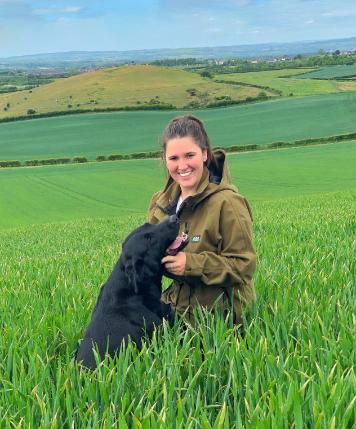


 By Tania Coxon
By Tania Coxon
ooking back on my childhood many of my happy memories heavily feature two passions, sports and farming. From what I can remember if I wasn’t on a sports pitch, I was most definitely on the farm helping my dad in any way I could during every school holiday. Still to this day for those that know me, these are probably the two things that come to mind when they talk about who I am and what I do. Although now, they would most definitely mention shooting, which has become a huge part of my life especially since setting up ‘The Country Girls UK’.
Having grown up with two older siblings we were always a very competitive household. My parents were unbelievably supportive and spent most of their weekends driving us around the country to various sporting events. Safe to say as the youngest child, the day I passed my driving test was a very happy day in the Coxon
household. When it came to deciding what I would do after school, I realised I was going to have to decide what was more important. For my A-levels I attended a specialist sports school down in Somerset called Millfield and spent every day either on a hockey pitch or a lacrosse field. Off the back of this, I was offered two scholarships to head to America and fulfil my sporting dreams. But, when it came to the crunch, I realised that although my international sporting career had been incredible, when it came to deciding what I wanted to do for the rest of my life, farming had my heart. Fast forward a crazy harvest at home and come September 2015, my car was packed, and I was heading to The Royal Agricultural University.
Safe to say in hindsight that was one of the best decisions of my life. I absolutely loved university, I met some of my closest friends and learnt an incredible amount about the farming industry. In my final year, I was lucky enough to captain our RAU team for the Velcourt and Hutchinsons Cereals challenge, a competition we went on to win and in 2018, I graduated with
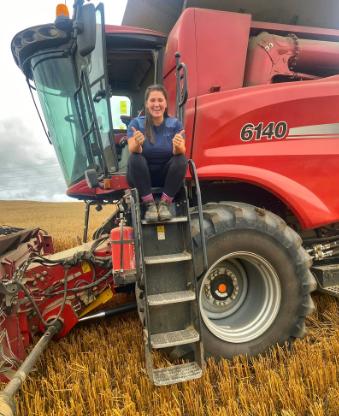
BSC Honours in Agriculture and Farm Business Management whilst gaining the graduate award for ‘The Best Prospective Farmer’. It’s a shame they didn’t have an award for the most cider consumed because that award would have summed up my time at Cirencester better, but I’ll take it.
After graduating from Ciren, I returned home to help my dad run our family arable farm full time. We farm a couple of thousand acres around Sunderland and County Durham with a mixture of owned, rented and Farm Business Tenancy agreement land. We have two lads that work for us full time, one of whom has worked with us for the past 5 years and has just graduated from his apprenticeship at Askham Bryan college and will continue to work for us full time going forward, and the other whom has worked with us for over 35 years. During harvest we usually have a team of around 7/8 depending on the crop rotation for corn carting and cultivating work. In terms of machinery on our farm we run an all CASE IH fleet, we have our ‘Premiership’ team which includes our Axial Flow combines, Magnums and Pumas and our ‘Championship’ team which includes the likes of our Maxxums and MXUs which come into their prime throughout harvest. I have been lucky enough to have the teams from Grassmen and FarmFlix do some epic videoing over the last few harvests, so if you want to see some amazing footage of the kit in action head over to their websites.
Our cropping rotation includes first and second
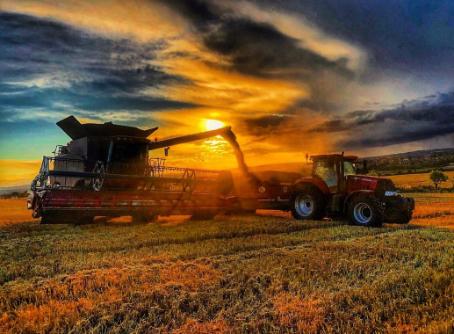


Wheats, winter and spring Barley and winter and spring Naked Oats. Oilseed rape will be coming back into the rotation at some point in the future but at this moment in time our land is on an OSR break, due to well… OSR being OSR. We are big fans of cover cropping and are part of the new Sustainable Farming Incentive scheme and have been part of Countryside Stewardship schemes since they started in 90s. However, farming on the Urban fringe, one of the biggest problems we have is rural crime. So, when it comes to cover cropping, we do have to be strategic where we put cover crops / margins due to them being used as “pretty picnic blocks” and “rounders pitches” during the summer, but we do as much as we can, where we can. If you want to know more about the rural crime we face on our farm, I talk a lot about this on my Instagram page @countrygirl_andlabradors where you can check out the highlights reel of just how bad it really is. This includes the likes of daily fly tipping, trees being chopped down to make dens in our woodlands, theft, hourly trespassing, lamping, fires (5 of which this harvest alone) the list goes on. Farming on the urban fringe isn’t for the faint hearted and is something the rural crime teams need to take more seriously. This is a message I will continue to push on every
platform given the chance. When the BBC news team came out to interview me for a rural crime special back in 2021, dad and I sat down to calculate our rural crime costs, the figure you ask? We spent around £20,000 on rural crime throughout lockdown alone. This money came directly out of our pocket. How can farmers be expected to continue this way, without any support and trust me when I say, we’re not on our own. It’s something that needs to be talked about and pushed more because it really is shocking when you get into the statistics.
Talking of getting the message out there, I was fortunate enough to be selected as part of the NFUs North East Student ambassador programme in 2020. Due to COVID the programme latest 2 years which, was a blessing for our cohort as it meant more interesting farm trips and talks even if it was all virtual in the first year. The main thing that I took away from the programme is that the NFU really is there to try and help farmers. As a farming industry we would in my opinion, be in a much worse state without them. Off the back of the ambassador programme, I wanted to get more involved with helping to promote British farming and now sit as Vice Chair for our local NFU branch.





Continuing to spread the word about British Farming is a responsibility we as farmers all need to take, be that through social media, discussion groups, speaking at local shows or heading into schools to engage and talk to kids (The NFU Education Team are fantastic at training people up to do this). It doesn’t matter what level you are comfortable with, everyone needs to do their bit to help promote British Farming for what it truly is. My personal favourite is social media, I post a lot about the real side of farming and people are genuinely so interested to see what is going on. Nearly 28,000 people are now following my little farming journey through Instagram and the opportunities it has provided me with along the way have made it well worth the time.
One of those opportunities includes setting up The Country Girls UK (CGUK). The CGUK is an events business that started through Instagram by connecting ladies in England, Scotland and Wales. Over the past three years this has developed into a successful membership community with an average of 2 events every weekend of the year. Our large
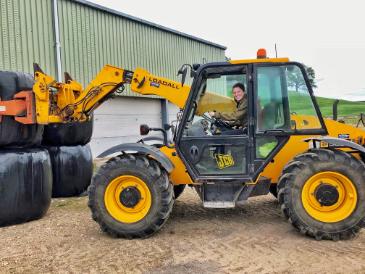
array of events includes shotgun and rifle shooting, fishing, gundog training, falconry, polo, and many social events for ladies of all abilities, backgrounds, and ages. The Country Girls UK has grown astronomically, and we now have a team of 14 with hundreds of incredible members and none of that would have been possible without taking that first step setting up my Instagram page to try and help promote British Farming back in 2018.

As harvest fast approaches, I




am really looking forward to the next few months and seeing what opportunities and challenges are going to arise. One thing I really want to get across with the article I’ve written today is that farming is never black and white, and I think it’s exciting that everyone has their own edge and I personally love hearing about what other people are doing to push the industry forward. If that is through different farming techniques, diversification, community groups, innovative technology or any other avenue. There is so much more to farming and our community than what meets the eye and I honestly do think the future is extremely exciting for British Agriculture.
Follow Tania on Instagram @thecountrygirlsuk and @countrygirl_andlabradors
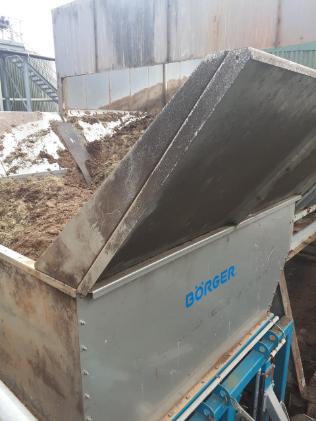
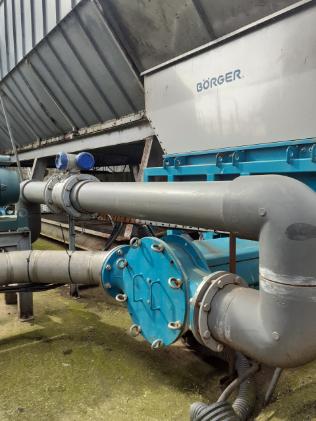
farmer in Wales who decided to diversify into renewable energy could have been tempted perhaps to have built as big an anaerobic digestion plant as possible, but his attention to the economies of scale has paid off.
The biogas plant, from which an impressive 80% of clean, renewable energy is exported, has slotted right into the existing land, rather than the farm having to change to accommodate the new technology.
Seven years ago, the price of energy wasn’t the main driver. The farm had just reached a point where it made sense to diversify, control its costs, and not have all its eggs in the one basket. A decade ago, it had invested in a 250kW wind turbine, and moving forward with a biogas plant that could require plenty of extra work, simplicity
was the aim, but with maximum output.
Producing grass silage and spring barley on the estate, the farmer also has his beef herd to look after, plus 1200 sheep. So, part of that wish for simplicity and importantly, easy maintenance, came in the form of investing in an automated Powerfeed unit from Borger, to convey the organic feedstock of crops, manure and chicken litter.
David Brown, Borger UK’s Managing Director, said: “Our customer did his homework properly; visiting farms to see our existing units in operation, and find out why it had been so strongly recommended. Feedstock for biogas is always going to cause wear and tear on equipment, so he also wanted a UK company that wouldn’t keep them waiting for spare parts.”
The Powerfeed setup, which includes a Borger rotary lobe pump, can integrate into an existing biogas system at an appropriate point in the pressure pipe system to convey the feedstock into
the flow pipeline. It is a closedsystem, so it prevents odours from escaping and prevents gas leaks. Only light agitation in the tank is required, so power consumption is kept to a minimum.


Brown added: “After seeing how the process worked for our feedstock, we worked closely with the farmer to slightly modify the Powerfeed, so that it could operate in reverse as well as forwards. When needed, this helps keep everything moving better and prevents any blocking.”
The farmer built a filling hopper to supply the organic matter to the Powerfeed, which is designed with an auger shaft that also breaks down the feedstock and compresses it towards the press channel. This leads to the flushing unit, which is connected to the flow pipeline. The clumps that form in the press channel

have the effect of a selfrenewing seal. The substrates obtain a larger surface area, removing trapped air.

Every two and a half to three hours, 2.5 tonnes of organic matter at the farm is fed through by the automated system for the biogas plant, which has primary and secondary tanks (both 1200m3). The farm also benefits from two boilers, which bring the total power output up to 450kW. Once again, that important planning and economies of scale came into play as the existing infrastructure for the wind turbine helped minimise gasto-grid connection costs for the exported energy.
David Brown from Borger continued: “The plant produces plenty of power, but with the Borger Powerfeed as part of the set-up, the farm also benefits from very good quality digestate at the end of the process. They add farmyard
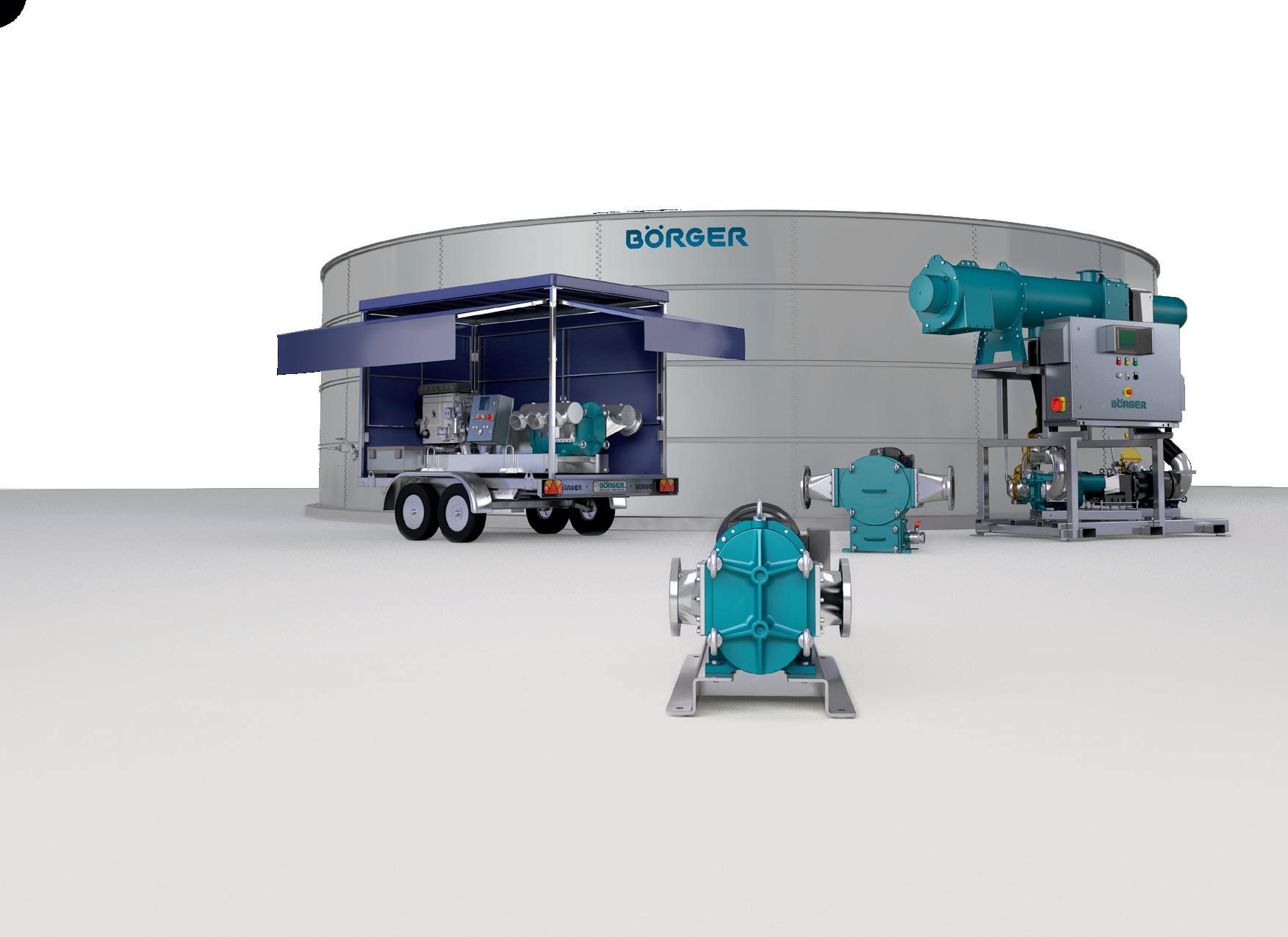
manure to the feedstock, which might not produce that much gas, but is very good for the biology. The soil there now is so much

healthier. You can see loads more activity. It’s full or worms! The farm no longer has to buy fertiliser, which as all farmers know, has had a huge increase in price. This has become a big part of being able to keep costs under control. Also, the low pH of the fertiliser at around four to five meant that what they were adding was too acidic, whereas the biogas digestate at a pH of around 7.8 acts more like an alkaline. The whole plant can be monitored remotely. There are very few moving parts in the Borger Powerfeed, so there isn’t excessive wear, but running a biogas plant properly is a 24/7 job, so there is a complete set of spares available to prevent any downtime. “
Borger UK
01902 798 977
www.boerger.com
uk@boerger.com
anbury-based Powerline Electric Motors has completed the refurbishment of its latest batch of Landia slurry pumps, including one unit that has been in operation for almost 25 years. With its ongoing investment in new equipment and growing number of apprentices, Powerline has seen a significant increase in demand for its repair services, which not only help prolong the lifetime of pumps, but also improve efficiencies.
Landia’s Paul Davies, commented:” Although we have our own nationwide service team,

industrial and agricultural wastewater treatment installations and animal slurry management.
Giles Russell for Midland Slurry Systems, said: “We have total confidence in the Landia pumps and mixers that we’ve used for many years. In slurry pits, equipment has to be tough, but it must be maintained properly too. After our pumps have been in for service with Powerline, they’re like new!”
Powerline’s skill in overhauling pumps is first-class. We are pleased to see our equipment continue to provide excellent, long-term service.”
Richard Thompson of Powerline added: “We’re not in the habit of disappointing our customers. Landia make very robust pumps and they always have a good stock of spares on hand for us, so that we can offer the best possible turnaround.”
Landia and Powerline also both work closely with Shipston-on-Stour-based Midland Slurry Systems, who specialise in the supply and maintenance of
In addition to the farming sector, Powerline also provides high-quality repairs, rewinding and refurbishment of electric motors, pumps, fans, and gearboxes to a wide variety of industries, such as manufacturers of foods, plastics, and automotive, as well as servicing customers working in chemicals, utilities, healthcare, construction, and Oxfordshire-based F1.
www.landiaworld.com



www.PowerlineElectricMotors.co.uk
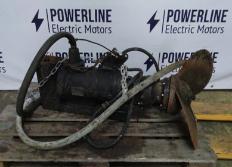

www.midlandslurrysystems.co.uk

griconnect, the UK’s largest agricultural information business, has enhanced its portfolio with the acquisition of Low Carbon Agriculture (LCA) from Renewable Energy Events Ltd.
LCA is comprised of four co-located events: Energy Now Expo, Environmental Business Expo, Farm Technology Expo, and Low Emissions Vehicle Expo.
These conference-led events will become a part of the Agriconnect business. Agriconnect publishes Farmers Guardian, plus other titles, and is the organiser of industry-leading events such as LAMMA, Croptec, Future Farming Expo, and Farm Business Innovation.
Sustainability and net zero are crucial topics within agriculture and are at the forefront of emerging legislation within the sector, especially as governments continue to align farming policy with environmental best practice.
With a growing demand for information from farmers in this area, the partnership between LCA and Agriconnect will help enable more than ever before to guide their businesses through the energy, environmental and farming transition.
LCA founder, David Jacobmeyer, will work in partnership with Agriconnect to continue developing the event within the farming community as well as providing information about renewables, low carbon solutions, environmental best practice and the agricultural transition.
David Jacobmeyer said: “Since launching Energy Now Expo in 2010, later rebranded to Low Carbon Agriculture Show, we’ve seen tremendous growth and interest in both clean energy and low carbon sectors.
“The farming community has a critical role to play in reaching Net Zero, and there is an ever-growing need for farmers and landowners to come together to find ways to
boost production sustainably, while helping to address climate change.
“I am looking forward to both the growth of Low Carbon Agriculture and working closely with Agriconnect to help guide farmers through this huge period of change.”
Nick Ornstien, Managing Director of Agriconnect, added:

“Agriconnect prides itself on being not just ‘for’ the farming community but ‘of’ the community. Within our own teams, as well as throughout our diverse customer community, we’ve seen increasing interest in information about sustainable practices and plans in farming.
“That’s why I am so delighted to have LCA become a part of Agriconnect and I am truly looking forward to partnering with David to continue our focus on this important sector in farming.”
s part of the delivery of one of the Prime Minister’s five priorities to grow the economy, additional support to help farmers access private investment to support nature recovery on their farm.
The first ever 'Nature for Finance' event will bring together farmers, land managers, investors and conservation experts to identify new investment opportunities that drive forward actions to mobilise investment in nature recovery while continuing to keep the nation fed.
At the event, held at 10 Downing Street, the Secretary of State for Environment, Food and Rural Affairs Thérèse Coffey will announce the intention to launch an additional round of the Natural Environment Investment Readiness Fund (NEIRF) later this year to help farmers address barriers to accessing private investment to help nature’s recovery. This round will be the first time the NEIRF focuses specifically on the farming sector, helping farmers to come together at a landscape scale to combine their offer to investors, and enabling more types of farmer to access and benefit from nature markets.
Secretary of State for Environment, Food and Rural Affairs, Thérèse Coffey said:
“Food production and enhancing the environment go hand in hand. We must continue to support farmers to keep our nation fed while also safeguarding the
valuable biodiversity and landscapes we rely on.
“Today’s event is an important step forward in bringing together farmers and financiers to invest in nature and unlock new opportunities to improve the productivity, profitability and sustainability of farm businesses.”
Food production relies on a healthy and thriving natural environment and nature markets offer a new way for farmers to generate income alongside food production. To date, 86 projects across England have received development grants of up to £100,000 through two competitive rounds of the £10 million NEIRF in 2021 and 2022.
Today’s event follows last month’s UK Farm to Fork Summit at No10, at which representatives from the whole food supply chain came together to identify ways to boost growth, drive innovation and improve sustainability so that we boost food production alongside delivering nature recovery for our countryside.
The NEIRF funds projects that have the potential to produce revenue from the benefits nature provides to attract and repay investment, as well as projects able to produce an investment model that can be scaled up and reproduced.
The Wendling Beck Exemplar Project, a collaboration between private landowners, local authorities, environmental NGOs, and Anglian Water, has already benefitted from NEIRF support. This aims to transform land use for environmental

benefit while also selling ecosystem services such as Biodiversity Net Gain.
Glenn Anderson, Project Lead of The Wendling Beck Exemplar Project said:
“Wendling Beck is a pathfinder project for financing land-use change through new nature markets. Projects like Wendling Beck are critical in safeguarding long-term food security - through mitigating existential challenges to climate, water and biodiversity - and enhancing the national natural capital reserves which underpin our economy.
“The project was fortunate to receive funding from the NEIRF, which supported the projects feasibility and design at a critical time. The funding enabled us to consolidate the project structure and lay some important foundations on which the project now stands.”
The Secretary of State will also announce the start of the piloting phase of a new version of the Green Finance Institute's (GFI) investment readiness toolkit which will provide a tailored framework offering farmers valuable advice on how to create investable nature finance projects. In the pilot phase, the GFI will gather insights from stakeholders – including those in attendance at the event today – to ensure the toolkit meets the specific needs of farmers.
The government will also consult later this year on specific steps and interventions needed to mobilise additional nature finance through voluntary markets and protect against the risk of greenwashing,
seeking input from experts in finance, business, environment, and farming sectors.
The UK was the first major country to publish a green finance strategy in 2019 which was updated this year alongside a new Nature Markets Framework. Significant progress has been made in integrating nature into the economy, including statutory targets for environmental improvement and the development of a policy framework for scaling up nature markets. Defra’s new partnership with the British Standards Institution will ensure the adoption of sound scientific standards underpinning nature investments and avoiding greenwashing.
"The opportunities for land managers to engage directly with finance professionals, tech providers and local authorities around environmental markets are rare, especially at this early stage of the market. So to be afforded that chance through the Essex County Council led NEIRF project is exciting.
"This could be game changing for farms, as once the income side is proven it opens the door for all kinds of support for transition to alternative, more sustainable, land use choices. It's all about having more choice, especially beyond commodity markets, now and in the future."
hat farming is a physically arduous occupation is in no way debatable. The hours are long, the schedules demanding and, even with the many mechanical and technological innovations that have been introduced over the years, the work can be backbreaking.
But it is the mental stresses and strains of agricultural life, both arable and pastoral, that were the focus of a 2020/2021 report from the Farm Safety Foundation. The report revealed that 88% of farmers below the age of 40 identified poor mental health as “the biggest hidden problem faced by farmers today”. This is an astounding increase of 82% when compared to just two years earlier.
Even more distressing is the number of people from the farming and agricultural industry who have taken their own lives. According to the Office of National Statistics, there were 44 suicides in the sector in 2020. That’s ten more lives lost than as a result of fatal injury due to farm-related accidents.
We can speculate as to the causes of these tragedies. The double-blow of Brexit and Covid19 is almost certainly a factor. Government figures show the total income from farming fell by £1.1bn between 2019 and 2021 as core markets (e.g. the catering sector) went into lockdown. Furthermore, crops have been left to rot due to a lack of migrant seasonal workers brought about by restrictions to freedom of movement.
However, such speculation is less important than identifying a course of action to deal with this burgeoning crisis. Thankfully there is no shortage of initiatives. At the forefront of these efforts are the authors of the report, the
Farming Safety Council, known more colloquially as the Yellow Wellies. In February of this year, they launched their fifth ‘Mind Your Head’ campaign which deals with identifying, treating and preventing mental health problems in farming, with an emphasis on overturning the stigma associated with everything from depression to PTSD.

and where improvements might be made to enhance employee wellbeing. To encourage participation in the initial survey, Steadmans offered to donate £2 per questionnaire to the Disasters Emergency Committee’s Ukraine Humanitarian Appeal.
Recently, during Mental health Awareness week in May, the “Spirit” team assembled a bank of resources, and communicated a series of daily bulletins throughout the workforce, offering simple tips on a range of subjects such as mindfulness, relaxation, reducing stress, as well as a general focus on workplace wellbeing.
Steadmans, one of the UK’s leading suppliers of roofing and cladding profiles to the agricultural sector, are also investing a great deal of time and effort into improving the mental wellbeing of their workforce.

The management team at Steadmans, supported by a passionate core of colleagues who are committed to cultural excellence, have created and implemented ‘Steadmans Spirit’.
“Spirit is intended to be a colleague community that encourages everyone to get involved in shaping the way that we look after ourselves and each other and how we communicate effectively within the business.
“Spirit has four core aims. To promote wellbeing, to encourage participation and innovation, to recognise excellence, and to celebrate diversity and inclusion.”
To this end, an ongoing series of questionnaires are being rolled out to the Steadmans’ workforce to identify what they feel to be the issues and challenges that might affect their mental health,
As continued feedback is gathered from across the business, Steadmans have now started planning what they hope to be the first of many workshops, each themed to key directly into the four pillars of “Spirit”.

Darren Hall, Commercial Director at Steadmans said “Our mission with this initiative is to ensure that every colleague goes home feeling that their voice has been heard.
“Our customers across all sectors rely on us to provide a consistent and responsive service, and as such our working environment across all departments is often fast paced, reactive and challenging.
“We are fortunate to enjoy a large and diverse colleague community, spanning over 3 sites throughout Cumbria and Scotland so it’s vital that we’re communicating effectively and meaningfully with our teams. We believe that workplace wellbeing is of the utmost importance to the sustainable success of our people and our business. We are wholeheartedly committed to providing an unrivalled colleague and customer experience.”


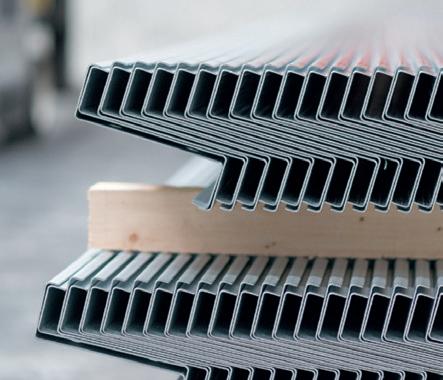

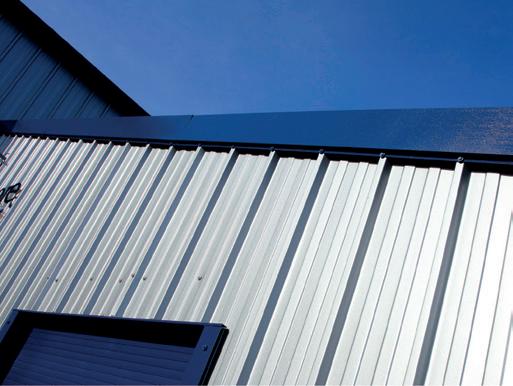

omedian and author Mark Watson is to host the RIDBA Building Awards 2023.
Best known for being one of the UK’s leading live comedians, he is also a writer, producer and director.
A TV and radio regular, Mark has appeared on almost every panel show going from Have I Got News… and Mock the Week to 8 Out of 10 Cats and Would I Lie To You.
He’s also appeared on This Week, Live at the Apollo, Taskmaster, and celebrity editions of Mastermind, Pointless and Bear Gryll’s Celebrity Island.
Mark Watson will host the RIDBA Building Awards at the Graduate Hotel, in Cambridge, on Friday September 22. Due to high demand for tickets, only sponsors and those who have a shortlisted
entry are able to book to attend the awards evening. Clickhereto book.
Clickhereto see the shortlisted entries for the awards.
Thank you to all of those members who took the time to enter and thank you to those members who are sponsoring the event.
AJN Steelstockwill headline sponsor the awards.

The premium sponsors areJoseph Ash Galvanizing,Barrett SteelandSTRUMIS. The event sponsors areSteadmansandKingspan.
You can see the winners of the RIDBA Building Awards 2021here.
record number of entries across eight categories have been whittled down to form the RIDBA Building Awards 2023 shortlist.
The winners will be announced at an awards evening hosted by comedian and author Mark Watson at the Graduate Hotel, in Cambridge, on Friday, September 22.
THE RIDBA BUILDING AWARDS 2023
SHORTLIST IS:
COMMERCIAL CATEGORY
• Cambridgeshire Fire & Rescue Station,A.C. Bacon Engineering
• CJ Cox Limited New Workshop,Rose Engineering
• Roundhouse Play Area,S&A Fabrications
• Franks Ice Cream,Shufflebottom
• Morgan Sindall Merthyr Bus Station,Shufflebottom
• Tong Engineering,Timmins Engineering
FARM STORAGE
• Replacement general purpose building,A.C. Bacon Engineering
• S. Batty & Son,Colley Farm Buildings
• New grain store facility,LF Pearce & Son
• Sakata UK Ltd,Timmins Engineering
• Sir Richard Sutton Estates,Timmins Engineering
• Forestry workshop,Wareing Buildings
INDUSTRIAL AND PRODUCTION
• Bacton Transport,M D Anthony
• Dawson’s Wharf pellet bund,S&A Fabrications
• Smart Systems, Shufflebottom
• Cropper Close, Henco International,Wareing Buildings
• Graham & Brown,Wareing Buildings
• McMurrays Haulage,Wareing Buildings
LIVESTOCK
• Ben Pauling Racing, Naunton Downs,D Jones Welding
• Oxey Farm suckler building,M D Anthony
• West Midlands Safari Park,Minshall Construction
• Sunnylands,Powell & Co Construction
• Ash Holt Barns,Timmins Engineering
• Pembertons cattle shed,Wareing Buildings
RESIDENTIAL AND OFFICES
• The Property Hub,M D Anthony
• Island estates,Shufflebottom
• Luda barns,Timmins Engineering
• Luxury residential property in Poulton-leFylde,Wareing Buildings
NEW PRODUCT OR SERVICE
• Halo Solar,Ash & Lacy
• Voortman V807,Cutmaster Machines
• Innovative pig lift,Designeering
• STRUMIS e-learning, STRUMIS

• Tekla PowerFab 2023, Trimble
• Hybrid Supa Slat,Wolfenden Concrete
Prizes will also be handed out for outstanding workmanship and training.
The judges of the awards are RIDBA’s technical consultant Martin Heywood, RIDBA’s livestock consultant Jamie Robertson, working at height expert Joe Black and LEAF Marque farmer Andrew Brown.
Tickets have been in extremely high demand. As a result, from now on bookings for the awards evening will only be available to those who have made the shortlist.
Thank you to all of those members who took the time to enter and thank you to those members who are sponsoring the event.AJN Steelstockwill headline sponsor the awards. The premium sponsors areJoseph Ash Galvanizing,Barrett SteelandSTRUMIS. The event sponsors areSteadmansandKingspan.
You can read more about the awards in thesummer 2023 edition of the RIDBA Journal.
ATVTrac is urging farmers to take security more seriously, as ATV and side-by-side theft continues to rise across many regions of the country. Aside from the more obvious and conventional reasons behind theft, supply chain shortages surfaced during and after the pandemic, causing longer lead times and of course greater demand on the used market. As a result, ATV and equipment thefts rose as the less scrupulous saw greater opportunity.
NFU Mutual reports that in 2022, there was a 26% increase in the annual cost of ATV theft in the UK, with the total cost of theft reaching more than £2.7m. Sheep Farmers seem to be particularly vulnerable too, with many thefts reported around the lambing season, when farmers and their machinery is very visible.
But despite this relative doom and gloom, ATVTrac continues to lead
the fight against rural crime, thanks to its intelligent functionality that protects farm machinery 24/7, 365 days a year.
The firm’s Rupert Archer-Smith, explained, “The trend is pretty obvious when you think about it. When product is hard to come by, the thieves see a way to make money. Unfortunately, we as an industry have been too slow to respond to theft, and while our tracking product is a very real and valid tool in the fight against rural crime, so is simple education. It may sound obvious, but all too often simple actions like being aware of who is around, removing ignition keys, putting an ATV away at night or just locking it up in a barn are enough. More than anything we just need to be aware.”
Of course, there will always be the more determined thieves, which is why ATVTrac now protects many ATV and side-by-side machines across the UK, and why manufacturers such as Can-AM, CF
Moto, Corvus, Kawasaki, Polaris, Suzuki, Kymco and many others endorse ATVTrac.
With flexible installation on many machine types, and using multi-tier technology, ATVTrac offers real-time location information, while informing the owner of unauthorised movement through text, email and phone call.
Extra features include live tracking and machine over, helping with safety and duty of care by covering lone worker policies at the same time. Other useful functions include live battery information, service notifications, as well as journey history and usage reports.
Should a theft occur, ATVTrac has a 24-hour monitored call center to track the device, liaising with police or partner company Securitas to recover the stolen asset and return it in a hassle-free way.
ATVTrac currently boasts a 98% recovery rate.

Last week (15th June 2023) at the UK's premier plant machinery show, Plantworx in Peterborough, the announcement of CESAR's 600,000th protected machine was made. Suneeta Johal, CEO of show hosts, the Construction Equipment Association, was on hand to present to MANITOU a symbolic CESAR ID plate numbered 600,000.

Receiving the award were Mark Ormond, Managing Director, Peter Smyth, Sales Director, David Clark, Product Manager and Chloe Tapp, Marketing Manager.

Mark Ormond said, 'We have been supporters of the CESAR Scheme since its inception and recognise its part in reducing theft. We are delighted to be the manufacturer of the machine which has reached this incredible milestone and will continue to support CESAR!'

CESAR's offering was strengthened by the addition of CESAR ECV which allows quick and easy confirmation of a machine's emissions status. More recently the introduction of the next generation of Ultra HighFrequency RFID transponder means that in the market today there really is no competition to CESAR.
Kevin Howells, MD of DATATAG ID, the technology partner to the CESAR Scheme had this to say 'I want to thank MANITOU for their continued support of the CESAR Scheme, they were one of the first to recognise the benefit to their customers and continue to be an ambassador tor the scheme. He went on to say CESAR ECV has been a real boost to the value of the scheme and is mandated on SO many major infrastructure schemes here in the UK. Our nextgeneration UHF transponders, unique in their security features, are the latest innovation that keeps the CESAR Scheme and its DATATAG technology ahead of any competitors.
HSE advises that half of farming fatalities involving moving equipment could be prevented by checking and maintaining key components.
According to the new HSE Work Right Agriculture campaign, moving vehicles are the highest cause of deaths in British farming. These incidents account for 30% of all fatal injuries over the past 5 years.
Crucially, the HSE has advised that 50% of deaths involving moving vehicles on British farms could have been prevented if elements such as brakes and steering were maintained. (For more information visit https:// workright.campaign.gov.uk/ campaigns/safe-vehicle/)
Lifting equipment such as tractors, telehandlers and forklifts are regularly used in farming, and legally require Thorough Examinations (LOLER) at least once a year in accordance with the
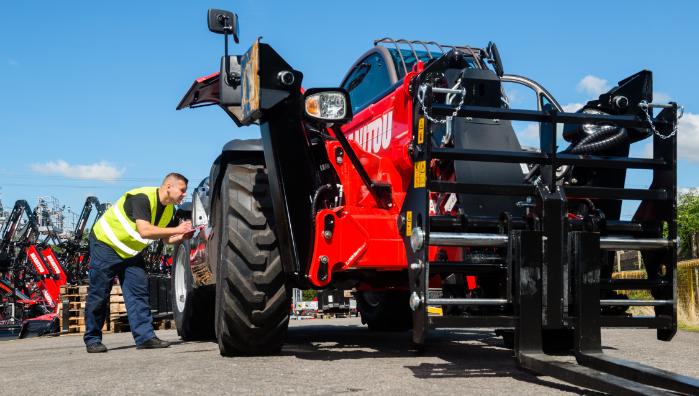
law. However, the traditional LOLER inspection does not include a number of critically important components and assemblies such as brakes, steering, tyres, etc.
Explaining the situation, Geoff Martin, Chairman of industry accrediting body CFTS, says: “Correct inspections and the associated maintenance programmes can literally save lives. That’s why it is so important to check your existing provision and ensure your regular Thorough Examination is truly thorough. Sadly, the majority aren’t, so my advice is to check what’s covered by your current provider and, if necessary, make the switch to one that embraces the requirements of PUWER as well as LOLER – like that developed by CFTS.
“A Thorough Examination is vital in every industry but especially in agriculture which has the highest number of fatal and serious injuries of all industry sectors in Great Britain. According to figures from HSE, over the past 5 years the
average fatal incident rate in agriculture is 21 times higher than the average across all other industries.
“And let’s remember, each one of those accidents comes at a huge personal cost, along with serious financial implications.
“By scheduling regular Thorough Examinations, and ensuring that equipment is consistently maintained, owners can minimise the risk of mechanical failure. Any of the 750 CFTS-accredited depots throughout the UK can give you clear guidance and practical assistance.”
HSE has provided advice on maintenance – including LOLER guidance – on its website at www. hse.gov.uk/agriculture/topics/ maintenance.htm
For more information on Thorough Examinations within the agriculture sector visit www. thoroughexamination.org/aboutthorough-examination/agriculture or call 01344 623 800.


evon & Cornwall Police has revealed an usual new member of its South Devon Rural team; a John Deere 6110M tractor decked out in distinctive police livery.
The tractor has been loaned to the force free of charge until the end of September by local agricultural and turf dealership, Masons Kings, and will be soon seen across the region at agricultural shows and other summer events.
The Rural Affairs Team will use the tractor to raise awareness of the support the police can give to those who are concerned about, or affected by, issues such as theft of machinery and GPS equipment, or livestock rustling and worrying. The new addition is part of a wider effort from across the force to increase community messaging within the rural areas of Devon and Cornwall.
Police Constable Clarke Orchard said: “A huge part of our job is to connect to, and be visible in, our rural and agricultural communities. We work with local police neighbourhood teams to tackle rural crime and anti-social behaviour anywhere in our
counties.
“While this vehicle won’t be used operationally, it will be seen at various shows across the region, sparking conversations with farmers, highlighting crime prevention strategies, and engaging with those who might not interact with police teams normally.”
Peter Endacott, Masons Kings General Manager, said: “Masons Kings works very closely with all our farming customers and we are very conscious of security of the high value of equipment that is held on farms. We are pleased to be working alongside Devon & Cornwall Police, raising awareness and sharing best practices, and using the best technology to help secure customer assets.”
The tractor made its debut at the Devon County Show last month.
Last week at the INTERPOL Headquarters in Lyon, France the 4thINTERPOL Global Conference on Vehicle Crime took place. Close to 200 law enforcement delegates from around the world gathered to discuss global trends in vehicle crime and the steps being taken to combat this ever-present issue.
Datatag ID, a key conference sponsor, was there to present the significant success the CESAR Scheme has had in the UK in tackling plant and machinery theft as well as the recent addition of CESAR ECV and the introduction of their next generation ultra high-frequency RFID technology.

Kevin Howells, Managing Director said after the event 'This conference was a perfect platform to share best practice with those dealing with the issue of vehicle theft head-on around the world. The CESAR Scheme, which we are proud to be the power behind, has since 2007 shown what can be done to reduce theft in both the construction and
agricultural markets and we have had some extremely positive discussions with numerous delegates about the benefits of introducing this award-winning scheme in new territories.' He went on to say, 'We are confident that we will be able to announce some exciting news regarding CESAR's expansion into Europe and beyond in the coming months.'
Kevin, during his address to the conference, detailed the recent CESAR Scheme technology advancement which is the introduction of the nextgeneration UHF RFID tags. These high-tech wonders allow much greater read distances for Police, using Datatag scanners, to check a machine's identity meaning that checks can be carried out quicker and at a safer distance. Uniquely programmed and most importantly completely secure these, combined with CESAR ECV and allied to the DATATAG secure database of over 1.5m assets, means that DATATAG is the only choice when it comes to security marking.
As a final point in his presentation, Kevin highlighted the growing issue of fuel theft and Datatag's innovative answerVENOM. VENOM, a unique forensic DNA fuel marker, developed in close collaboration with the construction industry, has been undergoing trials in the UK with a major construction company. Early results show a dramatic reduction in fuel theft from those sites protected by this innovative new security product.
Datatag will be at the upcoming PLANTWORX show at the East of England Showground promoting both CESAR and CESAR ECV alongside Datatag VENOM. Stand B-DB1.
Farmers who provide hot tubs for guests as part of their glamping holiday packages, risk significant claims if customers fall ill.
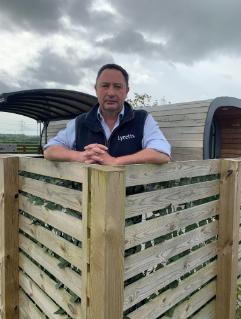
Furthermore, if hygiene and safety regulations have not been followed, insurance cover would be invalidated.
Water that goes unchecked can cause a range of conditions and illnesses – including legionnaires disease –and this can lead to potentially ruinous claims from affected guests.
James Cutbertson, of rural insurance broker Lycetts, said: “All too often, people tend to skip over the small print regarding the potential health hazards.
“If they ignore the regulations around taking water samples, and someone falls ill, their public liability insurance will be void and they could end up paying out thousands of pounds.”
He was highlighting his concern as farmers, who have invested in glamping as part of their diversification schemes, look
forward to an influx of summer guests.
“Hot tubs are a big attraction for holidaymakers, and farmers know that by providing them, footfall is likely to increase.
“However, hot tubs have environmental conditions that could potentially lead to the growth and dispersal of legionella and other infectious agents.”
The Health and Safety Executive specify how hot tub water should be tested and monitored, along with the quality and frequency of water inspections.
Cuthbertson added: “For those who offer – or are considering – hot tubs to enhance the holiday rental experience, ensuring all hygiene and safety regulations are adhered to is a must.
“They should also seek expert guidance from an insurance specialist.
“Local authority environmental health departments and the Health and Safety Executive have produced documents that detail the steps and checks that should be followed, and I strongly recommend owners read them.
“Everyone loves a hot tub, and being able to enjoy them safely means guests and operators can both relax.”

The National Association of Agricultural Contractors (NAAC) is launching a social media campaign on ATV safety to impress the importance of wearing a helmet. Farmers and contractors are being invited to share photos of themselves wearing a helmet with the hashtag #wearitandshareit.
The aim is to make all operators ask why anyone would put themselves, or their workers, at risk (and break the law) by not wearing a helmet on a sitastride ATV (aka a quad bike).

would choose to ride, or deliberately send a worker or family member out on a job with a sit-astride ATV, with no helmet, knowing there is a real and proven risk of loss of life, which could easily be reduced by using a helmet.
Commenting Jill Hewitt, NAAC Chief Executive said, “ATV users should take pride in wearing a helmet to protect their safety and help minimise the risk of the worst possible news being delivered to their family if an incident occurs. None of us are infallible and the NAAC wants the industry to get behind us by sharing photos of themselves wearing a helmet under #wearitandshareit”
Continuing Jill said, “It is a legal requirement to wear a helmet at work and if you leave it behind, you are more likely to suffer a serious head injury, or worse, if you come off. The NAAC is working with Logic helmets to provide a discount to members, removing any final excuses why a helmet would not be worn.”
HSE has confirmed if there is an incident and someone was not wearing a helmet, this will be a key part of the investigation and could result in enforcement , including prosecution. Enforcement action will also be taken if an inspector sees someone working without a helmet on farm. Wearing a helmet applies to the farmer, selfemployed workers, employees and any other person using the farm quad. This includes children or farm visitors. Note too, that most farm quads are only suitable for people aged 16 and over - check with the manufacturer. It is illegal for any ATV to be driven for a farming activity by children under the age of 13.
Of course, simply wearing a helmet will not keep everyone fully protected and it is vitally important to ensure that anyone riding an ATV is competent and trained to handle the machine. Training is crucial because it covers essential active riding techniques necessary for the safe operation of the ATV.
Shockingly, in the last five years, ATVs were involved in 14 deaths in agriculture - the most significant cause of deaths involving moving vehicles in our industry. That’s fourteen families destroyed. Many, other serious and life-changing incidents are happening all the time.Yet there is still resistance to wearing a helmet.
The NAAC is raising the question why anyone
Please support our #WearItandShareIt campaign on social media to help raise awareness and save lives. Be proud to wear a helmet, it could save your life.
Put it on, keep putting it on, and send us the proof!
As farmers battle the cost-of-living crisis amidst a rising tide of rural crime, protection of farm property and equipment has never been more urgent.
£40.5m was estimated to be the bill for rural theft in 2022 – targeting expensive equipment, vehicles and livestock.* Even fuel has become a target, given the costs of red diesel are almost double what they were the previous year.
Farmers also have to contend with a surge in prices right across essential elements of farming such as electricity, fertiliser, water, animal feed and veterinary bills – making additional costs due to theft, disastrous.
It's important farmers take all precautions to protect this crucial industry and safeguard their livelihoods. Research by the farm insurance comparison site, Quotezone.co.uk, reveals agricultural equipment is vulnerable to theft. Less than half of those sampled, 41%, actually keep their items in a locked garage or barn.
The research, based on a sample of over 6,000 farm vehicle insurance policies, shows that nearly 20% of farmers don't lock their garages or barns, and 15% of vehicles are left out on unsecure driveways.
The farm vehicle data, which was compiled nationwide across 2022, also shows the average cost of a farm vehicle in 2022 was £13,250, so well worth protecting.
Quotezone.co.uk provide some top tips to help increase security, and also try to lower insurance premiums:
• Add and maintain alarms, CCTV and security lights, and keep gates locked/vehicle keys with you
• Restrict access to yards, installing sturdy gates fixed in concrete or a metal post
• Paint equipment in distinctive / corporate colours
• Consider investing in security devices such as Datatag marking or vehicle trackers
• Note serial numbers, register and take photographs of expensive items
• Be on the lookout for breaches - checking fences, hedges and walls
• Join farm and Neighbourhood Watch schemes
Agriculture in 2021 contributed around0.5%to the UK's economy, that's £11.2bn – providing half of the food we eat and employing almost half a million people.***
Responding to the findings, Greg Wilson, Founder of Quotezone.co.uk, comments: "Agriculture is an integral part to the UK economy, bolstering employment and providing vital food supplies.
"It's disappointing to see rural crime rates are on the rise after the pandemic. I think many would assume that due to the rural location of farms and the size and complexity of the machinery in question that theft would be unlikely, but it appears farms continue to be a target for specialist thieves.
"That's one of the reasons why an insurance policy is so important. It not only protects farmers' valuable assets and provides financial security – it also supports their livelihood. That's why we're extending our range of farm insurance products, customers will now be able to compare farm insurance as well as farm vehicle insurance –giving them the tools to compare products and save as much as possible.
"Additional security measures are obviously ideal to help keep the farm safe but they can also save money, keeping vehicles in a locked barn or garage and off the driveway can bring the premium price down significantly, so well worth investigating."
Tips from Quotezone.co.uk;
1. If you drive your farm vehicle on the road at any stage, it will be required by law to have insuranc
2. If you have a mortgage on the farm, the provider may insist on farm insurance to protect their investment
3. Vehicles on the road must not use red diesel, as this could invalidate the insurance
4. If your farm has a farm shop or is an open farm that is visited by members of the public you may need to include public liability cover as part of your farm insurance policy
5. If your farm employs staff then employers' liability insurance isn't just a nice-to-have – it's a legal requirement in the UK
Quotezone.co.uk helps around 3 million users every year find savings on household bills and essentials farm vehicle insurance, tractor insurance and has just launched a new product, farm insurance.
Farm insurance is a type of insurance policy that bundles together a wide range of different coverage options to ensure specific cover to protect each individual farm or smallholdingincluding livestock, farmhouse, outbuildings, farm equipment and farm vehicle insurance.
Fire and Rescue Services across the Thames Valley have joined forces with NFU Mutual and the NFU to launch a new six-point plan to fight farm fires this harvest.
The initiative comes as farm and agricultural vehicle fires in Berkshire, Buckinghamshire and Oxfordshire cost nearly £4 million last year, according to rural insurer NFU Mutual.
The hot dry summer last year also led to a sharp rise in harvest fires, with crop fires in the three counties engulfing over 100 hectares of food crops. Long periods of dry weather combined with temperatures reaching more than 40C made the countryside a tinderbox for combines, balers and other farm machinery.
Across the Thames Valley area, fire prevention advice and news about the onset of local high-risk weather conditions are being shared by the fire service and the NFU's text alert network and other social media platforms.
Hannah Binns, Rural Affairs Specialist at NFU Mutual, said:"Farm fires put the lives of people and animals at risk and lead to huge financial losses, destroyed food and damage to the environment. NFU Mutual recommend that farmers increase regular cleaning stops and consider a range of additional fire prevention measures including combine fire suppression systems to reduce fire risks in future hot summers.
"Bringing together Thames Valley Fire and Rescue Services, NFU and NFU Mutual enables us to share our expertise and quickly alert farmers to adverse weather conditions. This will help them protect their machinery and plan harvesting operations to avoid periods when there is a high risk of fire."
Alex Nelms, NFU County Chair for Berkshire, Buckinghamshire and Oxfordshire, said:"Our advice is to keep farm vehicles maintained at all times. This includes combine harvesters which should be cleared out regularly during harvest. It's also important to keep a serviced fire extinguisher to hand.
"If the worst happens and there is a fire on farm, having an emergency plan and staff trained on what to do is really important. It also helps to have information on how to access water supplies and have a bowser filled with water, tractor, and plough ready to create a fire break if needed."
Group Manager Steve Leonard, Lead for Wildfire in the Thames Valley, said:"Thames Valley Fire and Rescue Services are proud to work with the farming community to try and reduce incidents of agricultural fires and loss of crop and equipment.
"Last year saw an increase in fires across the Thames Valley and the UK. Even though we had an unprecedented rise in temperatures last year and climate change predictions will see this issue increase in the future, we hope the advice given with NFU Mutual and the NFU will help protect farmers' livelihoods."
• Regular maintenance- Ensure that your equipment is clean and maintained before every harvest activity. Regular equipment blowdowns and lubrication schedules can help avoid fires within your equipment.
• Help us find you- Provide the fire and rescue service's control centre with what3words from the entrance of your farm and wait for the first appliance. They will then ask you to guide them to the scene of the incident.
• Know where your water supplies are -Ensure that any available water supplies on your farm are accessible to fire and rescue crews. If you know where your nearest fire hydrant is, ensure that this is clear and accessible.
• Have contingency arrangements in place -Consider using cultivators to put in fire breaks where safe to do so. If you have water bowsers available to extinguish spot fires ensure that they are near and full of water
• Store safe -Where possible avoid storing bales near main roads to deter would-be trespassers and arsonists. Store pesticides and fertilisers securely and remember it's critical to let us know if these products are involved in a fire due to the specific risks they pose.
• Check conditions + consult the Fire Severity Index before planning harvesting activities -This will help you identify the best time of day to start your harvesting to avoid the most extreme weather zones. Also check wind direction and where possible harvest in the direction of the already cut crop and not the unharvested crop.www.metoffice.gov.uk/public/weather/fireseverity-index
he NFU, NFU Mutual and representatives from 40 police forces are coming together for the first time to discuss the growing crime wave sweeping rural Britainthat has seen a surge in machinery and equipment thefts, livestock rustling and industrial fly-tipping.
policymakers and police forces working together effectively at national and local level to help protect farmers, their livestock and possessions, all underpinned by solid legislation.”
Bob Henderson, NFU Mutual lead on Rural Crime, said: “We know that specialist police support is highly effective in tackling rural crime. Since NFU Mutual funded and set up a dedicated agricultural vehicle theft unit in 2010 it has shared intelligence, delivered training, and worked with police forces across the country and overseas to seize millions of pounds of stolen machinery. This team is now part of the new Rural Crime Unit which will strengthen work at a national level so that specialist police resources can be targeted where they are needed most to protect farmers and the wider rural community. We are proud to be the primary funders of the new unit and wish it every success in its work.”
Today’s National Rural Crime Unit Conference at Stoneleigh will examine ways of combatting the huge rise in cases, including raising awareness across rural communities, preventative measures, and sharing key information and intelligence.
As an example of the crime spike in rural Britain, new research from NFU Mutual has revealed the cost of GPS theft in the first four months of 2023 exceeded £500,000, more than double compared to the same period last year.
NFU Vice President David Exwood, who is hosting the event, said: “Highly organised gangs of criminals continue to plague the great British countryside, stealing livestock and expensive GPS equipment, trespassing on private land and regularly fly-tipping tons of rubbish; their actions significantly impact farm businesses, farming families and rural communities, both financially and emotionally.
“Today’s conference demonstrates the importance of a collaborative approach with farmers,
Head of the National Rural Crime Unit, Superintendent Andy Huddleston, said: “I am grateful to the NFU and NFU Mutual in helping us host this first ever meeting of all rural crime operational Inspectors from across all regions of the UK.
“The many rural crime leads at this meeting are doing great work across the UK both operationally and strategically to tackle these crimes, however, we accept the need and want to do more.
“In the face of increasing thefts around machinery and GPS thefts, as well as instances of livestock theft and fly-tipping, there is an urgent need to improve co-ordination and partnership problem solving, regionally and nationally, as well as sharing the many instances of best practice such as Rural Watch, Partnerships Against Rural Crime and Rural Crime Volunteers.
“The newly formed National Rural Crime Unit (NRCU) is designed to do this and support UK police forces combat the organised crime groups that target rural communities.”
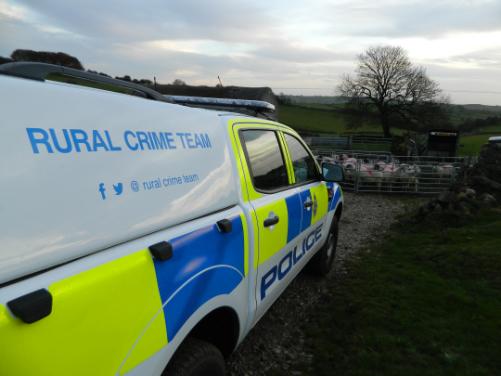
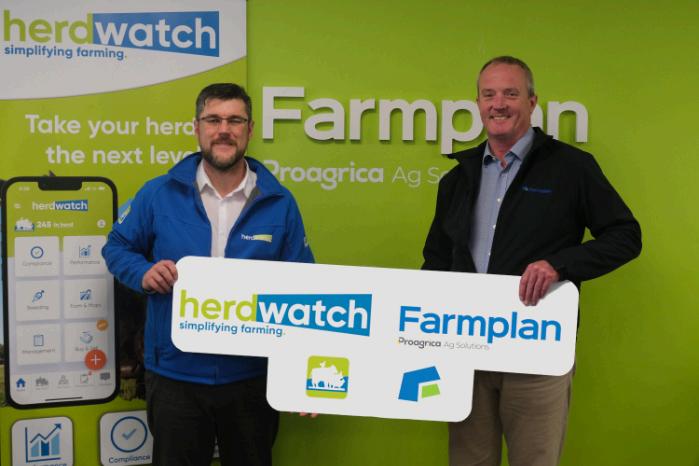
Farmplan's livestock management software customers, including Cattle Manager and Sheep Manager, are upgrading to the Herdwatch platform.
Herdwatch, the market-leading farm software company founded in 2012, and Farmplan, founded in 1972 and part of Proagrica, have announced a new partnership that will see all Farmplan livestock software customers upgrading to the Herdwatch platform, starting this month. This partnership will upgrade those customers who are currently using Farmplan's livestock software suite, specifically dedicated to sheep and cattle products such as Livestock Manager, Cattle Manager and Sheep Manager.
Herdwatch will deliver a robust, integrated, and feature-rich platform. Customers who are using Farmplan'sfinancial, cropping or hardware products and services will continue to have access to the same unrivalledsupport, as these areas remain unaffected by the partnership.
Piers Costley, Farmplan by Proagrica Managing Director, said, "Great care was taken to find the perfect partnership to provide this upgrade to our cattle and sheep software customers.Herdwatch is already used on more than 18,000 farms across the UK and Ireland. They provide access tocutting edge technology andwere deemed the best suited partner on the market. Herdwatch is a natural and logical partner that will equip users with access to valuable cloud integration to
future-proof their operations."
Fabien Peyaud, CEO and cofounder of Herdwatch said, "We are honoured that Proagrica have selected Herdwatch as the natural solution to upgrade their Farmplan livestock software. We have a very similar ethos and look forward to welcoming customers to the Herdwatch platform as wecontinue our investment in the future of British farming. Our easy-touse, cloud based solution can be used by multiple users, to access multiple holdings, on multiple devices, making it the perfect solution for Farmplan sheep and cattle software customers."
The Herdwatch app for cattle and sheep can be downloaded in the App Store or at www.herdwatch.com
The UK's leading rural insurer NFU Mutual is supporting farmers to take steps to help protect cows from heat stress as temperatures are set to reach 30C this weekend.
Research from NFU Mutual with dairy farmers found that just over four in ten (41%) say that heat stress is a priority risk for their business.*
And a 2022 study by Dr Tom Chamberlain, in conjunction with Lallemand Animal Nutrition, found heat stress led to an average loss of production ranging from £24,000 to £90,000 depending on herd size.
Gregor Belcher, Farm Specialist at NFU Mutual, said: "Heat stress in cows is becoming a major concern for many dairy farmers as summers get hotter.
"There are various measures dairy farmers already take to mitigate heat stress in cattle, such as providing suitable access to water troughs and pipes, ensuring these water flow rates are sufficient and identifying paddocks with greater shade ability and utilising those on hot days.
"Longer term actions may include adjusting milking times to coincide with the cooler periods of the day, installing shade and fans in holding yards and cow sheds and reviewing breeding plans to focus on genetic strains that have greater heat tolerance levels.
"These measures can help reduce the negative impact that heat stress can have on welfare
and a herd's productivity."
The advice comes as NFU Mutual partners with parametric insurance specialist Skyline Partners, broker Gallagher and insurance provider Markel to develop and pilot an indexdriven cover which pays out if increased hot weather causes heat stress.
The trial is running this summer with selected customers in key dairy regions across the UK. NFU Mutual has developed the dairy product with their collaborative partners Skyline and Markel, with a long-term view to investigate a range of on-demand parametric covers which would automatically compensate farmers in the agriculture and horticulture sectors for climate-related losses.
"To help our dairy farmers cope with this growing problem, we've talked to agricultural experts, dairies, farmers, and insurers across the world to develop an innovative product which operates simply and effectively," Mr Belcher added.
"We believe this type of cover may become increasingly important to protect other agricultural and horticultural sectors as the effects of climate change intensify, and we are working with farmers and growers to understand the need for a range of bespoke policies."
Working with Dr Tom Chamberlain, NFU Mutual is also sharing the followingdairy heat stress advice:
Short-term actions
• Providing suitable access to
water troughs and pipes are in good working order, have no leaks, and that the flow rate to the troughs is sufficient.
• Identifying paddocks that have greater shade availability and utilising these on hot days.
• When buffer feeding adding suitable feed additives to ensure cattle are receiving peak nutrition to support rumen health function.
• Implementing 'Siesta' Management where appropriate – this technique involves cows grazing directly after milking and then being 'housed' at around 10am, with buffer feed available to them. Cows are then sent back out to graze after afternoon milking to graze until dusk.
• Installing greater numbers of water troughs in key locations so that cows are never more than 100m away from a clean water source.
• Adjusting milking times to coincide with the cooler periods of the day.
• Installing shade and fans in holding yards and cow sheds.
• Reviewing breeding plans to focus on genetic strains that have greater heat tolerance levels.
First Milk & Yeo Valley Join Forces to Create 'Naturally Better Dairy Group'
British farmerowned dairy co-operative, First Milk, has agreed a new partnership with dairy manufacturer Yeo Valley Production, which will see it create a new regenerative milk pool, visitors to last week's (21 June) Down to Earth South event heard.
Recruitment for the new group will commence immediately, and First Milk members within the catchment area will also be invited to join.
Speaking at the event, First Milk's Sustainability Director Mark Brooking explained how the cooperative already operated the largest regenerative farming programmes in the UK dairy sector.
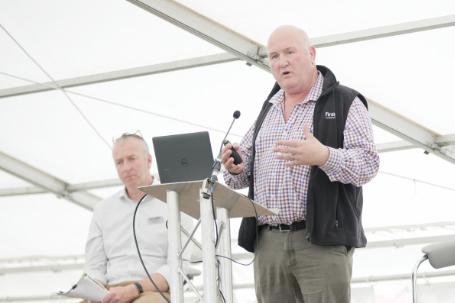
"We already have 700 farmers on the regen journey and are
forward, an element of the milk price will be proportioned to this," he said.
Record numbers of visitors attended this year's Down to Earth South Event at Rushywood Farm near Crewkerne, Somerset, home to Neil Baker, who milks 1,800 cows in a fully-housed system.
A second Down to Earth event is being held next month on 6 July in Cumbria following unprecedented demand.

Down to Earth North will be hosted by Mark and Jenny Lee, true converts of regenerative farming, milking 175 milking crossbred cows, which are mobgrazed on a 30–40-day rotation. They graze areas of silvopasture, have pigs and chickens in the rotation and are reaping the rewards for their herbal leys.
The 'Naturally Better Dairy Group'is a collaboration between the two organisations that will see First Milk establish a new conventional regenerative milk pool in the Southwest of England.
Founded on the principles of nature-positive farming, this group will supply Yeo Valley Production with milk for manufacturing great dairy products, with farmers committing to delivering ever better outcomes in terms of animal welfare, climate, biodiversity and local community.
delighted to have agreed this exciting partnership with Yeo Valley Production, which will see us broaden this activity further, demonstrating that great tasting dairy can be a force for good.
"As the Regenerative co-op, we firmly believe that this approach to farming is the way to continue to produce affordable, nutritious food whilst addressing the growing climate and nature challenges we face."
Mr Brooking said food buyers were interested in how we can sell positive stories and dairy farming done well was a part of the climate solution. "As we go
Visitors to Down to Earth North will see first-hand the benefits of regenerative farming on their farm with farm walks throughout the day. There is a whole suite of talks and practical demonstrations on regenerative farming covering everything from the benefits, to what regenerative farming means for different systems, including case studies and practical ways to improve your farm's sustainability.
More information on Down to Earth North, event timings and speakers can be found at projectdowntoearth.co.uk
Innovations in technology such as automated weighing platforms have proved a gamechanger for Scotland's beef finishing sector, improving data collection, driving better management decisions and boosting overall performance.
This is the eighth in a series of case studies, developed as part of the 2023 RHASS Presidential Initiative (PI), exploring the science behind food and drink production, with the spotlight turning to the development and widespread adoption of the Ritchie Beef Monitor.
The automated weighing crate, complete with fitted water troughs and 3D cameras, was borne out of a multi partner collaboration between David Ritchie (Implements) Ltd, SRUC, Scotbeef, and others (Harbro, Innovent Technology Ltd, Wm Morrison Supermarkets), and allows farmers to monitor live weight and weight gains of individual cattle through compatible ear tags, every time they walk on the unit to access water.
The technology allows farmers to track optimum finishing points for individual animals, which has led to a welcome reduction in penalties for overweight cattle, whilst reducing labour needs, minimising stress for livestock and offering clear health and safety benefits.
The weighing crate was first launched four years ago and deliverers of the weighing crate, David Ritchie (Implements) Ltd, has since been working closely with farmers to further develop the technology, and this May, launched a new SMS alert system, which notifies farmers if
certain cattle aren't performing as expected, as well as when animals are ready for market.
Technology pioneers, Agri-EPI Centre, were an early adopter of the system, working with several farmers to trial the platform on the ground. CEO Dave Ross explained how the development and adoption of new technologies like Ritchie Beef Monitor are critical to improving data collection and efficiency in Scotland's beef herds:
"Science and innovation are the engine of improvement in agricultural output and have demonstratively been that engine throughout history. There are high levels of variance between the performance of the top and bottom 10% of farmers and what is missing, is the data to inform on management decisions and to optimise performance. These technologies eliminate the guesswork, improve data collection accuracy, reduce labour pressures and enhance animal welfare on farm," said Mr Ross.
One of the first farmers in Scotland to trial the new technology was Robert Neill of Upper Nisbet Farm in the Scottish Borders, who runs a herd of 300+ Limousin cross cows with all progeny finished on farm.
"You can't monitor what you don't measure, so for us, this was an opportunity to capture data, particularly daily live weight gains, to make sure the nutrition we were using was doing the job correctly and to help us get to the target weight for fattening."
Sharing his thoughts on the important role of science and technology, he added: "These technologies are helping us to be more efficient, but they are also a draw for the next generation who
want to be working with the latest gadgets and seeing progress in the sector. I see this first-hand working with my two sons on the farm, so if we can streamline these technologies to make them more reliable and workable, it is a no-brainer for farming."
Ian Duncan Miller of the RHASS Presidential Initiative added:"The Ritchie Beef Monitor developed in conjunction with Agri-Epi Centre and others, is an excellent working example of the essential link between basic research and innovation and the supply chain in agriculture. We are delighted that our RHASS Presidential Initiative has been able to shine a light on some of these examples, particularly as our sector comes under pressure from both economic and environmental pressures and demonstrates the need to continually invest in science and research to be prepared for these challenges."
The RHASS Presidents' Initiative will culminate with a showcase at the Royal Highland Show, bringing together different sectors and stories from over the past months and creating a legacy of materials which will be made available for anyone to access.

To view the full Ritchie Beef Monitor case study,click here:RHASS PI case study eight.pdf
For more information on this year's initiative and to access past and future case studies, please visit:https://rhass.org.uk/ presidential-initiative/
Welsh premium organic lamb producer Rhug Estate, based in Corwen, has partnered with an international consortium of tech, trade, and veterinary industry leaders on a supply chain project to enable the frictionless movement of quality lamb products to export markets.

ubloquity – the lead company in a newly formed technology consortium (TETA) - has secured £50,000 in funding from the Welsh Government’s Technology Connected scheme to develop the blockchain-enabled application for Rhug.

The system replaces manual ‘in person’ veterinary checks with remote digital checks –revolutionising supply chain assurance and making the export process simpler, cheaper, and significantly more efficient.
The award-winning 12,500 acre Rhug Estate is a 100% organic, sustainable farming business which exports premium lamb from Wales to hospitality markets across Europe. Since Brexit, Rhug’s organic lamb exports have reduced by 50% due to increased administration burdens, highly complex custom regulations, veterinary checks and certifications.
On top of this, delivery times have increased from one to six weeks.
The ubloquity-led blockchain solution reimagines the end-toend supply chain for Rhug by replacing the manual ‘in check’ veterinary process with remote digital checks that are authenticated, highly efficient, and offer significant cost reductions.
This data, along with all the other regulatory information and protocols, is stored on the blockchain, creating a green export lane for Rhug. By achieving trusted trader status, Rhug’s lamb is transported without checks and lengthy time delays.
The TETA consortium was formed in response to the UK government’s Border Target Operating Model, with the innovative grouping creating a pilot programme that securely connects food safety, traceability, and transport data across the supply chain - from farm to processor, distribution centre to border check.
Rob Chester, ubloquity CEO said:
“Post-Brexit, red meat exporters face additional regulatory checks and administrative burdens on goods going to the EU, making it more difficult and expensive for customers and restaurants on the continent to source premium goods such as Welsh lamb.
“Blockchain technology can solve this problem and we’re partnering
with Rhug and industry experts to deliver a solution that enables frictionless trade and unlocks Welsh lamb exports. Our digital blockchain-enabled application will remove the requirement to deploy expensive and highly qualified vets to conduct manual checks and sign paperworksignificantly lowering the cost of trade to the exporter and freeing up vets to conduct more highly skilled and necessary work.”
Chris Esler, Production Manager, Rhug Estate said:
“We’re thrilled to be working with ubloquity and the TETA consortium on a solution that will ensure we can get more fresh, organic lamb to our EU customers – saving money and time across the supply chain. We welcome the support from Technology Connected to help us take the project forward, and enable us to boost quality Welsh lamb exports.”
Paul Brooks, Head of UK Nations/Regions Team at The Institute of Export & International Trade (IOE&IT) added:
“My team and I are focused on helping the Welsh manufacturing sector grow its international markets and trade, so we’re delighted to be supporting this innovative use of blockchain here in the heart of Wales. The use of blockchain to remove friction and enable the seamless movement of goods is to be applauded.”
1
The developers behind the smaXtec advanced health system have identified a new early standard for mastitis detection – Level Zero –which will enhance the welfare of dairy cows and reduce economic losses of the disease for farmers.

This scientific advancement is a major step in proactively tackling one of the costliest diseases impacting the dairy sector. Industry reports estimate that the loss of milk production, associated veterinary costs and premature culling costs £334Kingshays-Dairy-CostingsFocus-Report2022.pdf1 per case of mastitis.
This new early diagnostic standard has identified a specific temperature pattern that indicates the early onset of mastitis through in-depth analysis of data collected through smaXtec’s continuous monitoring. This sets a new Level Zero standard for the detection and proactive prevention of the disease.
Based on the highly accurate measurements of inner body temperature generated by its health monitoring boluses, smaXtec has identified three rapid temperature increases over a short period as the trigger for mastitis.
The Level Zero classification, the lowest in severity, is described as inflammation already being

present but with a normalappearing mammary gland and visibly normal milk.
Data also shows that a cow’s inner body temperature increasesup to four days before clinical symptoms of mastitis become visible2
Until now, it’s been considered good practice to detect and treat mastitis from Level One. But, if you can identify mastitis at Level Zero before the somatic cell count (SCC) reaches pathological levels, it gives producers the ability to administer a preventative treatment.
smaXtec customers typically report a 55% reduction in antibiotic usage for mastitis cases in the first few months of using the bolus technology, with longer-term customers reporting antibiotic reduction by up to 70%. This is encouraging data for an industry focused on reducing antibiotic usage.
Managing a herd of 650 cows, Cornish farmer, Bill Jewell introduced the health system in 2021 and says that mastitis outcomes have improved significantly.
“Since installing smaXtex, I honestly can’t say that we’ve had
“By detecting mastitis at Level Zero using our award-winning technology, dairy farmers will experience routinely healthier cows, consistently higher milk yields, less antibiotic usage and, ultimately, less dumped milk –saving both time and money. It’s win win,” says the company’s global sales director, Chris Howarth.
any prequartered cows from having mastitis. There has not been a case that we’ve missed,” he says.
The new level of detection for mastitis is just one example of smaXtec’s ongoing efforts to develop innovative solutions that improve the health and productivity of dairy herds worldwide.
Trinity AgTech has released three major updates for Sandy, further extending the capabilities of its next generation natural capital navigator.
The developments include a brand-new module – Sandy Central Account –which will enable aggregated reporting and analytics, alongside updates to Sandy’s packhouse and dairy modules.
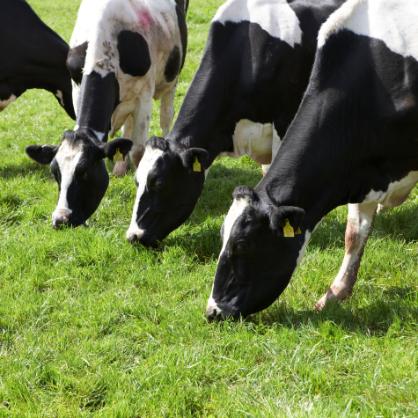
“At Trinity AgTech, we are committed to delivering the best possible natural capital software solution, that follows the latest science and meets the needs of farmers and the wider industry,” says Anna Woodley, manager director for business development at Trinity AgTech.
“Sandy offers unrivalled levels of sophistication and analytical integrity, and the latest developments will further support measurement, analysis and progress with the food supply chain.
Ms Woodley explains: “Farms with on-site packhouse operations, processors, and large packhouse operations, will find the updates to our packhouse modules particularly advantageous, while farm consultants are set to greatly benefit from our new Sandy Central Account module.”

The updates to Sandy’s packhouse modules relate to onboarding and carbon calculations. Processors can now integrate multiple sites into Sandy, enabling independent calculations for each location as well as a whole unit.
New features within this module also
allow greater flexibility in reporting.
Ms Woodley explains: “Data can now be aggregated or viewed at a more granular level, for example at packhouse level, which includes multiple or single sites, product level, product source, or packaging level.”
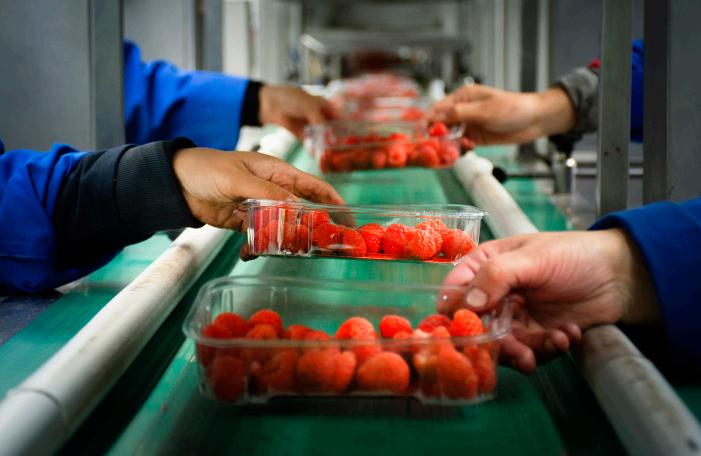

Sandy's new Central Account has opened-up aggregated reporting and analytics to benefit larger farms, consultants, and processors. Providing the farmer has given consent, this development will allow non-farm
based users to view aggregated or single farm data, produce customised reports and apply filters at a farm, field, and crop level.
Ms Woodley says: “Many farmers are working very closely alongside consultants to optimise the opportunities around natural capital.
“This new update will make it much easier for consultants to support their clients with data management and sustainability strategies. In addition to helping farmers establish best practices with the guidance of consultants.
“It will also equip processors with the necessary insights for implementing better carbon reduction plans. A one size fits all approach is not suitable, so the ability to interrogate data at different levels is a gamechanger that will give businesses a much more representative view,” she says.
The final update involves Sandy’s Dairy Carbon Calculator. This includes some adjustments to its enteric emissions calculations, which now better
represent diet and time at grass, as well as to its energy calculations to better account for the energy requirements of lactating cattle.

“Outdated free carbon tools mispresent farm systems and fail to take into consideration differences, within and between systems, which impact emissions. Sandy is very different and, from the start, we set out to develop navigation software that would assess carbon and on-farm natural capital in the most accurate way possible.
“We are guided by the latest science, aligning to the highest standards in carbon reporting, and will continue to make improvements to Sandy as the science evolves,” says Ms Woodley.
“With Sandy, farmers, consultants, processors and retailers can all trust that they are best placed to seize new opportunities in sustainable agriculture and can optimise their practices and profitability, while safeguarding the environment.”
Data collected in a 2022 farm trial found that lambs supplemented with Celmanax, a yeast fermentation additive, from weaning to slaughter resulted in a £18.91 per head advantage compared to lambs not provided additional supplementation when cost of feed was taken into consideration.
According to Dr Alison Bond, nutritionist for Rumenco and UK distributor of Celmanax, the biggest contributor to the increase in profit was a significant increase in daily liveweight gains resulting in faster finishing times. Of the lambs supplemented with Celmanax, 50% were finished by the end of June and an additional 35% were finished by the trial end. Only 8% of unsupplemented lambs were finished in June, with an additional 17% finished by the end of the trial, resulting in 75% of the control group remaining unfinished at the end of the trial.
“The nutritional benefits from Celmanax allowed lambs to achieve an average daily gain of 530g in the first four weeks of the trial, a 150g advantage over the control group that had an average daily gain of 380g,” explains Dr Bond.
Beginning on May 15 and ending on July 25, over 650 10-week-old lambs on a commercial sheep farm in Wales were split into supplemented and control groups. Lambs had negative worm counts, were managed on paddocks with a sward height of 9cm (2,500 kg DM/ha) and had free access to a

Rumenco mineral bucket.
Each group was supplemented with creep feed, allocated 1kg/h/day. The control group was fed standard creep feed and the treatment group received creep feed containing Celmanax to provide 0.5g/h/d.
“Celmanax is a yeast fermentation additive that has been shown to improve ruminant performance by supporting a stable rumen environment. A range of
compounds within this product supports the maintenance of a stable rumen microbiome, therefore improving digestibility and feed efficiency,” explains Dr Bond.
According to Dr Bond, the financial return of feeding Celmanax was achieved through a combination of fewer days on farm and the lambs earning a higher price by hitting the market early.
“If you look back through market trends, lamb price will be strong throughout June and then start to decline as you get into July and August. This is because the majority of lambs are finishing in the July-August period, flooding the market and driving down prices,” she says.
In June 2022, the average deadweight lamb price was 671.73 p/kg, dropping to 636.35 p/kg in July and even further to 544.90 p/kg in August.
Fewer days on farm, also equate to fewer resources like water, grass and labour being required, adds Dr Bond, which was not taken into the financial calculations on this trial. However, using industry data, Rumenco estimates that Celmanax supplementation reduced enteric methane emissions throughout the trial period by 18.7% compared to the control group.
Sheep farmers wanting to take advantage of the rumen support and average daily gain benefits of Celmanax have a couple of feeding options, says Dr Bond.
The first is to feed it in a creep compound like the trial farm. The recommended feeding rate is 0.5g/h/day to be fed from weaning through to finish.
The second option is to supplement lambs from weaning through to finish with a multipurpose product like Rumevite Quality Lamb, which replaces concentrates. Good frame growth and weight gain are achieved through the block’s 18 percent all-natural protein content and 13 ME. Lambs also benefit from the formulation which includes essential trace elements, vitamins and minerals. This includes vitamin B1, selenium, cobalt and protected zinc.
The combination of nutrients in Rumevite Quality Lamb provides huge performance benefits. In a 2018 trial, lambs supplemented with Rumevite Quality Lamb had an average daily liveweight gain over double that of the control group and were finished 81 days quicker, with a 390g heavier finishing weight.
Regardless of the method of supplementation, a yeast fermentation product like Celmanax will provide sheep producers with the benefit of getting lambs off farm faster.
“Being able to maximise homegrown forages will be the most cost-effective way to get lambs to finishing and off the farm earlier,” concludes Dr Bond.
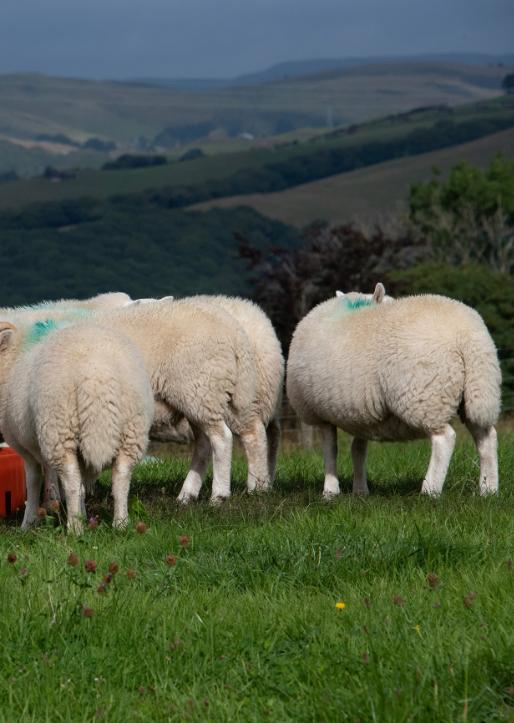
HiSpec Engineering has introduced a unique new Dump Trailer that uses the well proven push-off technology originally designed for the company’s Kompactor range of push-off trailers.
The new HiSpec Push-off PD20 Dump Trailer, which will be displayed for the first time in the UK at this year’s Royal Highland Show, has a heaped load volume of 14.5m3, giving it a carrying capacity of around 20 tonnes, depending on material.
Unlike conventional tipping dump trailers, the PD20 Dump Trailer is offloaded using a hydraulically operated moving floor type headboard that cleanly and efficiently clears the load from the body once the up and over tailgate has been raised. The moving headboard is based on
the same mechanism that was developed for the larger Kompactor push-off trailer range and has a push-off capacity of 28,000kg.

This has the benefit that it enables the Dump Trailer to be safely used and offloaded on slopes or at an angle without any risk of the trailer tipping over, or in buildings and situations where there are height restrictions. Where necessary, it also makes it very easy to offload and spread a load while on the move. Once the trailer has been emptied and the tailgate closed, the operator can move off while the headboard is retracting, so avoiding the delay while a tipping trailer is lowered, and as a result turn around times are reduced.
For maximum durability, the floor of trailer body is constructed from 8mm thick Hardox steel, and 6mm Hardox steel is used for the
body sides. By avoiding the need for a hydraulic tipping ram and hinge points, the centre of gravity is lower than for a conventional dump trailer. This not only makes the PD20 Dump Trailer very stable on the road, but the load height at just 2.39 metres is reduced and correspondingly it is also far easier to see into the trailer and the load from the tractor cab.
The trailer chassis of the PD20 Dump Trailer incorporates a hydraulically sprung drawbar fitted with a bolt-on swivel hitch. The running gear on the PD20 Dump Trailer comprises of a parabolic sprung tandem axle fitted with 127mm round commercial axles. These are fitted with 525/65 R20.5 173F tyres and 420x180 air/hydraulic brakes.
The standard specification also includes LED road lighting, four
reversing lights, a strobe beacon and brackets for fitting an up and over sheet.
Joining the new PD20 push-off Dump Trailer on the HiSpec stand at the Highland will be the K36 Kompactor push-off trailer, while from their diet feeder product range there will be a T16 vertical auger feeder. From the

extensive muck and slurry spreading product range there will be a 3000 TD-S tandem axle tanker fitted with a dribble bar, a single axle 1350 SA-S tanker plus a HiSpec dribble bar, in addition to a 1000 side spreader. For further information please contact either:
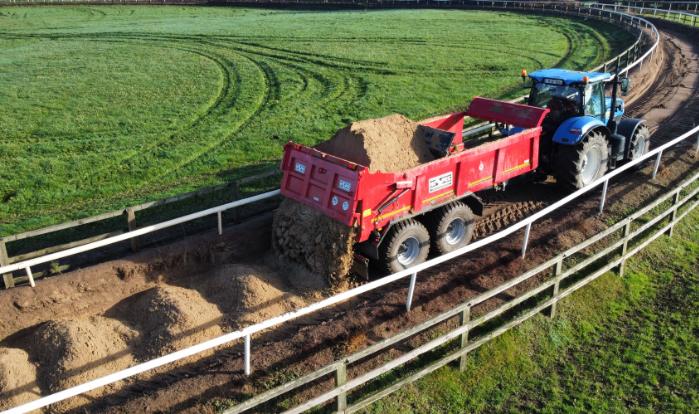
Hamish Watson (North of England & Scotland Area Manager)
07868 648343 or hamish@hispec.net
Edward Lewis (South of England Area Manager)
07876 4562698 or elewis@hispec.net
In the world of industrial operations, where the handling of abrasive and viscous materials is a common challenge, the importance of slurry pumps cannot be overstated. These robust and specialized pumps have revolutionized various industries by efficiently transporting slurry, a mixture of solids and liquids, with utmost reliability.
One of the primary applications of slurry pumps lies in mining operations. With the extraction of valuable minerals comes the need to process vast amounts of ore, often in the form of a slurry. Slurry pumps
separation and processing. The ability of slurry pumps to handle high concentrations of solids ensures smooth operations, preventing clogging and maintaining optimal flow rates throughout the treatment process.
Agriculture, too, benefits from the capabilities of slurry pumps. Farmers employ slurry pumps for tasks such as irrigation, fertilization, and transferring animal waste. The versatility of these pumps allows them to handle varying compositions of slurry, ensuring efficient distribution and reducing manual labor requirements.
Advancements in slurry pump technology continue to enhance their performance and reliability. Manufacturers have been incorporating innovative features such as adjustable impeller clearance, improved sealing mechanisms, and optimized hydraulic designs. These advancements lead to higher efficiency, increased durability, and reduced maintenance, allowing for greater productivity and costeffectiveness.
However, challenges persist in the realm of slurry pumping. The continuous wear experienced by the pump components due to abrasive solids can result in decreased efficiency over time. Regular monitoring, maintenance, and replacement of worn parts are necessary to ensure optimal performance and longevity.
tackle this demanding task by effectively handling the abrasive nature of the mixture. Their rugged design, featuring wear-resistant materials and impellers specifically engineered for handling solids, enables them to endure the harsh conditions within mining environments.
Wastewater treatment facilities also heavily rely on slurry pumps for their operations. In these settings, slurry pumps play a crucial role in transferring sludge and sediment, allowing for efficient
In conclusion, slurry pumps are vital assets in industries dealing with abrasive and viscous materials. Their ability to efficiently transport slurry while enduring challenging conditions has transformed various sectors, including mining, wastewater treatment, and agriculture. As technology continues to advance, further improvements in slurry pump design will undoubtedly enhance their performance, contributing to increased productivity and reduced downtime in industrial operations worldwide.
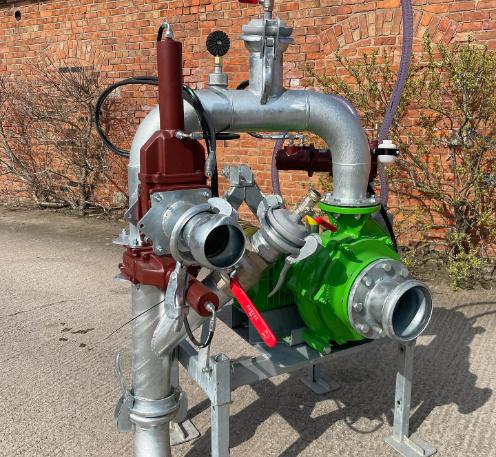
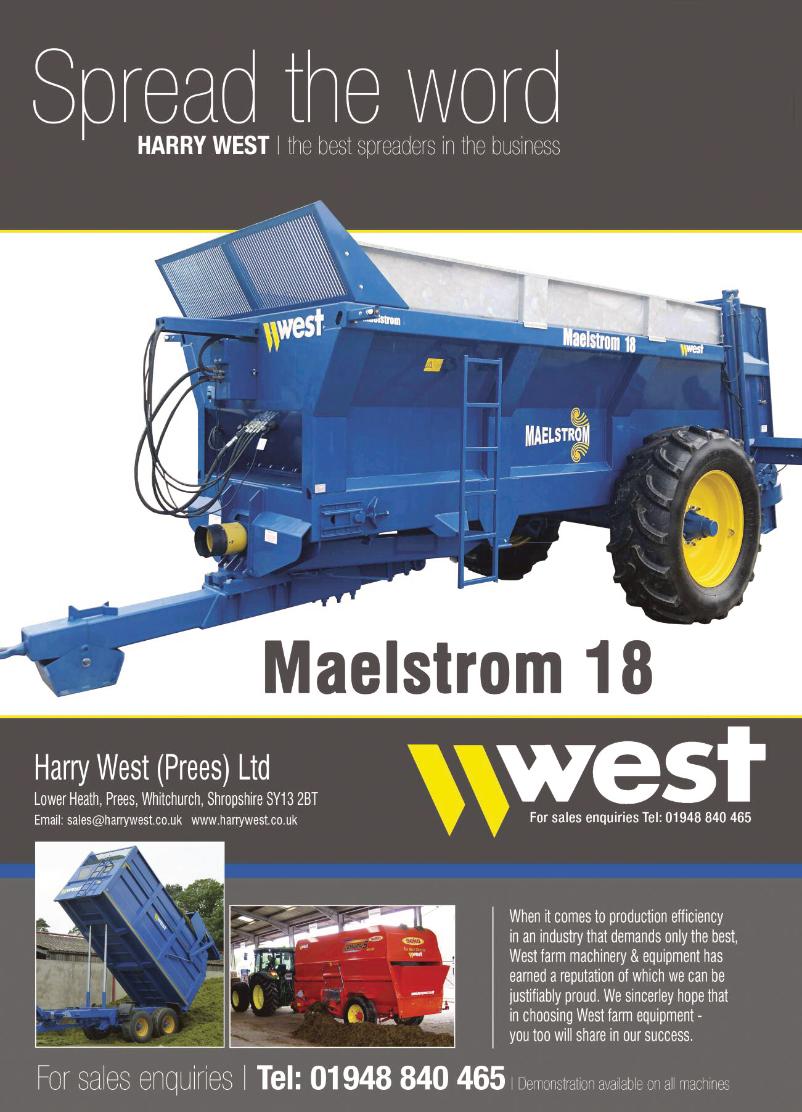




Agriculture supplier, Vogelsang, is encouraging farmers to think of their manure as 'liquid gold' as a combination of Government restrictions and high fertiliser prices comes to the fore.



According to analysis by the Energy and Climate Intelligence Unit (ECIU), farmers could be paying an additional£1.1 billion for fertilisers in the years between 2021 and 2024. Farmers are also facing additional spreading and storage restrictions such as the Clean Air Strategy, under which slurry must be applied using low emission spreading equipment by 2025.
















Sion Williams, Agriculture Manager for Vogelsang, said: "Farmers have had a tough time lately. They are being tasked with addressing their emissions being released into the atmosphere, and are faced with more restrictions on what they can and cannot do in terms of fertilisation. This is causing a bind for farmers, especially since last year's nitrogen price spikes. Many farmers want to cut their emissions

and are being told that it is actually good for their farms, but it needs to stack up financially. Because of this, more and more farmers are using liquid manure as their go-to fertiliser, which is great as it's so much more than a waste product; really it's liquid gold."

Sion added: "But it all comes down to how you use it, and many farmers are essentially throwing away this precious resource by the way they spread it - or worse still - leave it sitting in the lagoon. For instance, using a splash plate loses 80% of the ammonia nitrate in liquid manure - you can literally see the pound coins disappearing into the atmosphere through lost nutrients."
Because of the nitrogen lost through ineffective spreading, Vogelsang is highlighting the benefits and importance of precision slurry spreading. Tactics such as low-emission spreading methods using trailing shoes and dribble bars - which direct the liquid manure to the base of the crop - and covering slurry stores, can help prevent nutrient losses and emissions into the air.


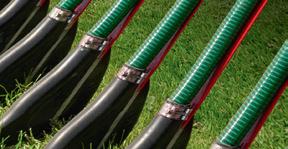

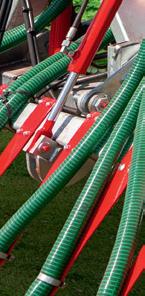


UniSpread: the ultra-agile and super-efficient spreader by Vogelsang

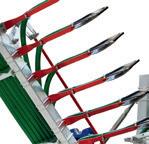


Compact and versatile: choose our UniSpread and use it as a dribble bar or trailing shoe. Benefit from easy installation and retrofitting, small linkage with low overall weight, durable UV-resistant hose material, a high precision distributor and a chassis mounted system. Spread the news – UniSpread is the top choice for best results!
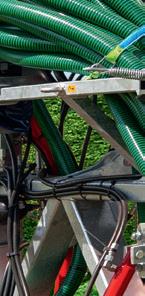



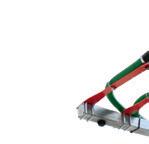
sales.uk@vogelsang.info | 01270 216 600














vogelsang.info

John Williams, Head of Soils and Nutrients at ADAS, said: "Spreading slurry accurately and evenly at times when crops are growing will maximise economic returns and minimize losses to air and water. A 30m3/ha of typical dairy slurry applied in spring has an N, P, K (nitrogen, phosphate, potassium) replacement value of over £160/ha. Using dribble bars and trailing shoes can typically reduce ammonia emissions from spreading by between 30% and 60% compared with surface broadcasting. Targeting fields with low soil P and K levels is also key to slurry fertiliser value."
To help farmers understand and calculate the nutritional value of their slurry and best plan for its use, Vogelsang has created a helpful guide, available online, alongside the ADAS and the Farm Carbon Toolkit.3
Steps: Creating A Liquid Manure
Nutrient Management Plan | Vogelsang.
Becky Willson, Business Development and Technical Director at Farm Carbon Toolkit, said:
"Manures are a fantastic resource to be used on the farm to both reduce the need for expensive artificial fertiliser, and through the addition of organic matter into the soil which also
supports farmers delivering climate solutions. At Farm Carbon Toolkit, we work with farmers who, by focusing on nutrient management planning, are able to generate significant financial savings and emissions reductions, as well as enhancing their business resilience for the future."
Vogelsang hopes that an increased awareness of better slurry management will see farmers benefit from lower outgoings and more easily adhere to Government guidelines using a mix of nutrient awareness and better slurry application.


Steve Jones, owner of Hooftrimming Ltd, said: "We wanted a direct and precise way of applying the liquid manure. Since using Vogelsang's dribble bar and trailing shoe system we have been able to offer customers a more economic and environmentally friendly way of manure application. The product is spread below the plant leaves, this method offers significant reductions in odour and contamination, as well as ensuring maximum nutrients are applied to the ground.
"My customers have been impressed with the reduction in fertiliser costs because of the minimal nitrogen losses and accurate application from the Vogelsang system. We are definitely providing a high-quality service for our customers and a large part of that is down to the machinery we use."
SlurryKat today unveils a significant investment in its manufacturing base with the official opening of a Research and Development Facility and Team Hub as it celebrates its 15th anniversary this year.
SlurryKat is a leading agricultural manufacturing business producing a range of slurry handling and spreading equipment. Operating since 2008, when it was founded by CEO Garth Cairns, the firm has grown extensively, with sales increasing 40-fold since inception, and the workforce
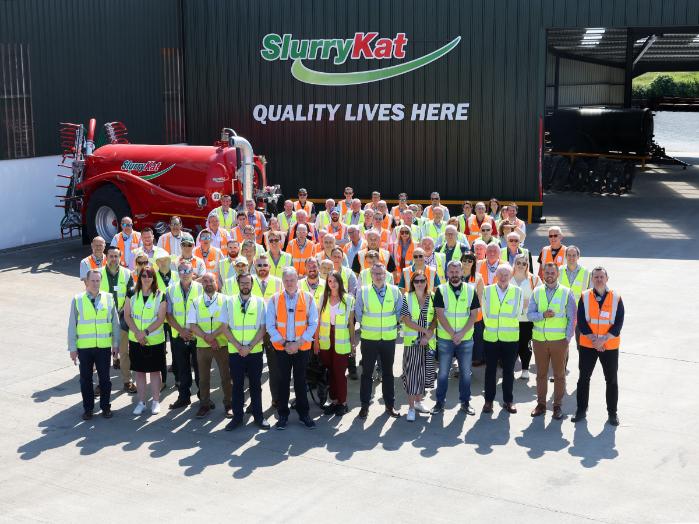
growing from a team of two, to over 80.
Through extensive research and development and sustained investment in the manufacturing process, the firm has designed innovative solutions for precise slurry distribution systems, as well other agricultural equipment and developing products for the waste and biogas industry.
SlurryKat’s manufacturing facility, set on a 52-acre site in Waringstown, has seen major expansion over the past decade. Initially starting in a small workshop which saw the first development of alternative
slurry spreading technologies, to a 120,000 ft2 production facility.
The latest investment includes a 1,000 m2 Research and Development Facility, understood to be the first of its kind globally, and represents a multi-million investment to support the company’s ongoing development and growth into the years ahead. Part of the advanced facility will allow the firm to test equipment with different pressures and flow rates in their bid to continually develop and refine the performance of new and existing products for the global slurry market.
The firm has opened a Team Hub for staff as part of the investment which includes a canteen, shower facilities and a commercial grade kitchen, as part of its ongoing commitment to improving the wellbeing of members of staff.
The firm’s success over the years has been underpinned by a global sales network to include Norway, Iceland, Chile and New Zealand, with exports to over 25 countries representing 70% of sales.
Marking the anniversary of the company Garth Cairns said: “I’m immensely proud of our achievements over the past fifteen years. Slurry plays a big part in the agriculture industry across the UK, Ireland and beyond. We
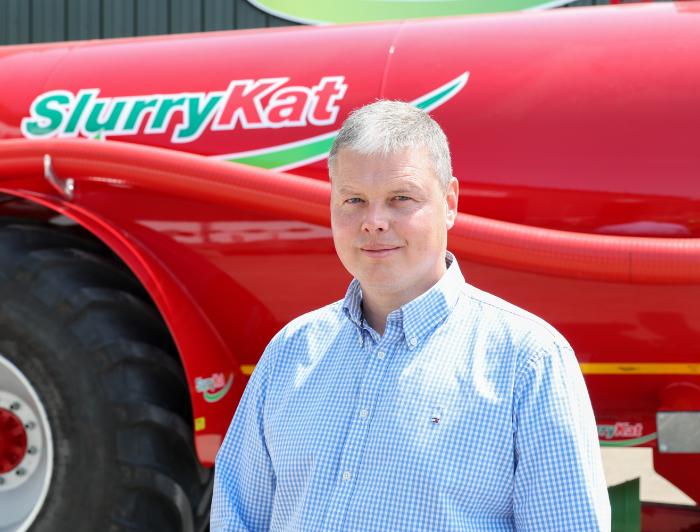
wanted to build equipment that could overcome the different challenges we see in different markets across the world, and over the years our team has been working tirelessly to evolve and develop our machinery to be as efficient as possible for our customers.”
The firm is robust in its approach to modernisation and efficiency with continual investments in technology such as a laser cutting machines, shot blasting and paint shop facilities.
Mr Cairns continues: “It’s a competitive industry and as a company we’ve been constantly growing and evolving with the industry and adapting our designs to be leaders in the market.
“SlurryKat products are environmentally focused, they are designed to ensure precision delivery in an efficient and cost-effective way and to be fuel efficient as possible. We are very aware of the environmental challenges and as part of this, we’re planning a green energy factory production facility in the 3-year capital plan with an aim to be self-sufficient within 5 years.
“This anniversary is a significant milestone for us, and with continued investments in a state-of-theart research and development centre and team hub, we look forward to the future and continued growth.”
OPICO will introduce a new version of its HEVA Combi-Disc cultivator at the Highland Show next week.
Designed specifically for those running mid-sized tractors, the new model has a 2.45m working width and four deep soil-loosening legs –rather than the five employed on 2.75m versions. These changes put the horsepower requirement for the smallest Combi-Disc at just 155hp, making this versatile one-pass tillage tool much more accessible to a wider range of growers.
The Combi-Disc employs two leading rows of soil-loosening legs followed by two rows of serrated sabre discs to provide a surface chopping and mixing effect. This is all followed up with V-profile roller to produce a corrugated, weather-proof finish.
It’s this combination of soil-engaging elements that makes the Combi-Disc such an adaptable tool. In normal circumstances the tines, discs and press are used in partnership to turn previously uncultivated ground into a seedbed in one pass. When
conditions require it, the discs can be lifted completely out of work, enabling the unit to be used as a straightforward subsoil loosener/ pan-buster.

Likewise, with the legs lifted out of contention, the machine can be put to work as a straightforward shallow disc cultivator.
The recent addition of new ‘Stealth’ soil-loosening legs adds further to the Combi-Disc’s versatility, making it a true low disturbance subsoiler with the added ability of providing some surface tilth creation at the same time.
If it’s lift capacity that is the tractor’s limiting factor rather than power, there is also the option to specify the Combi-Disc with a cage roller rather than the standard V-profile ringpress. This brings the 2.45m wide unit’s weight down from 3000kg to 3300kg, thus making it suitable for a wider range of tractors.
“With more and more growers looking towards less intensive cultivations practices yet recognising the requirement for remedial subsurface work when the need arises, demand for the Combi-Disc is on the
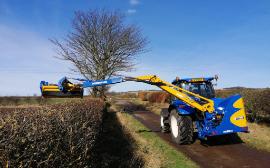
up,” explains OPICO’s HE-VA product manager Glenn Bootman.

“But until now power requirement has been the limiting factor for those operating smaller tractors. With this smaller four-leg version anyone running a mid-sized machine can pull it making full use of the tines, discs and press.”
While this new model answers the needs of growers with less horsepower, it’s narrower 2.5m transport width makes it suitable for those regions where narrow lanes and tight gateways are an issue.
It completes the HE-VA Combi-Disc line-up with working widths now ranging from 2.45m to 5.25m in both mounted and trailed formats.
For further press information and pictures please contact Jill Hewittjill@springtimeconsultancy.co.uk
For technical queries please contact Glenn Bootmann - glenn. bootman@opico.co.uk or 07860 335 297









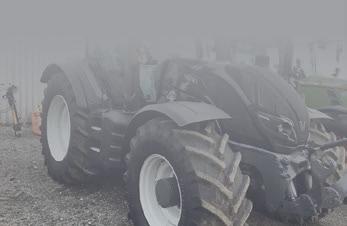
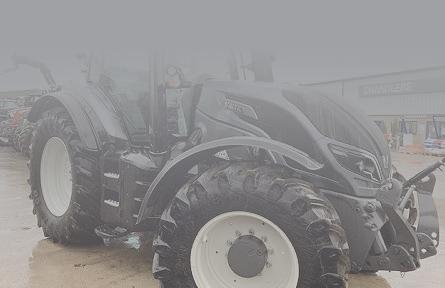




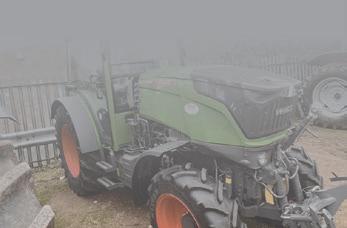






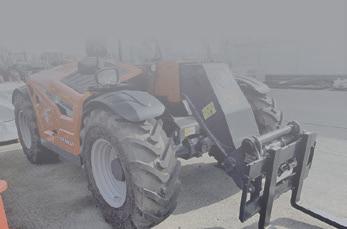
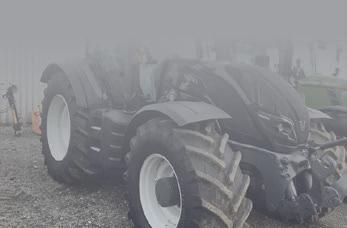
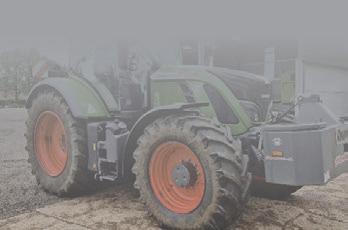




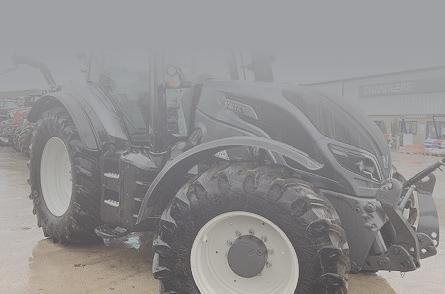

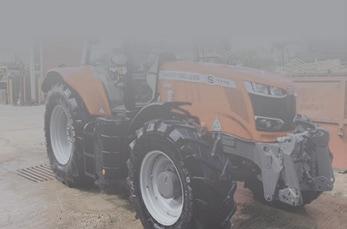

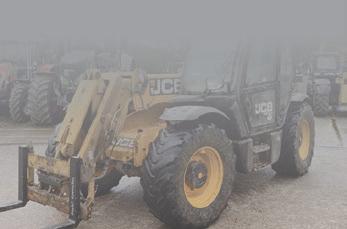



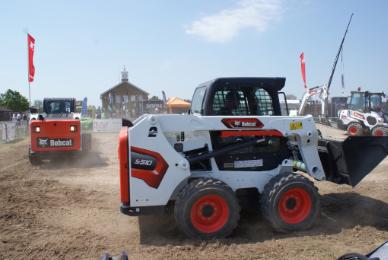
n both the Static and Demonstration areas of the Bobcat stand at the Plantworx 2023 Exhibition, the company is presenting a host of new products for the first time at the show. The premieres include the first appearance at a UK construction show of both the new TL25.60 telehandler and the T86 R-Series Compact Track Loader as part of the Static display. Other firsts at Plantworx include the new Ground Maintenance Equipment range and an array of products from the company’s Light Compaction line. They continue with the new E19e electricpowered model and the top-of-the-range E88 8 tonne mini-excavator. Bobcat is also presenting for the first time the new MaxControl Remote Control system on a T66 compact track loader in the Demonstration zone.
The New TL25.60 Super Compact Telehandler from Bobcat
As the smallest machine in the Bobcat telehandler range, the new TL25.60 brings the number of rigid frame telehandlers from Bobcat for construction, rental and general handling to 11 models. The new TL25.60 telehandler has been designed for
https://www.claas.co.uk
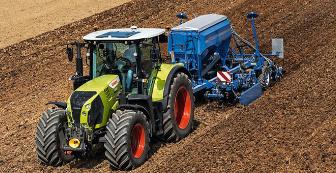
TheARION600and500range-thenewmid-rangestandard Assistingyou,whereveritisneeded. Oneofourmostpopulartractorshasjustgotevenbetterthankstoahostofnew functionsdevelopedbyourengineersinconsultationwithARIONdrivers. Afterall,theyworkinthefieldeveryday,sotheyknowexactlywhattheywant.

simplicity of use, excellent stability, optimum comfort and safe operation in any type of application.
The TL25.60 is powered by a 75 HP Bobcat Stage V engine. The machine has a rated operating capacity of 2500 kg, offers a maximum lift height of 5.9 m and a maximum reach of 3.3 m. The BobTach carriage (manual or hydraulic) increases versatility by allowing the TL25.60 to utilise attachments designed for the Bobcat loader range.
The T86 - The Most Powerful Compact Track Loader Ever from Bobcat
Delivering a higher engine and hydraulic output, the 5087 kg T86 is the most powerful compact track loader Bobcat has ever built, offering a rated operating capacity of 1780 kg and a tipping load of 3175 kg. Utilising a well-proven Stage Vcompliant 3.4 l Bobcat engine, producing 78 kW (105 HP) at 2600 RPM, the T86 can be configured for the first time with three different auxiliary functions.
There is a standard flow configuration providing 87 l/min for applications such as load and carry, or where low hydraulic flow attachments are used. Bobcat also offers two additional hydraulic performance functions using the new Electronic Displacement Control (EDC) Pump: a High Flow function giving 138 l/min and a new, industry unique Super Flow function taking auxiliary flow to 159 l/ min. Typically, the Super Flow function increases productivity with like-for-like attachments by 15 to 20%.
Commenting on these new product introductions, John Christofides, Regional Sales Director, UK/ Ireland, Nordics, Baltics and Eastern Europe for Doosan Bobcat EMEA, said: “Because job sites are becoming ever tighter on space, telehandlers must also become more compact and agile. We have designed the new Bobcat TL25.60 to not only meet this demand but to be the best compact machine on the market. The T86 is also an exceptional machine - the most powerful compact track loader we have ever built, providing even more versatility as both a
tool carrier and a workhorse.”
The T86 is part of what is now the largest loader portfolio of any manufacturer in the world. This will be ably demonstrated by Bobcat at Plantworx by the presence of both the L85 compact wheel loader in the Static area and the company’s L28 small articulated loader in the Demo area.
High performance is assured by the combination of the powerful Bobcat engine and the hydraulics in the L85. This is complemented by the high stability, breakout, push and pull forces and a comprehensive selection of Bobcat attachments. The L28 is ideal for a multitude of tasks in a very wide range of industries, offering high lift capacities in confined spaces, ease-of-use with simple intuitive controls and low ground disturbance for working on any terrain.
Bobcat’s new line-up of innovative Ground Maintenance Equipment (GME) will be on display for the first time at Plantworx. The GME range comprises compact tractors, zero-turn mowers and turf equipment, supplemented by the company’s existing mini track and small articulated loaders. Bobcat is offering three Compact Tractor platforms – the 1000, 2000 and 4000 series – which feature nine new models from 25 to 58 HP designed to meet the varying needs of customers in Europe.
Compaction applications are a required part of numerous industries, and no construction site is complete without a soil and asphalt compactor. To meet this demand, Bobcat is showing the company‘s Light Compaction Product Line for the first time at Plantworx. Altogether, the Bobcat light compaction range comprises seven different product families and offers 37 models, from vibratory rammers weighing 29 kg up to 2.6 tonne tandem rollers.
The E19e being shown by Bobcat at Plantworx is a new 2-tonne mini-excavator to supplement its everexpanding range of electrically powered machines. The E19e – an electric version of Bobcat’s popular E19 internal-combustion (IC) model – offers zero emissions, low-noise operation and comparable levels of performance to its diesel-powered counterpart. With a width of just 98 cm, the new electric model is easy to operate in even the most confined workspaces, making it ideal for tasks such
as demolition as well as outside applications that require quiet, zero-emission operations.
The E88 8 tonne Stage V compliant mini-excavator delivers outstanding performance from a compact dimension machine, superb operator comfort and excellent stability with high digging output. The proven Bobcat D24 Stage V 4-cylinder engine offers a maximum power output of 48.5 kW (65 HP) and ensures the highest performance and maximum reliability. To meet Stage V emission levels, the engine uses diesel oxidation catalyst (DOC) and a diesel particulate filter (DPF), replacing selective catalytic reduction, to achieve maximum reliability, efficiency and environmental protection.
Other products in the Static area of the stand include the E10z, E17, E27z and E55z miniexcavators; the T36.120SL and T40.180SLP
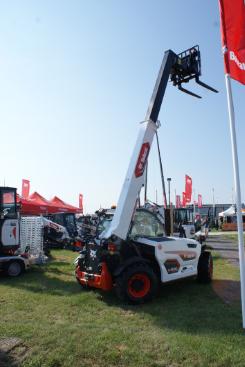
telehandlers, the T590 compact track loader and the S450 skidsteer loader.
Installed on a T66 compact track loader, the MaxControl Remote Control system from Bobcat will be demonstrated for the first time at Plantworx. MaxControl provides a vision of machine control of the future, by enabling operators to control Bobcat compact loaders remotely via an app, using an iPhone or iPad.
With MaxControl, owners of Bobcat loaders do not need the latest machines or costly hardware updates to enjoy remote control. The system is compatible with all Bobcat loaders with Selectable Joystick Controls (SJC) dating as far back as 2004.

Some of the latest developments in Bobcat attachments will be on view at Plantworx. They include a new Heavy Duty Box Blade, aimed at both 2D and 3D grading applications. The new attachment offers a Plug & Play integrated solution, that can be installed on Bobcat loaders within a minute.
Suitable for use with most of the models in the Bobcat skid-steer and compact track loader ranges, the new HD Box Blade attachment saves time and money while producing a more accurate and higher precision finish grade, even on tough jobsites. The fingertip controls and user-friendly display on the Bobcat loaders also guarantee ease of operation.
For more information on Bobcat and its products, visit www.bobcat.com

Case IH Optum 340 CVXDrive with AFS ConnectTM delivers up to 340hp / Upgraded CVXDrive transmission provides enhanced performance, durability, and reliability / 5-year AFS Connect Advanced telematics package / 3-year Safeguard Connect package / New, more spacious suspended cab is one of the quietest on the market.
Catering for the growing market in multi-purpose, high power tractors, Case IH has launched a new 340hp flagship model for its Optum range, maximising the award-winning Optum concept of a high power, low weight design that can be ballasted as required. Despite multiple improvements, the Optum 340 CVXDrive with AFS ConnectTM is no heavier than the existing 300 and 270 models, but provides more power, ultimate productivity and the ability to handle any task.
Manufactured at the Case IH factory in St. Valentin, Austria to stringent quality standards, Optum 340 CVXDrive is ideal for draft and PTO applications, from tillage and seeding to mowing and transport. Delivering the highest levels of comfort and performance, it now has one of the quietest cabs on the market and an array of advanced technologies only available from Case IH, including 5 years AFS Connect advanced telematics. This brings additional benefits thanks to the AFS Connect portal, providing the capability of connected services for a longer period.

Dr. Solveiga Kalinauskaite, Product Marketing Manager, states: “Optum 340 CVXDrive, our new top model in this segment, perfectly meets the requirements of large farming and agricultural contracting businesses needing a tractor with a high power-to-weight ratio that gives it the versatility to take on a wide range of tasks.”
The beating heart of Optum 340 CVXDrive, its sixcylinder, 6.7-litre Stage V FPT engine, delivers power and torque for demanding field and transport applications. Incorporating the highly effective and well proven Hi-eSCR2 emissions reduction technology, it also includes Automatic Productivity Management (APM) which optimises the CVXDrive ratio and engine speed to suit power output requirements.
To deliver greater performance, productivity and efficiency, while maintaining reliability and durability, Case IH have equipped the Optum 340 CVXDrive with an upgraded CVXDrive transmission which incorporates improvements to the hydrostatic unit and control software, driveline components, rear differential, and rear PTO. Additionally, there is a new external engine blow-by filter to reduce service time. To increase versatility and compatibility in daily operations, the standard ISOBUS Class 3 can be upgraded to Tractor Implement Management (TIM), the latest tractor-implement communications protocol, so that certified implements can
The Optum 340 CVXDrive, like the existing 300 and 270 models, features a large 630-litre fuel tank that enables longer autonomous hours in the field, as does the best-in-class 750-hour engine service schedule. The new model offers 27hp, or 9%, more power than the Optum 300 CVXDrive, while peak torque is 1,398Nm at 1,400rpm, compared with 1,282Nm at the same speed for its smaller stablemate.
The powerful rear linkage which can lift 11,058kg, a front linkage with a maximum capacity of 6,016kg, and twospeed front and four-speed rear PTOs further enhance the tractor’s versatility. Optum 340 CVXDrive therefore provides greater performance while maintaining reliability and durability.


The new spacious cab provides best-in-class comfort and is extra quiet at just 66dB(A). Operators will appreciate the excellent all-round visibility, premium quality trim, automotive standard of fit and finish, plus a high level of equipment, which includes a key fob for keyless operation.
The cab’s advanced design includes the redesigned ergonomic Multicontroller armrest, which places 95% of the most-used functions at the driver’s fingertips, many of which can be operated either via the touchscreen or new integrated turn-and-press encoder dial. For ultimate operating and ride comfort, an optional new semi active cab
suspension can be chosen. Clear and easy to use, the new AFS Pro 1200 touch screen monitor with Bluetooth® functionality gives an overview of all tractor functions. It helps the operator optimise engine, transmission, hydraulic and PTO performance, while also managing the operation of the implements. The new AFS Vision Pro operating system enables precision farming functionality, tractor systems and connectivity to match the required operating preferences.
Optum 340 CVXDrive comes with Safeguard Connect, a comprehensive package of the best Case IH added-value services which provides long-term protection and maximises productivity to meet the requirements of modern, innovative farming and contracting businesses. This includes an extended up to three-year Safeguard warranty and five-year subscription to the unique AFS Connect Advanced telematics portal which enables remote monitoring and management of farm, fleet, and data. A three-year subscription to Case IH MaxService, which
operates around the clock during peak season in partnership with the dealer network to maximise machine uptime, is also provided, together with preseason checks, pro-active support and training to achieve the maximum performance from Case IH machines.

The Optum 340 CVXDrive will be seen in public at various shows across Europe over the summer and autumn.
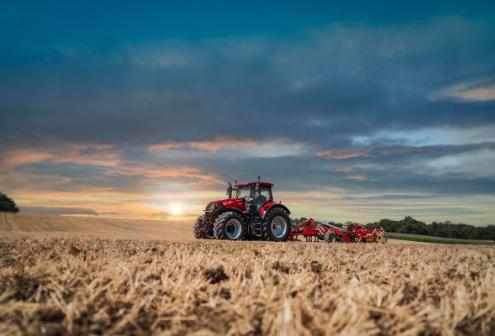
ubota (UK) Ltd has introduced a narrow version of its 106hp M5-102 tractor, aimed at those working in specialist fruit, vineyard, vegetable and solar park applications.


This latest model is called the M5-102N, and it brings several upgrades over its predecessor, the M5001N. These include a revised cab complete with Category 4 filtration; front axle suspension and front PTO; hydraulically adjustable rear linkage stabilisers and lift rods; and reduced cost of ownership through improved DPF and emissions control efficiency.
Power comes from Kubota’s V3800 engine. A 3.8litre four-cylinder turbocharged diesel, the V3800 delivers 346Nm of torque and 106hp, and is equipped with an EU Stage V compliant emissions package that uses diesel exhaust fluid (DEF).
Importantly, the emissions control module is neatly packaged under the bonnet, avoiding the need for external mounting of components such as the DEF tank and SCR cannister, which could impact on the operator’s view from the cab. And with a diesel filler at the rear of the tractor and a DEF filler under the bonnet, it is almost impossible to mistake the fill points.
“Packaging is very important on a tractor that is governed by its physical size,” explains Jonathan Rook, Kubota’s UK product manager for M-series tractors. “And this narrow model does not disappoint. Yet on its narrowest wheel and tyre combination, the M5-102N can be slimmed down to just 1.2m wide to suit row-specific tasks.”
Latest emissions control technology sees the M5N able to perform a diesel particulate filter (DPF)
regen at much lower RPM and using much lower temperatures compared to the previous M5N. Requiring only 1,100rpm to complete, considerable fuel savings are available compared to the previous model’s 2,000rpm regen. A DPF service is not required until 6,000 hours, and engine oil changes are every 500 hours.


Power is channelled through a 36x36 transmission that uses six speeds in three ranges, with a twospeed power split available in each of the six manual speeds. Electronic shuttle control and a declutch button add to the functionality, and the tractor’s 40kph road speed is achieved at reduced rpm.
Up front, a portal front axle with bevel gear incorporates Kubota’s switchable Bi-Speed turn, which increases the front wheel speed once the steering angle exceeds 35-degrees. When engaged, BiSpeed turn tightens the turning circle by pulling the nose of the tractor in the direction of steering. The front axle can be equipped with an optional suspension system which provides 95mm of travel that is damped by accumulators, and for the first time on this model, a factory-fitted front linkage and PTO is also available.
M5-102N operators get a cab that
provides an almost flat floor design, making the most of internal space and comfort, and also appealing to the tallest of operators. An uprated airsuspension seat is also part of the standard specification.
“Good packaging and practical use of space has made this one of the most generous operator environments on the market for this size of tractor, without needing to make the cab taller,” says Jonathan Rook. “A huge amount of detail has gone into producing this new model, and with almost every mechanical component made in Japan by Kubota, we’re expecting the same legendary reliability as other models in the Kubota range.”
The dashboard combines an LCD panel with traditional gauges, and thanks to electronic engine control, operators can set two engine speed memories. With electronic engine speed monitoring and control, power demanding tasks can be better maintained without excessive fluctuations in engine speed.
Air conditioning is fitted as standard, while those who prefer fresh air can choose to open either of the two curved rear corner windows. Both
front indicator assemblies are on spring loaded brackets, allowing them to be twisted inwards, 90-degrees, for added protection.


The tractor is now equipped with a stationary PTO function, and LED lighting, and when it comes to hydraulic services, buyers have the choice of manual or electronic spools and the option of ISOBUS implement control through Kubota’s 7in or 12in K-Monitors.

“Up to five mechanical spools can be fitted, with individual flow control easily reached inside the cab thanks to a 68.3 litre fixed displacement pump,” says Jonathan.
“In addition, the availability of a mid-mount spool valve kit makes it easy to operate front-mounted equipment,” he says. “The Cat II rear linkage offers a 2.3 tonne lift capacity, and electronic lift control for ease of set-up, and the tractor can also be equipped with hydraulic rear linkage stabilisers and hydraulically adjustable lift rods.”
Kubota’s M5-102N is priced from £58,868 and a range of Kubota Care warranty packages are available, offering up to five years and 5,000 hours of cover.
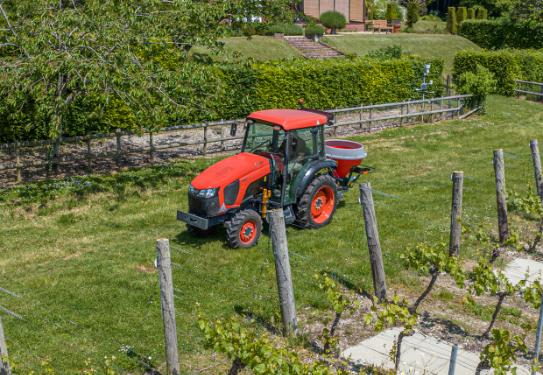
The Royal Highland and Agricultural Society of Scotland (RHASS) has announced the 2023 winners of the Technical Innovation Awards, sponsored by Hillhouse Group, with 2 Gold, 4 Silver and 3 Certificates of Commendations being awarded.
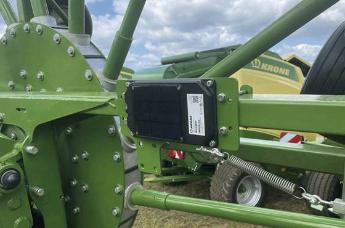

The awards, which are the Society's most longstanding industry accolade, showcase and reward innovation and development within the agricultural sector and are highly respected awards for manufacturers, distributors, providers and inventors.This year's technical innovations will be on display next to our new Agri Innovation Arena. Gold awards are presented to previousSilveraward winners for continuous outstanding merit. This year,Murray Machinery Ltdwon Gold for theGravel Road Grader. The Grader has undergone major upgrades since first appearing on the market, with the addition of features such as hydraulically operated Ripper Teeth, a Tilting Frame, a Compactor Roller and the newest addition, bolt-on reversibleHardoxedges, marker boards, and road lights. With its ability to perform four different functions and in utilising stone from the existing road surface, great savings can be made on time, effort and money spent on maintaining gravel roads.
Also presented with a prestigiousGoldaward this year isLely (UK) Ltd, for theLely Collector
120.Diverging from traditional manure
scrapers, the Collector vacuums manure, resulting in a cleaner floor and maintaining the cleanliness of cows' hooves. The Collector also sprays water from the front and back of the machine, as it moves through the stable. This results in better manure intake whilst leaving behind a wet floor, giving cattle additional grip, especially when passages can getslippyin drier months. The Collector was awarded the RHASS Silver award three years ago and since then sales continue to increase.
R Mitchell & Sonswere awarded a Silver for theWhitriggsBale Unroller. Designed to aid the feeding of outwintered cattle, theWhitriggsBale Unroller allows safe unrolling of bales without the use of heavy tractors and machinery. The Unroller also eliminates poaching and bullying at a ring feeder, ensuring cattle safety. It can carry and unroll 4ft & 5ft bales right to the core and can be used for straw, hay or silage. TheWhitriggsBale Unroller has proven popular among farmers trying regenerative farming practices as it enables the reduction of inputs, helps increase soil organic matter and spreads dung more evenly.
Also presented with aSilveraward isH L Hutchinson LtdforTerraMap. Manufactured bySoilOptix, theTerraMapuses passive gamma-ray detection technology to provide high-definition mapping of soil nutrition, texture, organic matter, and organic carbonto generate some of the most detailed soil maps in the world. With an

increase in environmental targets for farmers to consider,TerraMapdelivers results that help farmers achieve their financial and environmental goals.
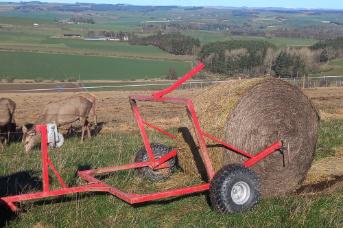
A Silver award was awarded to theClipFittercastration and tailing system which was conceived byProfessor Vince Molonyand commercialisedbyEadie Bros and Co Ltd.ClipFitteraddresses the challenge of castrating and tailing lambs older than 7 days of age. Rings are forbidden in Scotland but clipscan be legally applied up to 3 months and no needles or drugs are required.ClipFitterimmediately disables nerves, sperm cords and blood supply, almost eliminating blood supply entirely.
A Silver award was also awarded this year toWater Fuel Engineering
LtdforHydroGen.HydroGengenerates a gas mixture of 2:1 hydrogen to oxygen, called oxyhydrogen, which functions as an additive to conventional fuel. This not only enhances the engine performance but reduces emissions by 7080%. A unique trait of theHydroGenis that it can be installed on both diesel and petrol engines without modification and can be moved between vehicles, with no impact on the engines or electronics.
Earning a Certificate of Commendation this year arePowerwasherServices Ltdfor thePlantmasterElectra Power Washer,manufactured byMac International.Traditionally, to produce hot water for a device like a power washer, a diesel burner is used. ThePlantmasterElectra Power Washer uses electricity to produce continuous hot water at a constant temperature which is controlled by a thermostat. Because these machines don't use diesel or kerosene, the maintenance costs and servicing needs are reduced making them economically favourable as well as being zeroemission.
Dr Lynsey Melville and Eilidh Geddes,of theMoredun Research Institute,have also been awarded a Commendation for theFEC Check.Sustainable control of roundworms is a challenge for the sheep industry, particularly with advancing drug resistance and climate change.
Targeted application of effective drugs at optimal times is critical for continued production efficiency. This can be achieved using faecal egg count (FEC) testing. FEC Check assists farmers and those who don't have access to advisors, on how to interpret complex FEC results. This will promote the use of FEC testing, improving the sustainability of roundworm control, and reducing inappropriate chemical usage.
A final Commendation was awarded toKrone UK Ltdfor theSmartConnect Solar.The SmartConnect Solar is a self-sufficient telemetry unit that integrates simple machines into a digital data management system. It uses a solar panel and rechargeable battery for power, eliminating the need for an external power source. It includes a position sensor to detect the working and transport position when mounted on a folding arm of a rotary rake. Additionally, it can record the worked area based on the implement's working width.
RHASS Chief Steward of Technical Innovation, Christo Shepherd said:
"Congratulations to all the winners of this year's Technical Innovation Awards. It is fantastic to witness the incredible strides that have been made in the agricultural sector as well as the commitment to innovation and development. These contributions not only set an impressive standard for excellence but also hold the potential to shape the future of agriculture.
"The winners will all be on display this year next to the new AgriInnovationArena at the Royal Highland Show so please make it a priority to visit this section to view these worthy recipients."
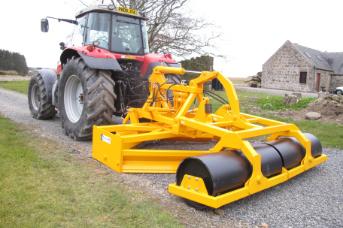
The Royal Highland Show, supported by the Royal Bank of Scotland, will take place 22nd-25thJune 2023. Tickets, including for car parking, must be pre-purchased online this year and no tickets will be available to buy at the gate. Tickets are limited in number this year with sell out days anticipated, so it is advised to purchase early.
For further information and to purchase tickets please visit[http://www.royalhighlandshow.org.%20/ ]www.royalhighlandshow.org.
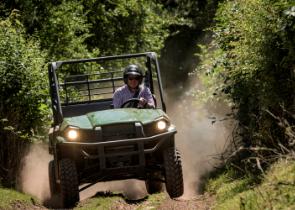

Whether it is working on the farm or transporting materials across construction sites, having the right equipment is essential. The Kawasaki Mule Pro MX delivers the rugged, reliable and adaptable attributes that will help you take on any terrain.

Designed to work hard, the robust Mule Pro MX. Powered by a torqueladen 700cc CVT singlecylinder engine, the Pro MX offers 32.8 kW {45 PS} / 6,000 rpm, guaranteeing a fun-to-drive vehicle that can easily hail cargo for work or weekend fun. The spacious cargo bed is able to carry up to 317 kgs 700 lbs, making chores or hauling gear a breeze.
Measuring 2795mm long and
For more information
1525mm wide, with a wheelbase of 2005mmthe Mule Pro MX is the perfect mid-sized vehicle, offering superb manoeuvrability and mobility that ensures it can negotiate the tightest of trails. To maximise comfort, the all-
effect on the chassis.


Of course, these workhorses are designed to be used throughout the year in all conditions. That is why the Pro MX is equipped with 25” tyres on 12” rims, guaranteeing fantastic offroad traction and ground clearance. Strong and reliable front and rear disc brakes provide effective braking, especially when combined with the Mule pro MX’s proven engine braking.
terrain vehicle features double-wishbone suspension at the front and rear, enabling the Kawasaki to easily traverse obstacles and elevations with minimum
While its performance is unmatched, Kawasaki has also focused on making the Mule pro MX model as accessible and user-friendly as possible. Coming equipped with doors as standard, users will be protected from mud and puddles, while a 5.3 litre storage bin underneath the passenger seat ensures that
there is plenty of space to securely store all of your belongings.
Bright digital instrumentation ensures you can always see essential information at a glance and the console also comes prepped for an accessory audio system. The multi-function display is built directly into the dash and features an array of insight, including:
• Driving mode (2WD/ 4WD) indicator
• Digital speedometer
• Digital fuel gauge
• Clock odometer
• Dual trip meters
• Hour meter
• Differential indicator
lamp
• Check engine lamp
• Electric Power Steering warning lamp
• Water temperature warning lamp
• Seatbelt warning lamp
• Parking indicator lamp
• Reverse indicator lamp
• Neutral indicator lamp
The contoured bench seat complements the body and provides ample space and comfort for two adults at a time. Kawasaki’s high-grade Electric Power Steering (EPS) is speed-sensitive, providing users with light steering at low speeds and tightened steering at higher speeds. It can also work to enhance rider comfort
by acting as a damping system, reducing the bumps and kickbacks created as you go along bumpy terrain. Drivers are also able to set the position of the steering wheel to not only suit their preference but also to lift it out of the way when getting in and out of the vehicle. An electrically selectable 2WD/ 4WD and dual mode rear differential system ensures quick and simple changing to suit the changing terrain.
Since its launch, the Kawasaki Mule Pro MX has established itself as one of the leaders in utility vehicles, used by farm workers, gamekeepers, construction workers and event workers across the globe. More information on the MULE pro MX can be found at www. kawasaki.co.uk



Delivering all the rugged, reliable and adaptable attributes that Kawasaki’s MULE utility vehicle brand is justi ably famous for, the Kawasaki MULE PRO-MX range relies not only on a torque laden 700cc CVT single-cylinder equipped engine but also bene ts from the Shinari design philosophy.
FOR MORE INFORMATION AND TO FIND YOUR LOCAL KAWASAKI DEALER, VISIT WWW.KAWASAKI.CO.UK

Suzuki’s range of KingQuad ATVs now come fitted with an enhanced security package courtesy of partnering with Datatool and Datatag.

Suzuki has been working with Datatag and fitting its CESAR forensic marking system for over 10 years but has recently bolstered its security offering by partnering with Datatool to fit a Thatcham accredited tracking and immobiliser system as well.

The Datatool Stealth S5+tracker and immobiliser actively protect the ATV against unauthorised movement as well as providing hotwire/forced ignition protection. It has been developed for the harsh environments that ATVs must withstand. Waterproof with a built-in antenna, the Datatool Stealth is a cutting-edge tracking device which benefits from a UK-based 24/7/365 Theft Monitoring Team and is 4G-enabled for superior tracking abilities as well as providing tow-away alerts and key cloning protection. In addition, the Datatool App enables customers to see the location of their ATV in real time as well as journey history so you can see where the vehicle has been used.
Suzuki’s range currently comprises of three versatile models; the KingQuad 500 and 500XP as well as the KingQuad 750XP (XP denotes power steering). These robust utility ATVs are the culmination of years of refinement and their high
levels of technical specification and ease of handling give riders confidence on any terrain, making them suitable for several applications including hill and lowland farming, estate management and use on equestrian properties.

said, “We’re pleased to be able to include these security features within the cost of our ATVs. A Suzuki KingQuad is an invaluable asset to a wide variety of businesses, particularly in the agricultural industry, so we understand the need to protect them as much as possible. We hope customers will see the new tracker and immobiliser system as
another added value benefit and an additional reason to choose Suzuki.”
Customers can find out more by seeing Suzuki at the forthcoming Royal Highland and Royal Welsh Shows or visiting: www.atv.suzuki.co.uk

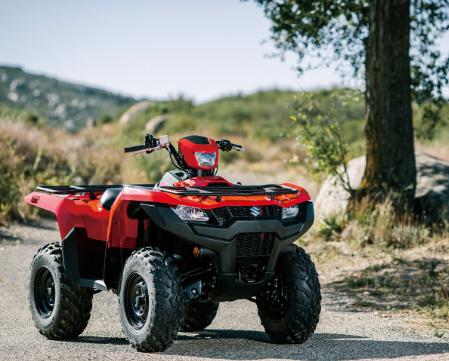

To explore the range or find out more visit: atv.suzuki.co.uk

he innovative range of HiSun lithiumion-powered electric utility vehicles is designed to work just as hard, if not harder, than traditional fuel-powered machines. There are four models, 5 kW, 7.5 kW, 15 kW and a 4-seater 15 kW.
The move to electric UTVs offers many benefits over petrolpowered machines. There is no compromise on power, with these latest lithium-ion UTVs providing all the power needed for use in tough, off-road conditions. They are free from harmful carbon emissions, which supports the shift to a virtually zero-carbon economy in the drive to tackle climate change and reduce global warming.
These multi-functional, hardworking machines are ideal for applications in farming and agriculture. Due to their compact size, they are versatile and convenient for many farm chores that larger vehicles are not suited for; transporting feed to livestock in remote areas, hauling equipment, towing, ploughing and harrowing.
The top-of-the-range Sector 15




kW has all the power and torque to tackle the most challenging terrains. With the ability to climb steep slopes, the Sector 15 easily handles 30-degree plus inclines in forward and reverse. When the going gets tough, you can switch to selectable fourwheel drive with rear/front diff locks to tackle difficult terrain.
The 4-seater version of the 15 kW UTV can transport up to four passengers, carry machinery and equipment and easily tow heavy loads. The lithium-ion technology batteries that power both models are designed for longer run times, and a single charge will keep the UTV working for a full day.
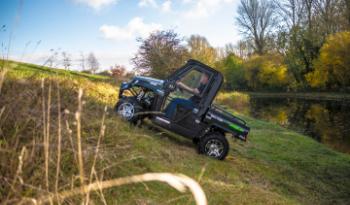

Like its bigger brother, the Sector 7.5 kW is a reliable, everyday machine capable of tackling many tasks, whatever the weather. The open cargo bed will carry up to 280 kg/ 67 lbs, ideal for transporting everything from logs, hay, tools and equipment.

The smallest of the lithium-ion powered models, the 5 kW UTV still has the power and torque to climb slopes over 30 degrees. The longer run times of the lithium-ion batteries will keep this reliable worker going for up to 44* miles on a single charge.
There is also a 49-volt dry cell battery model, the Vector E1. Producing 27 hp, the Vector E1 is
powerful enough to go over the toughest terrain without all the noise of petrol-powered engines. Selectable 4-wheel drive, nitrogen-assisted independent suspension and four-wheel hydraulic brakes add to the Vector’s all-terrain credentials.
All models have the option of the DFK fully enclosed cab kit that includes a glass windscreen with wash/wipe, rear screen, metal roof, and lockable doors so that the UTVs can be customised depending on customer requirements.


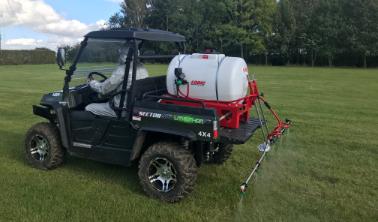
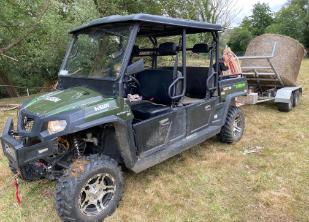
Choosing electric power offers huge savings in fuel costs, with an overnight charge costing around £1*. There is also the bonus of no road tax, as electric UTVs can be used both on and off-road. Electric UTVs are usually cheaper to service and maintain with no engine and fewer parts to service.

The quiet electric motor is a key attribute making these machines ideal for driving near animals or in areas where noise must be kept to a minimum. An electric UTV has no gearbox, so
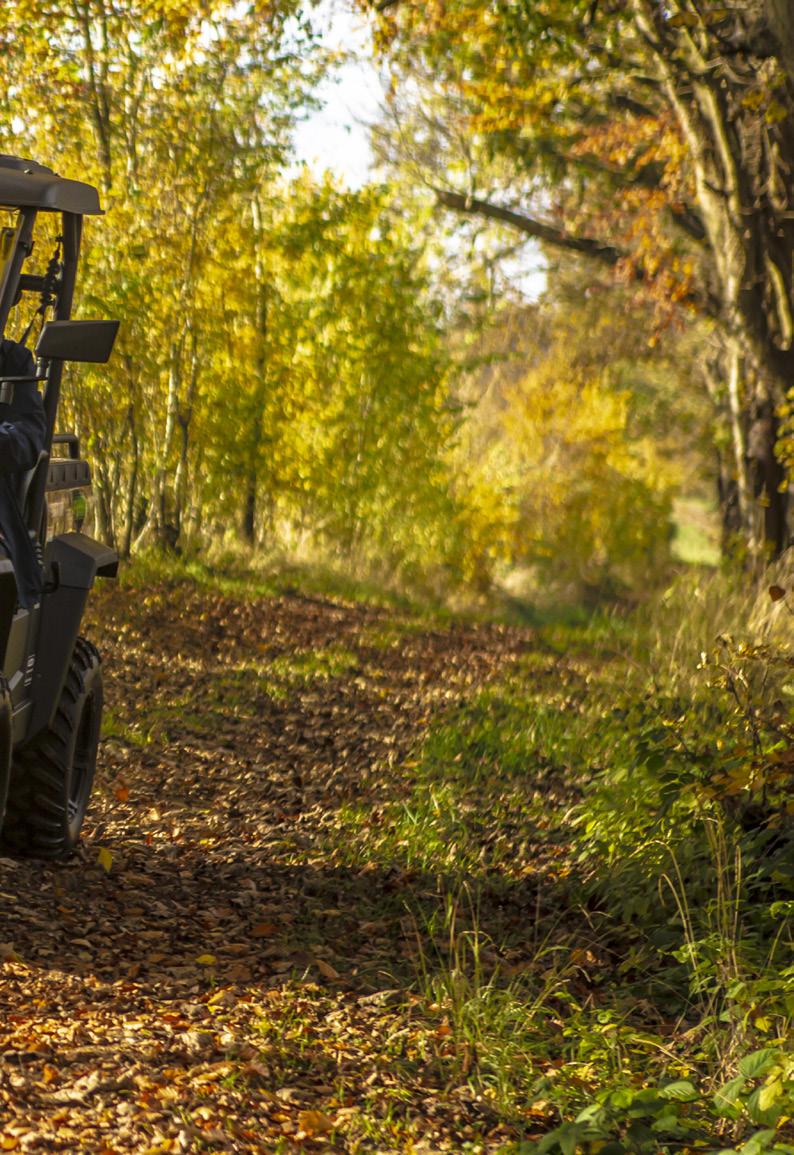
acceleration is smoother, making for a more comfortable ride.
HiSun vehicles are supported and distributed in the UK by Barrus Ltd. For more information visit www.barrus.co.uk, call 01869 363665, or email vehicle@barrus.co.uk
*Figures quoted are intended as a guide only. Cost/mileage would be dependent on usage and conditions.




Technology, based on their research into Kando* experiences.
The installation has two people experience it at the same time, with players repeatedly communicating to each other through nonverbal and intuitive means. Each player creates a “note” on the round touchscreen and sends a rhythmic pattern to the other player. At the same time, touching the note sent by the other player creates a ”tone” and thereby plays the rhythmic pattern created by the other player. Based on the results of our

YWill display experiential installation that reproduces the Kando pursued by both Yamahas through science and art amaha Motor and Yamaha Corporation are pleased to announce that they will jointly put on an experiential installation (an interactive artwork) called "eplegona" at two of Europe’s foremost technology events in Berlin, Germany: the hub.berlin (June 28–29) and the Tech Open Air Festival (July 5–7). This will be the second time that this installation will be exhibited, following its debut at the South by Southwest 2023 (SXSW 2023) festival for media, music, and technologies held in Austin, Texas, USA earlier in March this year.
The "e-plegona" is an installation created by the design departments of Yamaha Motor Company and Yamaha Corporation, in collaboration with research partner Dr. Mark Changizi and the Shinsuke Shimojo Laboratory at the California Institute of

unique research combining science and art together with our research partners, this experimental prototype artificially stirs the emotions with non-verbal, intuitive communication to produce a connected vibe between people—like jazz improvisation—or the same sense of connection people often feel toward musical instruments or motorcycles in order to simulate experiences of Kando*.
When we exhibited at SXSW 2023, the venue was always crowded with visitors and the installation drew much attention, even being the first display shown in the official introduction video published on the event’s social media channels (Twitter). Visitors who tried the installation offered comments like: “I paired up with someone I had never met before, but I could really feel our communication start to improve and it was a
moving experience”; “It really felt like ‘digital communication’”; or “This is in the realm of engineering emotion.”
The purpose of exhibiting at these two events is to allow as many people as possible to experience the essences of Kando envisioned by both Yamahas, and to also deepen the understanding of the core value sought by both Yamahas together with visitors who experience the installation, so that the Yamaha brand as a whole can deliver even greater Kando* to customers.
*Kando is a Japanese word for the simultaneous feelings of deep satisfaction and intense excitement that we experience when we encounter something of exceptional value.

Balancing loads on front and rear racks, sitting astride a saddle, having no room for a passenger and being fully exposed to the elements –while the ordinary ATV also has its benefits, there are plenty of downsides to the ‘quad bike’ design. So the side-by-side utility vehicle (UTV) alternative, with its full load bed, conventional seating for more than just the driver, and either cab frame or full cab, offers many advantages. But with a number of machines on the market from which to choose, selecting the right UTV for farm use can be a difficult task. Separating out the models with design features clearly built to withstand the rigours of agriculture is a worthwhile exercise.
A diesel engine that offers both power and economy is a given on most lists of ‘wants’, saving trips to the fuel station for petrol and providing the torque needed to climb hills and clamber over tough going. With Kioti’s K9, the successor to the popular Mechron, a three-cylinder powerplant, built by the same manufacturer as the machine itself, provides efficiency and energy in equal measure, along with the reliability for which South Korean engineering has become synonymous. Minimal fuel stops are another prerequisite for any agricultural vehicle, and with 37 litres of diesel capacity, the K9 is capable of long days without refuelling.
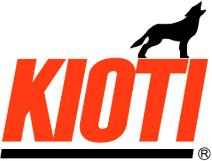
Surefooted traction and a decent turn of speed with a comfortable ride are also on the agricultural ‘wants’ list, and the K9 meets the bill here with a twin-range CVT transmission that provides smooth take-off and slow-down. There is also quickly-selectable 2/4wd and a locking rear diff, plus a helical spring/stabiliser arm suspension arrangement that cushions the driver/passengers and the load in rough going. And for smoother terrain, the K9’s top speed is a rapid 40km/hr (25mph).
A UTV engine also needs to provide the

guts to shift a full payload with ease, and the K9 doesn’t disappoint here. The 1.0-litre powerplant produces 24hp, more than enough to shift the machine’s 0.5-tonne load capacity with ease, meaning it is competent and capable of handling typical agricultural loads of fencing stakes, spare parts, slug pellet bags and more. A urethane coating ensures long-term bed protection, while options include hydraulic tipping –mechanical tipping is standard. For additional items there’s an optional storage box under the hood.
Of course, one of the most important features of a UTV is its ability to carry more than one person legally, safely and in comfort. The Kioti K9 features two full seats with an optional smaller mid-seat, all with safety belts. A full roll-over frame with roof is standard, while options include a windscreen, half-doors and, for maximum weather protection, a full cab package with heating. Full road lighting and mirrors are standard, as is front bull-bar protection to guard against the knocks and scrapes that are unavoidable in agriculture.

A vehicle aimed at satisfying the demands of agricultural buyers needs to be universal in what it can carry, and to

this end the K9 is available with a wide range of rear fitments, such as a galvanised livestock canopy ideal for transporting lambs. There are also hitch hooks at both the rear and the front of the machine, making it possible to not only pull a variety of trailed implements, but also manoeuvre equipment around the yard. Meanwhile, on the options list is an external hydraulic outlet, for even greater versatility –powering a tipping trailer, for example. The K9 has a maximum towing load of 590kg, helping to more than double its carrying capacity.
Stability and manoeuvrability are also essential factors for an agriculturallytargeted UTV. With a width of 1,590mm, the K9 can squeeze through tight door-, passage- and gateways, while ground clearance of 304mm ensures it rides over rough terrain with ease.


For all their uses off-road, UTVs are often also called upon to travel on the road between tasks in different fields, and for this, of course, road
homologation is a must. With the Kioti K9, that’s not an issue, as the machine is fully homologated for road use. And like every machine on the farm, reliability is critical to ensure uninterrupted work. Kioti UK, which recently moved to brand new premises in a central and accessible location
close to Huntingdon, and has a dealer network of more than 80 outlets, now provides a full two years’ warranty for the K9, with unlimited hours. Along with a specification that more than matches agricultural needs, that’s another factor in favour of the K9 on many farmers’ UTV ‘wants’ lists.
Think carefully about what’s on your ‘wants’ list before choosing a UTV, suggests Kioti.
Volkswagen Commercial Vehicles has announced the UK vehicle specifications and pricing for the new Amarok. The premium pick-up is available in a choice of four trims – Life, Style, PanAmericana and Aventura –with prices starting from £33,000*.


The new Amarok’s front end is characterised by bold horizontal upper radiator grille crossbars, while the rear end is distinguished by new C-shaped rear lights. The length and longer wheelbase of the new Amarok creates more room in the cab, while shorter overhangs improve the off-road ability. Add in new technology – including 30 driver assistance

features - and the second-generation Amarok redefines the premium pick-up sector, offering a reliable companion for customers seeking comfort without sacrificing load-lugging or offroad capabilities.
The entry-level trim, Amarok Life, focuses on Comfort, featuring 17-inch Combra silver alloy wheels, LED headlamps, a 10-inch infotainment screen and a key safety feature of a rear-view camera system.
The Amarok Style builds on the features of the Amarok Life, while adding greater design to the aesthetic, including 18-inch Amadora silver alloy wheels, a Chrome styling bar and black side steps with a chrome insert for a more premium feel. It also includes an upgraded 12inch central infotainment screen with navigation, as well as additional safety

features, such as Area View 360° camera.
TheAmarokPanAmericana focuses on off-road ability. The driveline features a rear locking differential, underride guard, as well as the comfort suspension system. Upgraded 18-inch black Amadora alloy wheels, and the premium bumper with black ‘X’ insert add to the design enhancements.
Therange-topping Amarok Aventura stands out for its design, with 21-inch Varberg silver alloy wheels, chrome-plated exterior mirror and door handles, and premium bumper with silver ‘X’ insert.
All new Amaroks will also come as standard with Volkswagen Commercial Vehicles’ ‘the 5+ Promise’ which gives customers five years’ peace of mind with five services (three Oil Change, two Oil Change and Inspection plus three MOTs), a five year warranty (extended from the standard three year warranty) and five years’ roadside assistance (extended from standard three) (Ts and Cs apply – see www. volkswagen-vans.co.uk for details).
The new Amarok officially goes on sale from 12 June 2023, with first deliveries from late summer 2023. More information on the new Amarok can be found here:

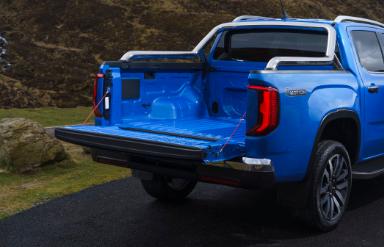
https://www.volkswagen-vans.co.uk/en/newvehicles/new-amarok.html
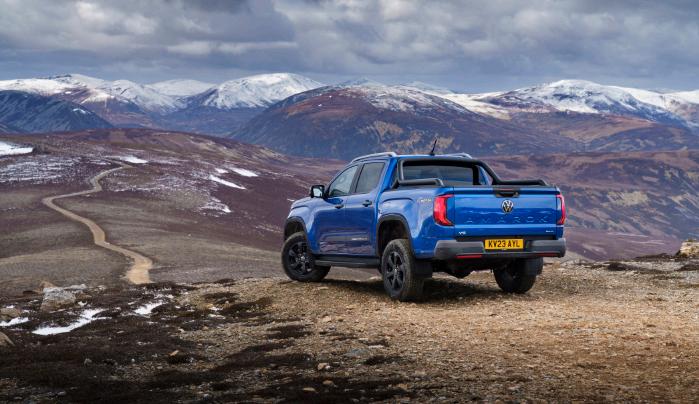
Isuzu UK, the nation’s distributor of commercial, agricultural and lifestyle pick-ups, will be bringing the newest iteration of its renowned D-Max range to the prestigious SMMT Test Day on Thursday the 25th of May at Millbrook Proving Ground.

The Society of Motor Manufacturers and Traders (SMMT) annual test day brings together industry leaders, media representatives and automobile enthusiasts to experience the latest developments in the automotive industry. This year, after unveiling the New-Look Isuzu D-Max at the Commercial Vehicle Show in Birmingham, Isuzu UK will be providing attendees with
the opportunity to drive the updated range for the first time at the venue.
The New-Look Isuzu DMax range maintains its award-winning 4x4 expertise, with primarily cosmetic alterations for the 2023 model. Each trim level has received significant visual enhancements, including a restyled front grille and new wheel designs. While the All-Purpose and Adventure models feature the new wheels, the Business range retains the practical steel wheels which are a staple on the Isuzu D-Max Utility model. Two new colours have been introduced, with Biarritz Blue available for DL40 and V-
Cross models, while Dolomite White is exclusive to the range-topping V-Cross model.
Throughout the course of the event visitors will be permitted to test drive four New-Look Isuzu D-Max pick-ups, which includes a vehicle of each trim level: Utility, DL20, DL40, V-Cross. Additionally, press packs for the New-Look Isuzu D-Max will also be
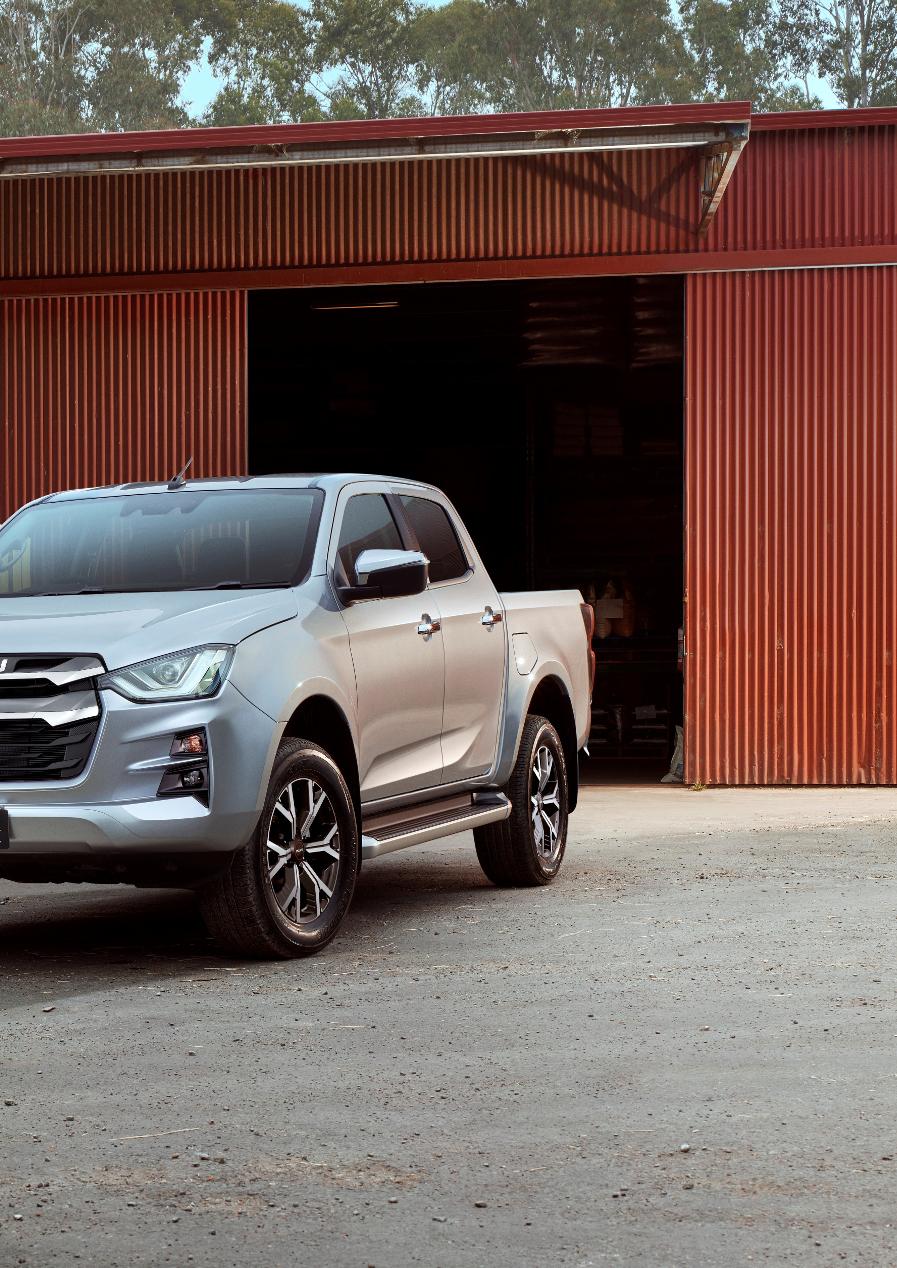
available via email upon request.
Managing Director of Isuzu UK, Alan Able, commented: “After the extremely positive reception of the New-Look Isuzu D-Max, we are very pleased to be exhibiting the updated range at this year’s SMMT Test Day. The new models have already received significant consumer interest, and giving industry professionals the opportunity to not only see but drive the vehicles will further solidify Isuzu UK’s position as a leading player in the pick-up market.”


Kia is introducing a suite of smart technologies that aim to make electric vehicle (EV) mobility more convenient, accessible, and efficient than ever before – with Kia Connect, Kia Charge and Kia Smart Charging: V1G (Automated Unidirectional Smart Charging), V2H/B (Vehicle-to-Home/Vehicle-toBuilding), and V2G (vehicle-togrid).
“Delivering the next generation of sustainable mobility solutions involves the seamless and holistic interaction of electrification, connectivity and new services,” said Sjoerd Knipping, Vice President of Marketing and Product at Kia
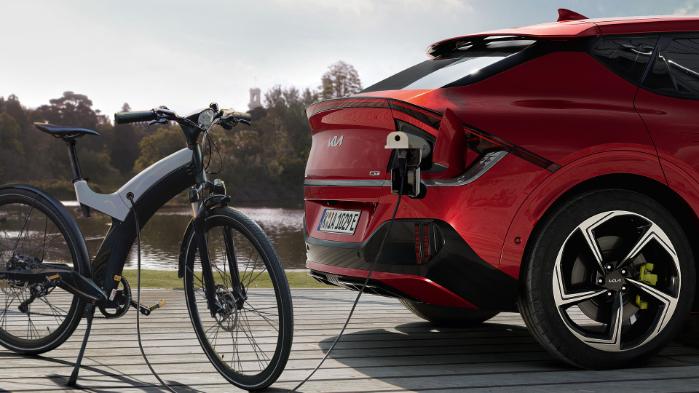
Europe. “Starting with the new EV9 Kia is working towards making EVs fully connected and future-ready to enable vehicles to be updated as new innovations and features become available.”
Kia’s overall technology strategy aims to create seamless and simple connectivity through integrated networks. Kia Connect promotes an “always on” connection between the vehicle, Kia servers and data providers, enabling the live streaming of data to deliver real-time updates and information to drivers, via the Connected Car Cloud. Kia
also utilises live data to improve the customer experience by making it easier to find available charging stations and predicting vehicle maintenance. Additionally, live data can help make roads safer for everyone, enable efficient management of fleets, and improve emergency response times.
The company’s connectivity strategy extends to the dedicated Kia Connect app that allows customers to take advantage of features available in the new Kia Connect Store. This store is the go-to place for customers to purchase upgrades for their cars, enabling a vehicle to be continuously updated with the specific technologies the customer wants.
The EV9 will be the first car that will benefit from the Kia Connect Store, which is also the first Kia vehicle to have the Connected Car Navigation Cockpit (CCNC), with dualband GPS for improved location accuracy. Over-the-air updates enable the system to undergo constant improvement, with the latest maps, interfaces and software enhancements. On top, the Kia EV9 will also have the EV Route Planner feature, which suggests you the best charging points based on your vehicle battery level while travelling to your destination.
Kia's global strategy is to make charging both frictionless and convenient for our customers, whether at public charging stations, at dealerships, or with the wallbox at home.
The Kia Charge app enables customers to utilise a comprehensive charging network from a single point of access. The network in Europe includes more than half a million charging points in 28 countries, and it continues to grow thanks to pan-European partnerships with Ionity and Digital Charging Solutions (DCS) as well as local charging providers.

For public fast-chargers, Kia is expanding regional joint ventures to establish 30,000 new chargers by 2030. The company is also setting up cobranded fast chargers at
dealerships for a more personalised and comfortable charging experience.
Kia Smart Charging gives customers greater flexibility for charging electric vehicles. Advances in vehicle connectivity are taking EV charging and power usage into the sustainable era, through bidirectional charging. This enables energy to flow both ways, into and out of the vehicle. Therefore, the EV9 is capable of V1G (Automated Unidirectional Smart Charging, Vehicle-to-Load (V2L), Vehicle-to-Building/Vehicle-toHome (V2B/V2H) and Vehicleto-Grid (V2G).
vehicle can transfer energy directly to the grid for wider use.
A V2G-enabled vehicle, such as the EV9, can be utilised to store energy gained from renewable sources and feed it back into the power grid at times when the sun isn’t shining, or the wind isn’t blowing. This can help to stabilise the grid, support the use of sustainable energy, and potentially reduce the customer’s electricity costs. On a broader level, thousands of electric vehicles connected to the grid could act as a virtual power plant, potentially providing enough energy to power towns and cities for temporary periods.
As Kia continues its bold
V2L, first introduced with the Kia EV6 and available standard with the EV9, allows customers to power 110V/ 220V appliances using their EV9 battery by plugging the cable into the EV charging port. V2B and V2H refer to the vehicle’s ability to power a building or the customer’s home (a fully charged EV9 with a 99.8kWh battery could power a household for five to 10 days). V2G means the
transformation to become a sustainable mobility solutions provider, the company is making connectivity, electrification, and sustainability an absolute priority – by launching 15 EVs by 2027, as well as innovations that will improve mobility across Europe, and power grid support that will help Europe’s energy industry.
Lynk & Co has announced a partnership with BCA Europe for the remarketing of its used cars. This covers the 7 European markets the Swedish brand currently operates in.
This strategic partnership enables a centralized approach for the remarketing of its cars that have been part of the Subscription program.
The partnership with BCA Europe will ensure that the defleet is done in a simple and hassle-free process – which aligns well with the values of the Lynk & Co brand. Members returning vehicles will be provided with a remote inspection tool and after collection, each vehicle will go through a standardized industrial inspection, focusing on both cosmetic and mechanical state, with reconditioning available where required.
The partnership will help to ultimately increase the lifetime use of each Lynk & Co vehicle. With increased visibility within the used car market, and possibly a positive impact on the residual value of the 01, this partnership positively impacts the overall total cost of ownership.
Importantly, this appointment gives a wider audience the chance to experience the Lynk & Co 01 and the unique mobility offering the brand is renowned for. Next to that the end user of the cars sold will be welcomed to the Lynk & Co community offering them to share their 01 with borrowers on the brand’s platform.
BCA Europe is operational across the 7 key markets for Lynk & Co, which combined with excellent coverage across the rest of Europe, ensures there is a robust audience for the de-fleet and remarketing of the Lynk & Co 01.
Alain Visser, CEO of Lynk & Co said: “This partnership with BCA Europe not only allows us to increase lifetime usage of our 01 car, to help maintain a sustainable future, but it also means we can offer even more customers a chance to experience our product.”
Launched in 2021, Lynk & Co offers mobility solutions for the connected generation. The innovative membership-based approach makes it easy for members to access a car on a flexible, month-to-month basis and share with friends, family, and the Lynk & Co community.
Now, with the appointment of BCA Europe, a wider range of new customers will get the chance to experience the brand and join the Lynk & Co community. The sharing functionality of the Lynk & Co 01 is one of the core values of the brand and will continue to be available in all its used cars in the same way as it is to members on the month-tomonth membership.

EV drivers can make even greater savings than the newlyannounced forthcoming electricity price reductions, says Ohme, the UK’s fastestgrowing smart charging company.
Today, the market authority Ofgem announced that the Standard Variable Tariff for domestic electricity rates would be lowered to 30p/kWh from 1 July. The reduction is down from the current 34p/ kWh which has been in place since 1 October 2022.
While the news will be welcomed by EV drivers keen to reduce their charging costs, Ohme is encouraging those same drivers to make even greater savings by switching to an off-peak EV tariff such as those from Octopus or Ovo.
“It’s great that the Standard Variable Tariff is being lowered which will help EV drivers to reduce their charging costs,” says Ohme CEO, David Watson. “However, drivers can lower their bills further still by speaking to their existing electricity supplier and finding out if they offer an off-peak tariff. If their energy provider doesn’t offer an off-peak tariff, then they should consider switching to one that does, to get the full savings of running an EV.”
With the average UK driver covering 6800 miles a year, charging on an off-peak tariff in a typical EV would cost just £127.50 for a year’s worth of driving with Octopus Intelligent at 7.5p/kWh. At the new Standard Variable Tariff of 30p/kWh, that same annual mileage would cost £510. By comparison, the same mileage in an equivalent petrol car
would cost a driver more than £1100.
Ohme’s Home Pro smart charger can connect with the national grid in real time and automatically adjust its charging for drivers to take advantage of all the times of low price charging with smart off-peak tariffs. Ohme also offers drivers the option to charge their car when renewable energy generation on the National Grid is at its highest, further lowering their CO2 impact.
Ohme is the official charger provider for the Volkswagen Group in the UK and Ireland as well as customers on the Motability scheme, the largest UK fleet operator in the UK, and has been named as the Best Electric Charging Point Provider by Business Motoring.

MAHLE Powertrain and Clean Air Power have signed a Memorandum of Understanding to combine their efforts in providing rapid and cost-effective solutions for net-zero fuelled internal combustion engines. The two companies have a longstanding collaborative relationship that has shown excellent results across a number of important research projects. As part of these efforts, MAHLE Powertrain will continue to explore opportunities to use their flexible engine control unit in conjunction with Clean Air Power’s fuel delivery systems.
emission heavy goods vehicles under 26 tonnes by 2035, with all new trucks to be zero emission by 2040,” said Dr. Mike Bassett, Engineering Director, MAHLE Powertrain. “These far-reaching legislative demands and their aggressive timescales mean there is strong industry interest in developing engines for heavy duty applications that can operate efficiently on zerocarbon fuels.”
MAHLE Powertrain has a long history in the development of internal combustion engines. The company’s flexible engine controller, one of many innovative solutions, is particularly well suited to the
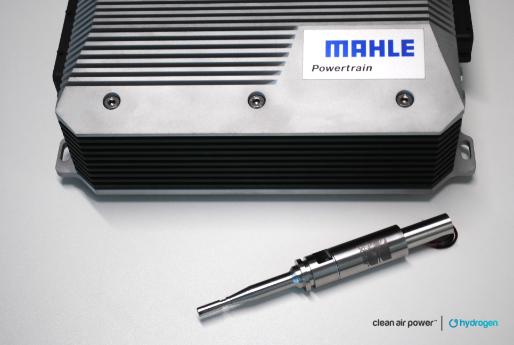
utilising alternative fuels or novel technologies.
Clean Air Power is developing injector technology aimed at supporting the use of zerocarbon and renewable fuels such as hydrogen or methanol. Clean Air Power has focussed on higher power transport solutions such as truck and bus, rail and marine applications, and is already supplying fuel injectors for dual- and single-fuel applications for both, retrofit and new engines.
Dr. Dan Skelton, CEO, Clean Air Power said: “Zero-carbon internal combustion engines offer a solution in difficult to decarbonise applications where battery and fuel cell technology may not be best suited. This agreement opens up the opportunity for us to collaborate further to accelerate development in this important and exciting area, assisting the transition to net-zero and helping establish a pathway for the roll-out of clean fuels.”
“The UK was the first country in the world to commit to phasing out new, non-zero
development of demonstration units, as well as low volume production applications
The two companies have recently collaborated on the development of retrofit sustainable propulsion solutions for high performance marine vessels for the Royal National Lifeboat Institution (RNLI), as well as the investigation of red diesel replacement technology for off-highway and agricultural sectors.
SsangYong Motors UK is pleased to announce the addition of Trenton Grimsby to its dealer network. Trenton group, which began trading in 1984 has two multi franchise showrooms, located in Hull and Grimsby, and represents the high standard of dealer group that SsangYong prides in having within the network.
Kevin Griffin, managing director at SsangYong Motors UK, said “We are thrilled to welcome Trenton Grimsby to the SsangYong franchise. The group endeavours to provide its customers with excellent and trustworthy service and

has values that align with our own. We are very much looking forward to working with the team in Grimsby and welcome them on board”.
The Grimsby based showroom has modern facilities and provides customers with a relaxing environment providing a hospitality area to enjoy complementary refreshments, as well as free Wi-Fi. Visiting customers can appraise the brands multiple-award winning and stylish model line-up, which includes the Rexton, Musso, Tivoli and Korando. In addition, there is a full aftersales centre offering servicing, MOT, repairs, and approved parts.
Trenton Group celebrates almost 40 years of trading this year and still holds the same standards of customer service as when they began. They increase SsangYong’s presence in the Northeast Lincolnshire. Andrew Woodhall, operations director at Trenton Grimsby, said: “We are extremely excited to add the SsangYong range to our showroom here in Grimsby. It is another opportunity for us to showcase our quality services to customers and the quality vehicles that SsangYong continue to produce. We’re very eager to get started.”
Munro Vehicles (Munro), a manufacturer of all-electric 4x4s, and Scotland’s only volume production car company has revealed its second model, the Mk_1 PickUp, at Fully Charged Live North 19th– 21st May 2023.

The ultra-capable, ultrautilitarian pick-up follows swiftly in the wheel tracks of the Munro MK_1 Truck launched last December. The MK_1 Pick-Up signifies the next milestone of Munro’s strategic mission to fulfil
significant global market demand. Like the Munro MK_1 Truck, the MK_1 Pick-Up’s unique abilities enable customers operating in challenging sectors such as mining, construction, utilities, agriculture, and defence to meet imminent decarbonisation targets without compromising on performance.
“Priced from £49,995 Ex VAT with deliveries commencing later this year, we have already secured more than 200 orders for the MK_1 PickUp, three of which have come
from FTSE 100 companies and ten from FTSE 250 companies” confirmed Munro CEO and Co-Founder Russell Peterson. “With a full two-year order book for both the MK_1 Pick-Up and the MK_1 Truck, Munro is having to expedite its search for larger premises to meet customer demand.”
Unveiled in ‘Performance’ guise in striking Munro yellow paint finish, the Munro MK_1 Pick-Up creates an purposeful visual presence. As with all models and variants of the Munro MK_1 range, the new pick-up combines the rugged
reliability and easy repairability of a full-time 4x4 mechanical drivetrain to provide uncompromising ability in all weathers and all terrains, with a state-of-the-art electric powertrain to ensure no tailpipe emissions are left in the vehicle’s wake.
The spacious, easy-to-load rear bed of the Munro MK_1 Pick-Up accommodates a 1050kg Euro Pallet payload, while the Performance model has a 3,500kg maximum braked towing capacity for effortless haulage of any cargo from farm implements and livestock to construction and disaster relief equipment.
82.4kWh battery from 15 to 80% can be swiftly undertaken using a 100kW DC charger in just 36 minutes. With a fully charged battery, the MK_1 has a range of more than 190 miles, enabling it to operate off-road for up to 16 hours on a single battery charge.
Designed, engineered, and built in Britain, the Munro is the first light vehicle to enter production in Scotland in more than four decades.
delivering ultimate, goanywhere, off-road ability,” continues Peterson.

Producing a prodigious peak power output of 375 / 280kw combined with instantly available 700Mn / 516ft-lb of torque, the Munro MK_1 Pick-Up dispenses the sprint to 60mph in a mere 4.9 seconds. A 220KW electric motor and a choice of Utility and Range variants are also offered.
“We launched Munro to fill the significant gap in the market for an electric-powered, fourwheel-drive, utilitarian workhorse. Our vehicles are designed and engineered without compromise from clean sheet principles unimpeded by any existing architecture. The result is a rugged construction created for decades of service


“The levels of positive feedback we have experienced from media and customers who have test driven the MK_1 Truck has been unprecedented and the response to the new MK_1 Pick-Up has been equally positive. This, and the 200 plus pre-orders we have taken across both the truck and Pick-Up models, gives us great confidence that the vehicles Munro has created are precisely what the market wants and needs and that we can play a key role in assisting those operating in challenging environments such as mining, construction, utilities, agriculture, and defence to meet imminent decarbonisation targets.
“This represents a significant global market opportunity and one which, with our financial partners, we are poised to fully exploit as we take the next strategic step and move towards the preproduction prototype stage.”



Fisker Inc. (NYSE: FSR) ("Fisker"), driven by a mission to create the world's most emotional and sustainable electric vehicles, announces a new partnership with Allianz Partners, a leading company in B2B2C assistance and insurance solutions, to provide comprehensive roadside assistance for Fisker customers in Europe.
Bringing decades of experience in roadside assistance, and a commitment to sustainability as a leading provider to Battery Electric Vehicle players, Allianz Partners provides Fisker customers 24/7 access to a full suite of services from breakdown and tire support to managing alternative travel arrangements and more,
providing reassurance and peace of mind for drivers on the open road.
“At its core, Fisker is committed to providing our buyers with high-quality products and industry-leading services. Allianz Partners is a great partner for us, building on our commitment to deliver confidence and convenience to our drivers every day,” says Henrik Fisker, CEO and Chairman of the Board.
“We are very proud that Fisker appointed us as partner of choice for their roadside assistance program in Europe. At Allianz Partners we uniquely combine services, insurance, digital technology and the human touch – just a click away, ensuring that our customers have peace of mind
while on the road”, says Tomas Kunzmann, CEO Allianz Partners.
Allianz Partners’ service portfolio will be accessible to customers in 15 European markets, starting in Fisker’s launch markets of Austria, Denmark, France, Germany, Norway, Sweden, and the United Kingdom.
The assistance package is available to Fisker customers for up to six years or 100,000 km / 60,000 UK miles, whichever comes first. It includes coverage in a broad range of more than 20 European countries outside the driver’s home nation for further reassurance on trips abroad.

ROAD SAFETY AND breakdown recovery provider GEM
Motoring Assist is warning drivers who take hay fever remedies to be aware of the possible drowsy side effects some remedies can produce.
the risk of a collision.
GEM chief executive Neil Worth said: “The symptoms of hay fever can be very uncomfortable, with a risk that they will impair your ability to drive safely. At the same time some medicines used to treat
• Ask your doctor or pharmacist if a medicine could affect your ability to drive. Be particularly careful if you are using a medicine for the first time.
• If you do experience potentially dangerous side effects from a medicine, don’t drive. Organise a taxi or a lift from a friend if you need to travel.
• If you find a particular medicine is making you sleepy, consider asking if there is a non-sedating alternative available.
Experts warn that a heavierthan-usual pollen allergy season is expected this year, due to recent heavy rainfall which has caused a surge in grass growth across many parts of the country. When grasses flower they release clouds of pollen, spelling misery for hay fever sufferers.
The peak grass pollen period is usually the first two weeks of June, with a second peak in early July.1
As well as warning drivers about the medicines they may choose, GEM is also advising drivers against getting behind the wheel while experiencing symptoms of hay fever. Sneezing, a runny nose, streaming eyes and coughing all bring the risk of impairment and distraction, and increasing

hay fever can make you tired or groggy, potentially compromising your ability to react to hazards while driving.
“We encourage you to check with your GP or pharmacist, and to read any warnings contained on the labels of the medicines you plan to take.
“The same road traffic laws apply to therapeutic drugs as to illicit substances, so if your driving is impaired and you cause a collision, you risk prosecution and the loss of your licence.”
Hay fever, also known as allergic rhinitis, affects almost 10 million people in England, of all ages. That's almost one in four adults and one in 10 children.
• If you decide not to use a remedy, bear in mind that the symptoms of hay fever itself can impair your ability to drive. So if pollen counts are forecast to be high, please ask someone else to drive – or use another form of transport.
• It’s not just prescription medicines that can cause drowsiness and other potentially dangerous sideeffects. So, check with your pharmacist if you plan to use an over-the-counter drug.
• If you’re unsure about the warning given on the medicine you’re using, ask your doctor or pharmacist to explain any risks… before you drive anywhere.
Follow GEM on Twitter
@MotoringAssist for the latest industry news.

MG Motor UK has unveiled images of its new, comprehensively updated HS SUV, revealing a striking new design for the company’s bestselling flagship SUV.

Following an extensive redesign, the new HS offers drivers a sharper, more aggressive appearance. At the front, new bi-function LED headlights, a bold grille design and a new front bumper create an enhanced look that confirms the HS as MG’s largest, most
luxurious SUV.
At the rear, a new bumper design, revised dual exhaust outlets and LED taillights complete the contemporary styling update, alongside a striking 18’’ diamond cut wheel.
Urban Grey is also now
available for the first time within the HS range, as part of an extensive seven colour palette including solid, metallic and tri-coat options.
Guy Pignouakis, Commercial Director at MG UK, comments:
“The MG HS has proved to be very popular with UK customers but we’re further improving the car with a muchenhanced design and two generouslyequipped models to choose from that still retain a very strong value proposition for our flagship SUV.”
SE and Trophy models introduced

The new MG HS will now be offered in SE or Trophy specification which have proved popular with UK customers when introduced on the multi award-winning MG4 EV.

Both models are powered by a 1.5-litre, turbocharged petrol engine delivering up to 162PS. A manual gearbox is available as standard, with an optional dual-clutch DCT gearbox offered on both SE and Trophy specifications.

The SE specification, priced from £23,495, includes bi-
function LED headlights with front and rear sequential indicators for the first time, alongside air conditioning, satellite navigation, rear parking camera with sensors, rain sensing wipers, keyless entry and a leather steering wheel as standard.
The Trophy, priced from £25,995, includes leather upholstery, heated front seats, dual zone climate control, ambient interior lighting, rear privacy glass and an upgraded 6-speaker audio system.

Both the SE and Trophy are
equipped with MG Pilot, the company’s comprehensive package of safety equipment which includes Active Emergency Braking with Pedestrian and Bicycle
Detection, Lane Keep Assist with Lane Departure Warning System, Intelligent Speed Limit Assist, Blind Spot
Detection, Rear Cross Traffic Alert and Intelligent High Beam Assist.
The company will continue to offer the current plug-in hybrid MG HS PHEV model alongside the new 2023 HS Petrol.
EHRA, a new global ultra-premium EV brand, has started a partnership with Austrian headquartered battery supplier Miba Battery Systems (Miba) to develop bespoke battery solutions for the AEHRA SUV and Sedan models.
The technical partnership with Miba will enable AEHRA to elevate the battery technology that will power its SUV and Sedan models significantly beyond that offered by traditional ‘off-the-shelf’ solutions. By developing the battery pack in tandem with Miba Battery Systems, the two companies will create a bespoke solution specifically tailored for integration with AEHRA’s vehicle architecture and body structure to optimize range, efficiency and weight saving.
Commenting on the partnership, Stefano Mazzetti, AEHRA Head of Purchasing and Procurement, said: “Miba operates a highly flexible approach, which is ideal for AEHRA as we are developing EVs that transcend what is perceived as mainstream within the automotive industry. Miba is particularly well suited to provide the type of features we wish to have in our batteries to provide optimum range and efficiency and integration with the body structure of our SUV and Sedan. Miba is at the forefront of battery technology and production. The company’s highly flexible, agile, and open
mindset is a perfect match for AEHRA’s approach and will enable us to pivot quickly and continuously take advantage of the latest technology, chemistry, and production innovations.

By starting with a clean sheet of paper, rather than opting for an off-the-shelf solution, we can build strong synergies between AEHRA and Miba to ensure that not only does the battery pack fully complement the body structure, but that the body structure fully complements the battery pack.”
The development process will optimize battery sustainability and repairability, to ensure long life of both the battery unit and the vehicle. In addition, AEHRA’s holistic approach to energy prioritizes not only optimization of battery efficiency, but also the entire electric powertrain system including the electric motors and driveline inverters. It also extends to the transformative design of the SUV and forthcoming Sedan models, which set new standards for aerodynamics and reduced rolling resistance.
In addition to rewriting the vehicle design playbook by being the first manufacturer to fully exploit all the advantages
by a flat EV architecture, AEHRA is also taking a fresh approach to powertrain performance for customers seeking intelligent, ultrapremium sustainable mobility.
Franco Cimatti, AEHRA Chief Engineering Officer, said: “We have no desire to build vehicles with 1 megawatt or 2 megawatt powertrains. While the race car-like acceleration of such cars can be impressive if a customer wishes to wow their friends, within a few seconds the energy reserves of the battery are reduced to half, which offers little customer value for real world driving. We will offer excellent dynamic performance of course – but we are not setting out to break any speed records. We will take a more measured approach to avoid the need to oversize the battery, which simply leads to increased cost, weight, inefficiency, and complexity.”
AEHRA has previously stated its intention to offer customers
range of 800km (497 miles) from a potential 120 kilowatt hour battery. To ensure optimum efficiency, AEHRA is a targeting a peak voltage at full charge of 925 volts with the capacity to charge at up to 350 kilowatts.
Stefan Gaigg, Managing Director at Miba Battery Systems, said: “This is an exciting partnership for the development and production of battery packs for high performance electric vehicles. Our technology will help AEHRA achieve its goal of delivering super-efficient vehicles in the premium EV segment. In addition to these performance targets, we share a common desire to reduce the carbon footprint and improve recyclability of the battery system.”
Miba Battery Systems develops and produces its battery solutions currently at its VOLTfactory® #01 in Austria, and will also supply AEHRA the battery system with the FLEXcooler® , which Miba says is the most lightweight cooling system with outstanding performance
available today. Further VOLTfactory® sites by Miba Battery Systems will be opened soon to serve the local-to-local approach of international OEMs and meet the demand for customized premium battery solutions worldwide – following the global business approach of AEHRA.
AEHRA’s bespoke battery technology solution will also provide significant benefits for customers when they are not driving, by offering holistic solutions for customers to support sustainable lifestyles.

“Our battery technology will include provisions to support bi-directional charging giving customers the ability to return electricity to the grid and power their homes,” continues Cimatti. “This will prove particularly useful to customers who power their homes using solar energy harvested from photovoltaic panels.
“Most home batteries are
rated at 10 to 15kWh, which is fine in the summer months but can prove problematic during heavy winter snow falls when the photovoltaic panels become covered in snow and are temporarily unable to generate energy. But if you have a car sitting in your garage with a 100 to 120kWh battery, that energy can be utilized to power a home for up to ten times longer than a conventional house battery.”
The Italian-American company has been substantially selffunded so far, and is finalizing further investment. The brand unveiled its elegant SUV in October last year, and will follow with a sophisticated Sedanin June at the Milan Monza Motor Show. Deliveries are expected to start in late 2025. A strategic model roll out is planned for key markets, including North America, Europe, China, and the Gulf States.
For more information on AEHRA and to register interest in one of their forthcoming models, seewww.AEHRA. com.
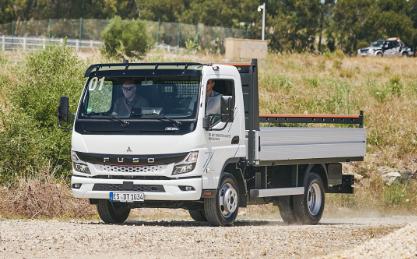
More powerful, more efficient, longer range –plus a wide variety of applications and CO2-neutral in driving operation: this is the essence of the Next Generation eCanter from FUSO.
Following its European premiere at the IAA Transportation in Hanover in September 2022, Daimler Truck subsidiary FUSO is celebrating the start of production of the all-electric light truck in Europe. The event at the FUSO Europe production plant in Tramagal, Portugal, brought together company representatives and guests from politics and business to celebrate the first Next Generation eCanter from European production running off the assembly line.
At the event, Karl Deppen, CEO Daimler Truck Asia, and Arne Barden, CEO FUSO Europe, proudly announced another impressive milestone for the Tramagal plant with the 250,000th FUSO Canter produced on-site.
Arne Barden said: “The team is proud to build the iconic FUSO Canter here at Tramagal, now in its fifth
generation. Thank you to the highly dedicated team who managed the ramp-up of the Next Generation eCanter with flying colours.” The Tramagal plant has produced the FUSO Canter since 1980.
In the run-up to the event, media representatives had the opportunity to experience the
eCanter in 2017, FUSO, the Japanese subsidiary of Daimler Truck, has been considered a pioneer and frontrunner in electric trucks and has been working consistently to implement sustainable transport solutions. There are now more than 550 FUSO eCanters in customer operation in Europe, Japan and the United States, as well as in Australia and New Zealand.
new vehicles at first hand during a factory tour and an exclusive driving event on the Autódromo do Estoril - and the surrounding public roads - to experience the performance of the Next Generation eCanter for themselves. During the driving event, experts from FUSO Europe provided detailed insights into the application versatility of the new vehicle and informed about customised e-mobility solutions.
The Next Generation eCanter: pioneer on the way to sustainable transport
Since the launch of the
The total distance covered by the global eCanter fleet in all-electric and thus locally emission-free mode is now around eight million miles –equivalent to about 200 circumnavigations of the globe. The Next Generation eCanter is now taking this success story to a new level.
Production of the all-electric light truck already started in the first quarter at the sister plant in Kawasaki, Japan.
Kawasaki delivers the FUSO Next Generation eCanter in Japan as well as in all other non-European markets worldwide. In Europe, sales of the FUSO Next Generation eCanter will initially start in 17 markets (France, Spain, Portugal, Italy, the UK, Ireland, Germany, Austria, Switzerland, Belgium, the Czech Republic, Denmark,
Sweden, Finland, Slovakia, Greece and Poland).
In order to meet customer requirements even better, FUSO has made several adjustments to the Next Generation eCanter. While the previous electric truck was exclusively available as a 7.49-tonner with a wheelbase of 3,400 millimetres, customers now have the choice of six wheelbases between 2,500 and 4,750 millimetres and a permissible gross vehicle weight of 4.25 to 8.55 tonnes. The load capacity of the chassis is up to 5 tonnes. The Next Generation eCanter is powered either by a 110 kW (variants with a gross vehicle weight of 4.25 tonnes) or 129 kW (variants with a gross vehicle weight of 7.49 and 8.55 tonnes) electric motor with an optimised driveline and 430 Nm of torque; the maximum speed is 89 km/h (electronically limited).
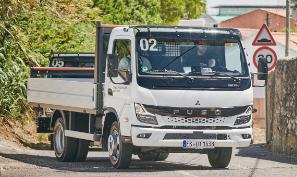
Depending on the wheelbase, three different battery packs are available: S, M and L. The batteries use lithium iron phosphate (LFP) cell technology. These are characterised above all by a long service life and more usable energy. The battery pack in the S variant has a nominal capacity of 41 kWh and enables a range of up to 70 kilometres. In the M variant, the nominal capacity is 83 kWh and the range is up to 140 kilometres. The L variant, as the most powerful package, offers a nominal capacity of 124 kWh and a range of up to 200 kilometres. This is far more than the distance usually covered per day in light distribution traffic.
Recuperation can increase the range even further, while at the same time minimising charging breaks. In comparison, until now the eCanter has only had a battery option with a nominal capacity of 81 kWh and a range of up to 100 kilometres.
As far as battery charging is concerned, the Next Generation eCanter is compatible with all main voltages in the major markets. The charging unit supports charging with both alternating current (AC) and direct current (DC). The Combined Charging System CCS is the charging standard, and charging is possible at up to 104 kW. DC fast charging from 20 to 80 percent of capacity is possible
has among others continuously expanded the use of renewable energy sources and completed the conversion to green power sources.1,200 solar panels on the hall roofs produce up to 350 megawatts of electricity per year. Future targets are to produce up to 600 megawatts of electricity. In addition to expanding photovoltaic systems, the plant is also testing technologies for the local production of green hydrogen.
in approximately 24 (S), 26 (M) and 39 minutes (L), depending on the battery pack. AC charging (11 and 22 kW) takes between around four and six hours, depending on the battery pack.
As part of its overall ecological strategy, the FUSO Europe plant in Tramagal has already successfully reduced its CO2 emissions on a step-by-step basis over the past few years, and by the end of 2022, balance sheet CO2-neutrality in production has been implemented. In order to reach this milestone, FUSO Europe
Reducing water consumption is another measure in the field of sustainability the site is focusing on: its own new water treatment plant already treats more than 60 percent of process water and returns it to the production cycle. At the same time, an optimised rainwater collection system is in the works for more sustainable irrigation of the green areas. FUSO Europe employs around 500 people in Tramagal. The company is the largest employer in the region. From Portugal, the vehicles go to 32 European countries as well as Morocco. FUSO Europe is a major exporter and Portugal’s thirdlargest vehicle manufacturer.
“Made in Europe” for the FUSO Next Generation eCanter does not only refer to the vehicle assembly in Tramagal: more than 50 percent of the electric truck’s components come from over 90 different European suppliers. In line with the production of the all-electric FUSO eCanter, FUSO Europe has also been successively converting its entire internal logistics and warehouse fleet to locally emission-free, electric vehicles since last year.



